MAMS Group Tropic Thunder
INDUSTRY
Carrier: Fred’s Interstate Transport
Feature: Height 4 Hire
Showcase: Brisbane Truck Show Preview
Personality Profile: Ryan Laskey
INNOVATION
Fleet: Gavin Sut ton Transport
High Productivity: SRH Milk Haulage

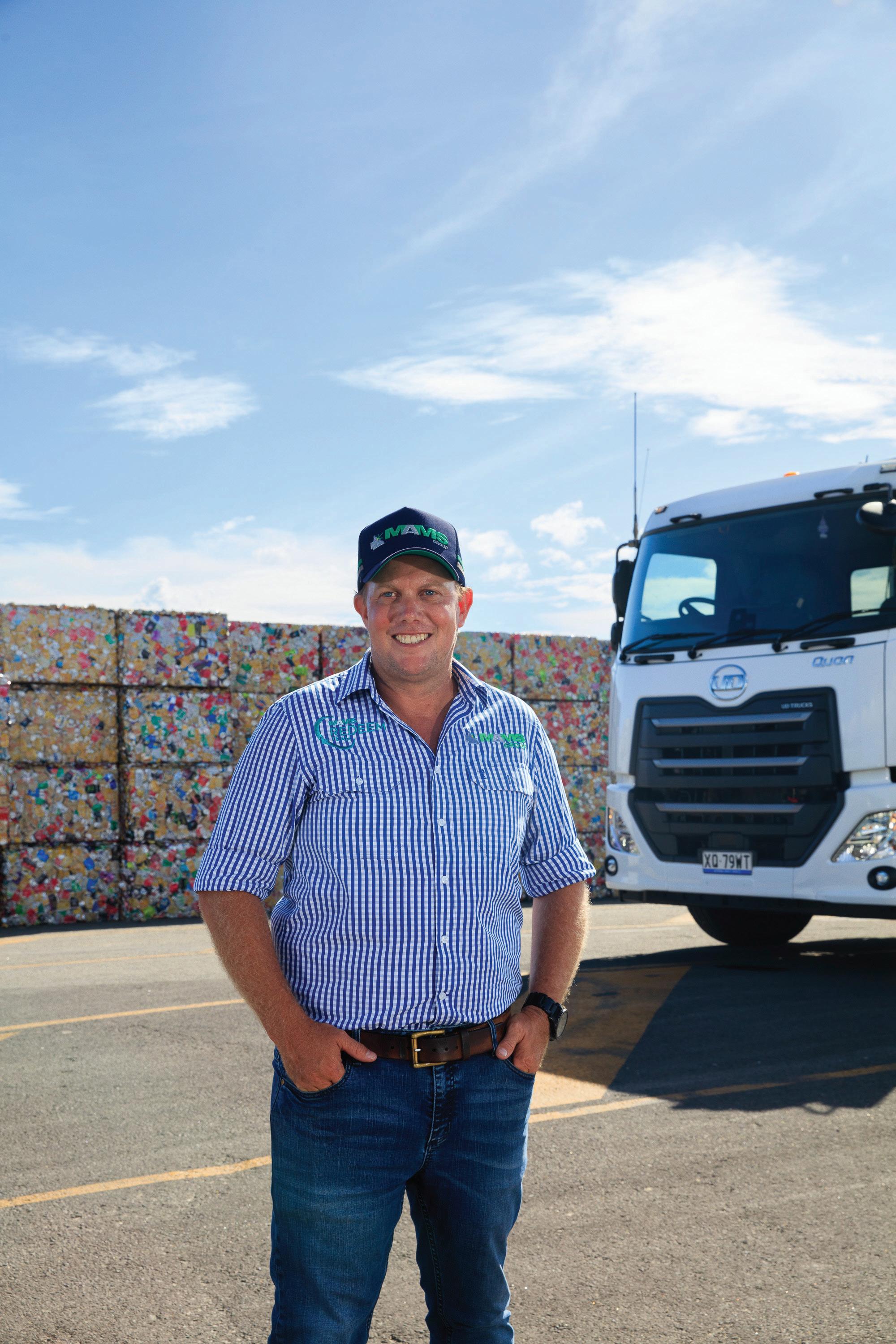
Test Drive: IVECO S-Way
Delivery: Blanc Robot
MAGAZINE Delivery Magazine inside: Pages 105-111. ® May 2023 ISSN 1838-2320 9 771838232000 04 MAY 2023 $11.00 THE PEOPLE & PRODUCTS THAT MAKE TRANSPORT MOVE

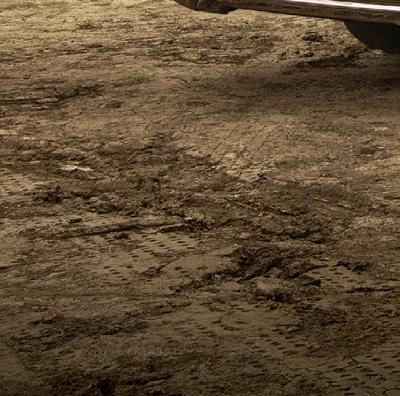
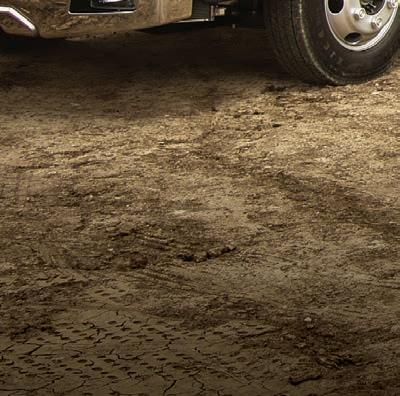







You hear people talk about the “building game”. But it’s no game, it’s serious business. And you need a serious truck to handle bigger payloads. Isuzu Ready-to-Work trucks can carry around a tonne more than a typical ute, most only requiring a standard car licence. And you’ll be covered with Isuzu’s industry-leading six-year warranty. So, stop playing around. Head to isuzu.com.au or visit your nearest Isuzu Truck Dealer now. Warranty is subject to the conditions outlined in the IAL New Vehicle Warranty. 6 year warranty applies to cab chassis only with a 3 year warranty on ready-to-work truck body. For further information please visit isuzu.com.au or contact your local dealer. Children depicted are actors and not actually engaged in workplace activities. FSA/ISZS1462 READY-TO-WORK RANGE Playtime’s over. Visit twusuper.com.au/insurance

































































MEET THE TEAM
John Murphy | CEO
John has been the nation’s foremost authority in commercial road transport media for almost two decades and is the driving force behind Prime Creative Media becoming Australia’s biggest specialist B2B publishing and events company. Committed to servicing the transport and logistics industry, John continues to work tirelessly to represent it in a positive light and is widely considered a true champion for the growth of the Australian trucking and manufacturing industry.
William Craske | Editor
Over the past two decades William has published widely on transport, logistics, politics, agriculture, cinema, music and sports
He has held senior positions in marketing and publicity for multinational businesses in the entertainment industry and is the author of two plays and a book on Australian film history. Like many based in Melbourne he is in a prolonged transition of either returning or leaving.

Peter Shields | Senior Feature Writer
A seasoned transport industry professional, Peter has spent more than a decade in the media industry. Starting out as a heavy vehicle mechanic, he managed a fuel tanker fleet and held a range of senior marketing and management positions in the oil and chemicals industry before becoming a nationally acclaimed transport journalist.
Peter White | Journalist

Having recently completed his Bachelor of Media and Communication (Media Industries) degree at La Trobe University, Peter brings a fresh perspective to Prime Mover. Invaluable experience obtained during his time at upstart, La Trobe’s newsroom, has been supplemented by direct industry experience in a Council placement. Peter is looking forward to contributing to the magazine’s image as the leading publication for commercial road transport with his developed skills.



Ashley Blachford | Business Development Manager
Australia’s leading truck magazine, Prime Mover, continues to invest more in its products and showcases a deep pool of editorial talent with a unique mix of experience and knowledge. www.primemovermag.com.au


Handling placements for Prime Mover magazine, Ashley has a unique perspective on the world of truck building both domestically and internationally. Focused on delivering the best results for advertisers, Ashley works closely with the editorial team to ensure the best integration of brand messaging across both print and digital platforms.
ceo John Murphy john.murphy@primecreative.com.au editor William Craske william.craske@primecreative.com.au managing editor, Luke Applebee transport group luke.applebee@primecreative.com.au senior feature Peter Shields writer peter.shields@primecreative.com.au
business Ashley Blachford development ashley.blachford@primecreative.com.au manager 0425 699 819
art director
Blake Storey blake.storey@primecreative.com.au
design Kerry Pert , Louis Romero, Tom Anderson
journalists
Peter White peter.white@primecreative.com.au
Louise Surette louise.surette@primecreative.com.au
design production
Michelle Weston manager michelle.weston@primecreative.com.au
client success Salma Kennedy manager salma.kennedy@primecreative.com.au
head office 379 Docklands Drive, Docklands VIC 3008 enquiries@primecreative.com.au
subscriptions 03 9690 8766 subscriptions@primecreative.com.au
Prime Mover magazine is available by subscription from the publisher. The right of refusal is reserved by the publisher. Annual rates: AUS $110.00 (inc GST). For overseas subscriptions, airmail postage should be added to the subscription rate.
articles
All articles submitted for publication become the property of the publisher. The Editor reserves the right to adjust any article to conform with the magazine format.
copyright
PRIME MOVER magazine is owned and published by Prime Creative Media. All material in PRIME MOVER magazine is copyright and no part may be reproduced or copied in any form or by any means (graphic, electronic or mechanical including information and retrieval systems) without written permission of the publisher.
The Editor welcomes contributions but reserves the right to accept or reject any material.
While every effort has been made to ensure the accuracy of information
Prime Creative Media will not accept responsibility for errors or omissions or for any consequences arising from reliance on information published. The opinions expressed in PRIME MOVER magazine are not necessarily the opinions of, or endorsed by the publisher unless otherwise stated.
MAMS Group Tropic Thunder Delivery Magazine inside: Pages 105-111. MAY 2023 primemovermag.com.au ® May 2023 THE PEOPLE & PRODUCTS THAT MAKE TRANSPORT MOVE Carrier: Fred’s Interstate Transport Feature: Height Hire Personality Profile: Ryan Laskey Fleet: Gavin Sutton Transport High Productivity: SRH Milk Haulage Test Drive: IVECO S-Way Delivery: Blanc Robot
AUSTRALIA’S ONLY HYBRID ELECTRIC TRUCK
THAT’S ANOTHER HINO

UP TO 20%* FUEL SAVINGS WITH THE SELF-CHARGING HINO HYBRID ELECTRIC.
The Hino 300 Series Hybrid Electric light-duty truck is the perfect solution for your business. Delivering up to 20%* fuel and emissions reductions - with no recharging or range limitations, it has led the way for over 15 years. It’s the first and only light-duty Hybrid truck to meet Euro 6 exhaust emissions standards and customers can also benefit from a 16% reduction in maintenance costs. Driven by Toyota Group technology, experience Australia’s only Hybrid Electric truck that reduces your operational cost to gain a genuine competitive advantage. Harness the Hino Hybrid Electric today! Find out more at hino.com.au

XAVIER_HINO38956.30
*Actual results will vary depending on the application of the vehicle and how it is driven.
COVER STORY

“We needed a cabover and something that was exceptionally manoeuvrable. Most of the other trucks I drove didn’t have a chance of getting into some of these places we need to get into.”
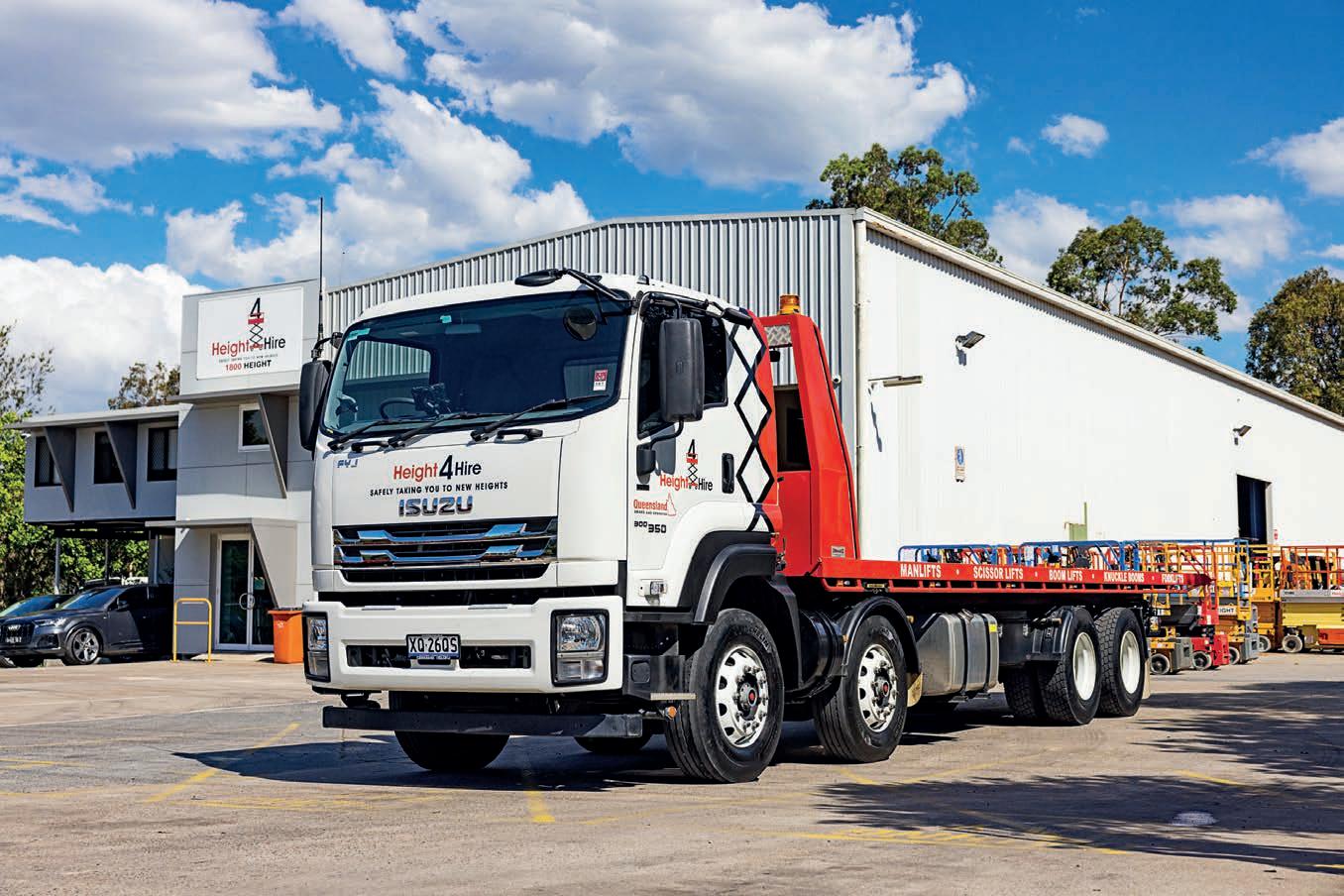

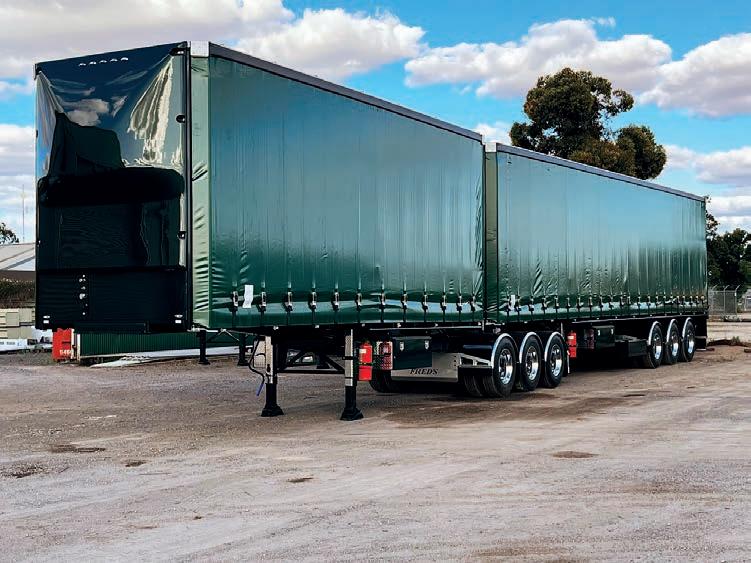


CONTENTS Prime Mover May 2023 100 44 56
68 90
Prime Feature Stories
FLEET FOCUS
44 Tropic Thunder
Waste collection specialist, MAMS Group, covers a vast municipal area in North Queensland the size of a European country. For this it relies on a dedicated fleet of commercial vehicles.



52 Smoke Stack Lightning
Gavin Sutton Transport demonstrates that commitment and agility are vital to create a successful modern transport operation.
56 High Speed Connections
By having its entire fleet fitted with JOST components, Fred’s Interstate Transport has been able to gain an extra advantage in the field of efficiency.
TRUCK
& TECH
64 Think Tank
The SAF-Holland Kompensator fifth wheel is such an application defining piece of equipment in the road tanker category SRH Milk Haulage specify it across the entire fleet.
68 A Tale of Two Technologies
A real-world comparison between diesel-hybrid and current diesel technologies produces some impressive results.
TEST DRIVE
96 Go with the Flow
Following its successful introduction to the European market, IVECO’s latest heavy-duty S-Way range arrives Downunder.
Regular Run
08 From the Editor 10 Prime Mover News 42 Mindset 78 Brisbane Truck Show Preview 100 Personality Profile 102 Prime Movers & Shakers 105 Delivery 112 ARTSA-I Life Members 114 Truck Industry Council 115 Victorian Transport Association 117 T WUSuper 118 Peter Shields’ Number Crunch
SKY HIGH 60
William Craske Editor


Human footprint, a now common phrase in the lexicon, is for some of us, too frequently used in a negative context. As if there were no criterion of cognitive meaningfulness inherited from centuries of exploration dependent on abandoning the comforts of the known physical world. Transport as an industry is a direct descendent of the same pioneering spirit of the Greeks and Phonecians, who expanded global networks in pursuit of trade, land and military supremacy by reaching remote places like Scandinavia and West Africa with technology so unfamiliar, most of it cannot be reproduced accurately today.
The Greeks, as early as 600 BC, had even dreamt up Antarctica. Its name comes from the Greek word “antarktike,” which loosely translates as “opposite to the north.”

By the turn of the previous-to-last century, the dream had become reality for intrepid Australian explorer, Douglas Mawson. Mawson, a member of Shackleton’s Nimrod Expedition to Antarctica in 1909, had been part of the heroic team that discovered the magnetic
Inherit the Wind
south pole. In late 1911, he returned, along with Belgrave Ninnis and Xavier Mertz. Setting up base camp in Cape Denison, where winds often got above 100 km/h, they set forth on a journey 560 kilometres to the southeast near the edge of Mount Glacier. Supplies were already short when they lost a team of dogs down a fissure in the ice 25-feet wide. As they summitted Mount Glacier, the crevasses grew more frequent. To gain some respite from the wind they pitched their tent, unknowingly on top of one. They strolled off to photograph a blue abyss nearby when it opened taking Ninnis with it. They hauled the Englishman out, noting the black space below.
By the 21st November they had trekked 117kms from Winter Quarters, not counting detours. It was a quarter of the total distance the men had hoped for. They were due back at base camp on 14 January when the Aurora would pick them up. At their pace of 11.2kms a day they were going to be short of making the ship. On 14 December tragedy struck. Ninnis was lost down a crevasse with the best of the sledging dogs and supplies. Mertz and Mawson had only crossed it moments beforehand. As the two men made their exhausted attempt back to base camp the lack of supplies meant that they had to eat their way through the remaining dogs.
“We tried to drive the nightmare from









our thoughts,” noted Mawson in his journal. “We strove to forget it in the necessity of work.” Mertz who had been battling bouts of dysentery and depression eventually went insane. He later succumbed to fever and died in his sleep. Mawson, now alone, was still 120kms from the Commonwealth Bay with almost nothing left.
On the 17th January, Mawson falls down a crevasse, and plunges through a snowbridge. Tied to a sledge that had become pinned to the wall, he slides several metres down through the ice. Instead of suffering the same fate as Ninnis, the sledge anchors to the snow, and holds him there as he dangles with his feet unable to touch the edges of the crevasse. He contemplates slipping out of the harness and ending his life. He doesn’t, however. What happens next is extraordinary. For those unfamiliar with the events, it is well worth looking up. It was Seneca who first conveyed the idea that we suffered more in imagination than in reality. To the degree this is obviously true, Mawson might have a dissenting voice. At the very least it puts one at a remove from the new frontiers, which aren’t so much awaiting to be conquered as they are disembodied fears, already in our midst, hungrily conquering the unfit and vulnerable.
8 may 2023





























































































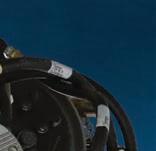


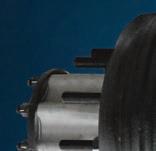

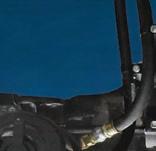




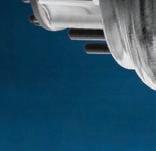





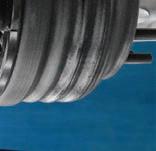





THE NEW D 190 FULL TIME PUMP HAS ARRIVED For more information contact Dana on 1300 00 DANA or visit us at www.Dana.com.au Strength • Power • Endurance ENGINEERED & BUILT IN AUSTRALIA
> Viva Energy lays out $1.15B on retail chain
Viva Energy has announced another acquisition, helping cement its goal of becoming Australia’s leading convenience retailer. The energy company will purchase On the Run (OTR) Group from Peregrine Corporation, a South Australian familyowned business with 205 integrated fuel and retail sites around the country. Coupled with its purchase of Coles Express convenience retailing business for $300 million last September, Viva Energy has added an extra level of diversity away from fossil fuels and is on track to establish more than 1,000 stores across Australia. The acquisition, valued at $1.15 billion, brings Viva Energy the opportunity to include major quick service
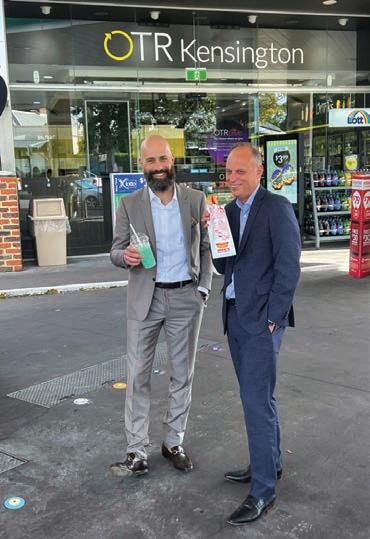
restaurants, such as Subway and Hungry Jack’s, in its retail sites.
As a strategic move, the acquisition will help reduce the company’s dependency on traditional fuels in the face of a growing electric vehicle market.
“We can’t wait to welcome 6,500 OTR team members to the Viva Energy business,” said Viva Energy’s CEO, Scott Wyatt. “We look forward to learning from them and working to deliver a leading convenience offer across the country.”
The deal will see Viva Energy, who run the second-largest oil refinery in the country, become the biggest non-government employer in South Australia.
> Heavy vehicle CoR training grants made available
Chain of Responsibility (CoR) federal grants from a pool of $1.7 million is being invested by the Federal Government to help boost safety across the supply chain. The funding will support businesses who use heavy vehicle transport to deliver tailored training programs focused on the CoR.
Grants will be awarded to projects aimed at educating participants on how to improve the safety of heavy vehicle transport activities. Priority will be given to projects that focus on ‘off-road’ parties in the CoR, particularly for industries where there is a lack of existing training resources. Additionally, preference will be given to proposals that also guide executives to use due diligence to ensure that a business discharges its primary duty.
Successful applicants will be able to access up to $300,000 of funding.
The CoR provision in the Heavy Vehicle National Law ensures all parties that work with heavy vehicles, from the business that employs a driver to the place where goods are
delivered, are accountable for safety. An executive of a business that is a party in the CoR must use due diligence to ensure that the business complies with that provision. The funding will be administered by the National Heavy Vehicle Regulator (NHVR).
Submissions open on Tuesday 11 April and close at 5pm AEST Friday 5 May 2023.
Assistant Minister for Infrastructure and Transport Carol Brown described the funding as an exceptional opportunity for businesses to improve their safety practices.
“The Australian Government is committed to creating a safer heavy vehicle industry, and key to this is an understanding from all relevant parties in the supply chain on how they influence safety,” she said. “This grant scheme will see successful organisations access funding to provide greater training and education in primary duty responsibilities across the sector ultimately delivering safer transport and roads.” Applicants will be assessed against

a range of measures to ensure productive outcomes.
“We are focused on businesses’ capability to deliver quality training, the reach of their audience, their capacity to deliver each project, principles about the primary duty or executive due diligence duty and how each project will address a gap in existing training,” said Brown. NHVR Chief Executive Officer Sal Petroccitto welcomed applications that met the criteria.
“Projects under the CoR grant scheme will need to focus on ensuring the delivery of training to manage risks and hazards in transport activities as required under primary duty obligations,” he said. “All parties in the chain have a responsibility to identify, assess and manage or eliminate risks within their transport activities. We want this funding round to deliver state of the art education across the sector.
“We look forward to seeing tangible, targeted training and education campaigns delivered through this grant.”
PRIME NEWS
10 may 2023
PRIME NEWS
Yasser Shahin, Executive Chairman Peregrine Corp with Scott Wyatt.
ON-ROAD


FOR DRIVERS... THERE’S ONLY ONE CHOICE
With undisputable road presence and trusted reliability, there’s no place you’d rather be than behind the wheel of a Kenworth.
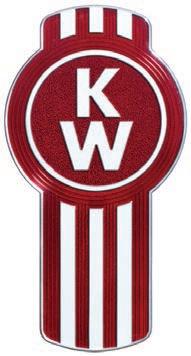

kenworth.com.au
> Separation of law enforcement and data collection proposed
Fair and transparent regulation of telematics was fast becoming a priority to encourage adoption. This is the position of the National Road Transport Association as it relayed its concerns in a submission to a discussion paper on telematics to the National Heavy Vehicle Regulator. According to NatRoad there is a case to be made in keeping law enforcement and data collection separate.
Warren Clark. “In fact, NatRoad has partnered with Teletrac Navman to promote the adoption of telematics by members across Australia.
“We are generally opposed to the use of telematic data, collected under the provisions of the HVNL, for any purpose other than one clearly authorised under the HVNL.
“Of course that doesn’t include private arrangements that are lawfully and transparently done with the consent
> A-double access win following $20M commitment
Heavy vehicles and their freight routes have taken priority with the Federal Government announcing the location of 125 bridges and culverts to get engineering assessments. The key infrastructure, found in 33 different councils around the country, were selected based on their position along key freight routes, and their potential to improve access for heavy vehicles.
The engineering consultants working
on the project will provide the corresponding local government road managers with the bridge and culvert assessments which will help them make informed decisions about heavy vehicle access.
“No bridge or culvert is considered in isolation,” said Assistant Federal Minister for Infrastructure and Transport, Carol Brown.
“Rather, they are selected based on if an assessment may unlock access
“This impedes the significant advances in safety, efficiency and productivity that the widespread adoption could deliver,” he continued. Clark said labour shortages and recent significant weather events made the national freight task more challenging than ever before.
“The challenge is to drive the uptake of telematics with regulation and enforcement of mass and dimension access conditions that is transparent

Trailer Axles and Suspension
Trailer Axles and Suspension
Trailer Axles and Suspension
Intra Series Duratrac Series
Intra Series Duratrac Series
Trailer Axles and Suspension
for more classes of vehicles such as A-doubles, to travel more extensively on Australia’s freight network.”
The funding for the assessments is part of the National Heavy Vehicle Regulator’s Strategic Local Government Asset Assessment Project, supported by the Australian Government’s $20 million commitment to the project which is expected to continue through to late 2024.

PRIME NEWS
12 may 2023
PRIME NEWS
A roadtrain moves through central Australia.
Easily Retrofit to the Popular HOLLAND
FW351E & FW331
Fifth Wheel
FLASHING
RED WARNING LED LIGHTS FOR FAILED
COUPLING
ATTEMPT
HIGH INTENSITY WHITE LED LIGHTS FOR SUCCESSFUL COUPLING ATTEMPT
FAILED COUPLING – In the case of a failed coupling attempt, bright red flashing LED lights assist the driver to quickly recognize a potentially costly mistake.



Robust electrical components: sealed one-piece harness, long-life LED lights, durable inductive sensors, and steel encased logic module ensure reliable operation in the toughest conditions.

SAF-HOLLAND (Aust.) Pty. Ltd

ABN: 79004371215 | Sales: 1300 131 613

Email: sales@safholland.com.au

www.safholland.com.au
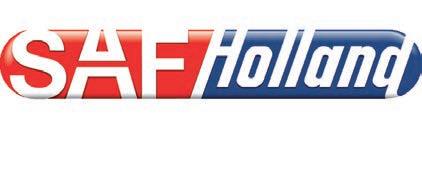
Visit us at the Truck Show STAND 82 FOYER
> Truck simulator launched by Fenix-Newhaul
Fenix Resources launched the world’s first truck driver simulator in April at its Geraldton depot as part of its Kick Start Training Academy for new recruits.
The logistic company’s haulage subsidiary, Fenix-Newhaul, established the simulator to help modernise driver training, respond to driver need for upskilling and maintain a good supply of heavy haulage operators. It will be used in both of the Academy’s programs — Driver Upskill for an existing local mature
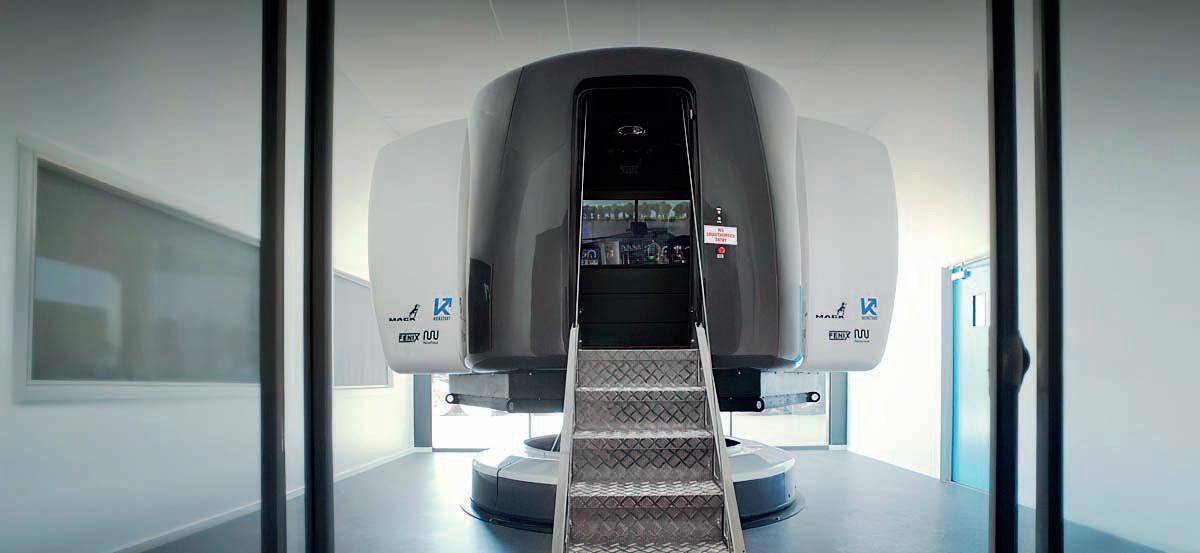
those 18-20-years-old.
The simulator was made possible through a $250,000 grant, with FenixNewhaul among five businesses to share in approximately $700,000 from Western Australia’s Regional Economic Development Grants program.
Kyle Owen McGinn MLC, Parliamentary Secretary to the Minister for Regional Development, joined the attendees at Fenix-Newhaul’s Kickstart simulator launch.
In recognition of Fenix-Newhaul’s interest
> Isuzu appoints new Head of Sales
Following an all-time record truck sales performance last year, Isuzu Australia Limited (IAL) has promoted Craig White to Head of Sales. White’s appointment follows a realignment of IAL’s structure to build efficiencies into an expanding business model.

The broader organisational restructure included the combining of key divisions into a new Sales and Aftersales department, the appointment of Ella Letiagina to Head of Network Development and more recently the promotion of Matt Sakhaie to Head of Product.
Joining Isuzu in 2017, White had a range of experience across the automotive sector before becoming IAL’s National
Dealer Sales Manager in 2017.
In his new role, White will be responsible for developing and managing all aspects of the sales functions and the brand’s off-highway engines under the Isuzu Power Solutions (IPS) banner. With oversight of national and major fleet, including government, and sales through the extensive Isuzu dealer network, White’s focus will be on further developing sales opportunities through customer demand across a wide range of industries.
“I’m really excited for the road ahead and look forward to implementing the strategies of the executive team,” he said. “One of my immediate priorities will be getting out in the field to meet
Midwest, the Kickstart program has also received funding support from the National Heavy Vehicle Regulator’s Heavy Vehicle Safety Initiative.
Mack Trucks Australia Vice President Tom Chapman congratulated the Fenix Resources team on the launch of the truck simulator.
“This will be a fantastic asset for attracting and up-skilling professional truck drivers,” he said. “Well done on taking such initiative to address the critical professional driver shortage.”
with our customers and dealers faceto-face across the country.”
IAL Director and COO, Andrew Harbison, said he was thrilled for both IAL and White.
“The past 12 months has seen incredible sales growth at Isuzu and Craig’s work in the National Dealer Sales Manager position has been a major role in our overall success,” he said. “Craig’s background in both passenger and commercial automotive sales brings a wealth of broader industry knowledge and his understanding of the brand, our customers and our professional dealer network really cemented this crucial appointment.”
PRIME NEWS
14 may 2023
PRIME NEWS
Fenix-Newhaul’s new truck simulator.
We’re on Emission
At Volvo Trucks, environmental care has long been central to our vision of the future. We care passionately about the world we live in, and as the shift towards electric vehicles gathers pace, we are more committed than ever to driving progress.
We are thrilled to have launched our all-electric medium duty truck range for Australian transport operators.
The new Volvo FL and FE Electric medium duty range meet the demand from society and customers for dramatic cuts in CO2 emissions. To simplify the transition to sustainable transportation, the trucks are offered together with service and support packages for electromobility needs.
Come and visit us at the Brisbane Truck Show Stand #49, Hall 3 between 18 - 21st May and learn how we can partner with you in your transition to an electric future.

Learn more by visiting www.volvotrucks.com.au/electrictrucks.
Volvo Trucks. Driving Progress
REMONDIS embark on fleet replacement with Anthem
operators drop the compacted waste into the tippers.
“We have a weighbridge in the tunnel and another on the way out to ensure our loads comply with approved axle mass limits,” explained Collins.
This kind of efficiency in loading is matched at the other end at Swanbank, where the Macks manoeuvre to the edge of the landfill and simply open up the sidetippers to empty them.
“The sidetippers just open up like a big mouth, it’s very cool and they’ve made a huge improvement in our productivity. We used to use trailers with walking floors, but the sidetippers are significantly faster to unload,” said Collins.
As the trucks do most of their travelling on the motorway, the real issue is getting the trailers up to the top of the disposal site.
Waste and recycling specialist, REMONDIS, have begun the process of replacing long-serving trucks in their fleet with new Mack Athems. Since 2014, the Mack Trident has been the truck of choice hauling thousands of tonnes of recyclable materials to processing plants and non-recyclable waste to disposal sites every year.
The fleet is undergoing, as part of a replacement program, a refresh with many of the Mack Tridents coming to the end.
“We’ve got sixteen Tridents from 2014 and two Anthems from 2021,” said Sarah Collins, Resource Recovery Manager at the REMONDIS Swanbank Renewable Energy and Waste Management Facility, which is situated 30 kilometres west of Brisbane. “They’ve been the backbone of our local fleet for nine years but we work them pretty hard, so we’ve decided to start replacing them with Anthems before we wear them out.”
Vice President of Mack Trucks Australia, Tom Chapman said the Mack Anthem is a natural and exciting progression for REMONDIS in renewing and improving the efficiencies of their fleet.

“The Mack Anthem has built a strong reputation for itself in terms of fuelefficiency. Paired with mDRIVE-HD with
deep reduction gears, the benefits are compounding in applications such as this one where controlled manoeuvrability on sometimes uneven, steep or low traction surfaces is critical,” said Chapman.
“For us, success is really forged in the strong relationships we build with our customers. REMONDIS perform the waste removal functions of both our factory and Head Office operations at Volvo Group Australia, so there’s great trust in the partnership and it swings both ways.”
The trucks travel between the Swanbank site and transfer stations at Rocklea and Northgate, making up to six trips a day, five-and-a-half days a week. Averaging about 60,000 kilometres a year, the Macks are hauling single trailer and B-Double payloads in sidetippers, with net weights approaching 36 tonnes.
“The fleet is NHVAS Mass and Maintenance Accredited and is enrolled in IAP so that we can operate Higher Mass Limits (HML) so we’re maximising our payloads on every trip,” said Collins. Commercial customers bring loads of waste to the transfer stations, where they’re compacted and loaded onto the trucks. At the transfer stations the trucks drive into the loading tunnel at the end of the pit. It’s here where REMONDIS
“It’s a steep slope, and if the weather is bad it can take a lot of low-end torque to get the load up there,” continued Collins.
“The Anthems don’t have any trouble at all. The mDRIVE-HD with an extended range of deep reduction gears, is ideally configured to climb steep slopes – a key safety consideration for us – so they’re more than up to the task. They’ve also proven to be fuel-efficient, which is increasingly important to the business.”
As the trucks only do day trips, the Anthems don’t require a sleeper cab but come with Mack’s full Safety Pack.
“Our drivers spend a lot of time in them, and VGA delivered a complete product, fully outfitted. Our drivers are really chuffed with the new Anthems and are happy we’re buying more of them,” said Collins.
With five scheduled for delivery in 2023, the Mack Anthems will soon be a familiar sight on the highway.
“We’ve been using Volvo Group products in southeast Queensland for over 20 years now and they’ve proven to be reliable and an ideal fit for the task,” said Collins. “We’re looking forward to bringing the rest of the new Anthems into the local fleet and enjoying the continued support of Volvo Group Australia.”

PRIME NEWS 16 may 2023 PRIME NEWS >
Luke Barnes, Volvo Group Australia hands keys to Robert Mason Operations Manager, REMONDIS.



> JATEC Transport announces scholarship program
NSW carrier, JATEC Transport, has launched a scholarship program to bolster its driver talent pool. The program, launched earlier in the month, is expected to bring a range of benefits to the business as it navigates the challenges of the current labour market. Finding new, innovative ways to attract quality drivers was a prerogative according to Caitlin Barlow, JATEC Transport Business Development Manager.
“For a while we have been discussing a feeder program where we can bring HR drivers into the business and train them the JATEC way,” she said. “This means they are competent in driving, customer service, chain of responsibility requirements, legislation and fatigue management.”
It was the perfect time to launch with a Volvo FH99 rigid now available in the fleet. Successful applicants will start in the rigid truck where they will gain experience

and knowledge in JATEC operations and expectations before the company invests in their upgrade to heavier applications.
Conditions of entry to the program include a minimum of 12 months Heavy Rigid experience, and the ability to drive a synchro gearbox.
JATEC intends for drivers to spend around two months in the rigid to complete a comprehensive training program before they are enrolled into a driving school to upgrade their licence to Heavy Combination.
“By having a shorter induction period we hope to provide this opportunity to multiple applicants as candidates progress,” said Barlow.
Applications are now open with range of people having already applied according to Barlow.
At present there is no baseline of driver numbers in place.
As the business grows operations the expectation, at this early stage, is that
it will be able to continue the program indefinitely.
“The transport industry is ageing, we are acutely aware of this, and so we hope to attract young people through the program,” said Barlow, who recently was awarded the Emerging Leader by the Road Freight NSW. “We are looking to contribute to the longevity of the industry. In saying this, if there are applicants outside this demographic who are overtly interested in the program and looking to join the team, we are open to everyone.
“JATEC Transport is always willing to give anyone with the right attitude a go.” Barlow, over the past 12 months, has assisted Transport Women Australia Limited in their career initiatives in NSW. One of the initiatives has been the EDGE Program, which helps young people enter the workforce with confidence through online courses and interactive workshops.
As the Transport Industry representative, Barlow has attended workshops and spoken with students about considering the transport industry as a career. This work, which caught the attention of RFNSW, has involved visiting high school career days and markets to raise awareness about the transport industry and point high school students in the right direction should they be interested. “Whether this be driving, heavy mechanic, insurance, sales etc I am able to recommend pathways and put them in touch with potential employers,”
Barlow said the acknowledgment she received from the RFNSW conference and Emerging Leader award is a definite career highlight for her.
“It was gratifying to be nominated by Transport Women Australia Limited for my contribution, and to then win the award I was ecstatic,” she said. “It was a proud moment to represent TWAL. The achievement was made even more special by having my parents there, and that’s the beauty of being in a family business.”

PRIME NEWS 18 may 2023 PRIME NEWS
Caitlin Barlow accepting her RFNSW award.
Proven Concept.
Meet the DAF XF – its proven 530HP MX-13 engine offers the perfect balance of power and efficiency.

When you’re driving coast to coast, the DAF XF is a quieter and more comfortable place to work, live, and sleep.

DAF XF PURE EXCELLENCE
Get into a DAF today!
WWW.DAF.COM.AU/XF Discover DAF XF
> Roadtrain innovator at the crossroads
An independent assessment of the financial position of Rivet Mining Services (RMS) is currently underway by receivers EY and FTI Consulting in the wake of the bulk haulage specialists’ recent demise.
The firm, chaired by ex-Toll executive Mark Rowsthorn, entered administration last month, according to Australian Securities and Investments Commission (ASIC) documents.

A provider of transport services to miners in Western Australia, Rivet had been carrying base metals in the Pilbara and Kalgoorlie goldfields, loading and hauling lithium, iron-ore, manganese and gold ore across its fleet of roadtrains.
The heavy vehicle fleet, utilising quad roadtrains, super quads and quin 60-metre multi-trailer combinations, had built a reputation on pushing the envelope on mass loads and payloads having eclipsed 200 tonne gross masses in partnership with key suppliers, Kenworth, JOST and Mack among them. Unfavourable inflationary financial pressures, labour shortages and a series of adverse weather events that led to costly project disruptions brought to a head the precarious viability of the Perth-based Rivet leading receivers in April to seize control of Rowthorn’s holding company, Blondie Trading.
“RMS will continue to trade on a business-as-usual basis while the Receivers conduct an independent assessment of its financial position and seek to sell the business as a going concern,” FTI Consulting said in a statement it issued to media. The appointment of receivers relates only to the mining services business, with other entities of the Rivet Group continuing to trade in their usual manner. While receivers attempt to sell the business as a going concern, the latest accounts lodged by Blondie Trading reported earnings of $82 million and a net loss of $6.6 million for the year ending to June 30, 2020.
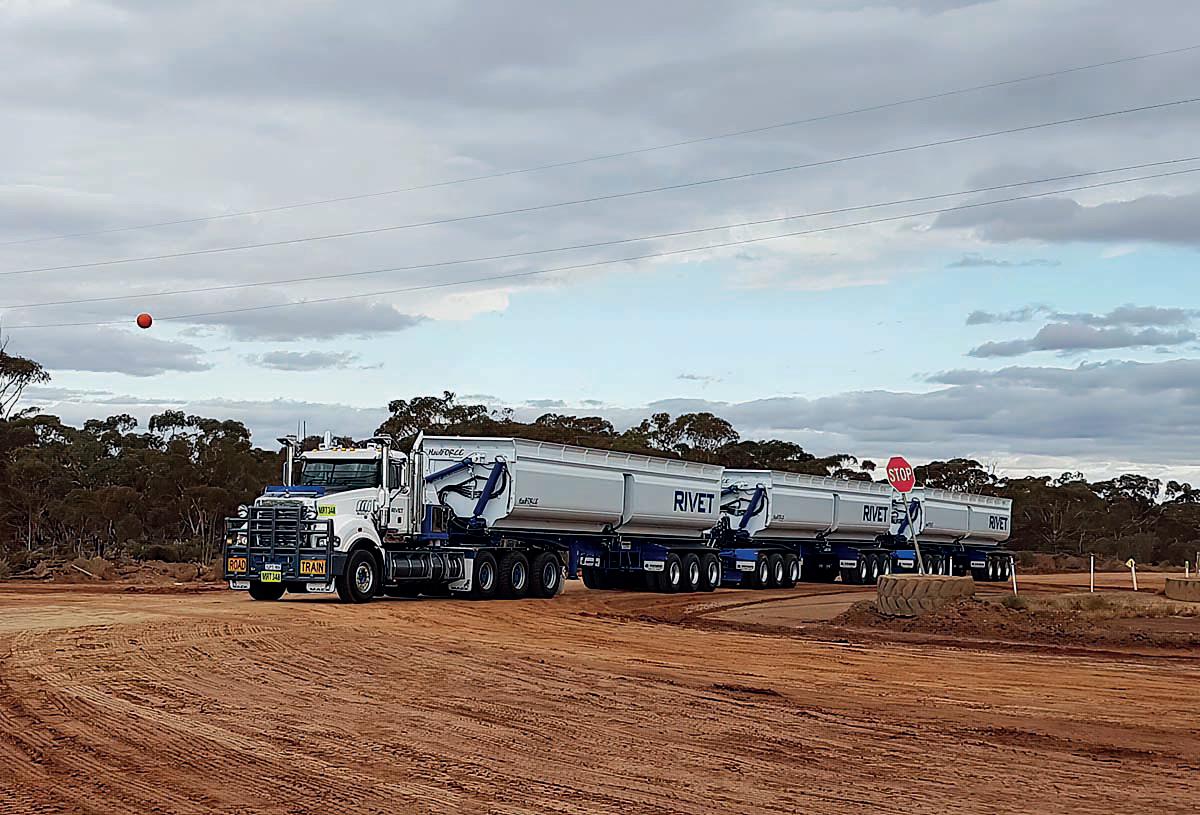
PRIME NEWS PRIME NEWS
20 may 2023
One of Rivet’s unique multi-combination roadtrains in Western Australia.
Optimize your fleet with data-driven insights and AI powered by the #1 global telematics provider.
One platform for connected and sustainable fleet performance.
Geotab’s AI-driven platform transforms real-time data from any source into actionable insights that provide measurable business value, help reduce fleet’s emissions and costs while improving operational efficiency. Optimize your fleet’s performance and stay ahead of the competition.
geotab.com.au

> Outback operator builds on the back of UD partnership
Kununarra-based JSW Holdings has grown from brickmaker to remote infrastructure specialist. For almost 50 years the company has been running trucks in an environment that is as beautiful as it is challenging. The scope of the business incorporates concrete, plant hire, civil contracts and aggregate supply in partnership with UD Trucks.
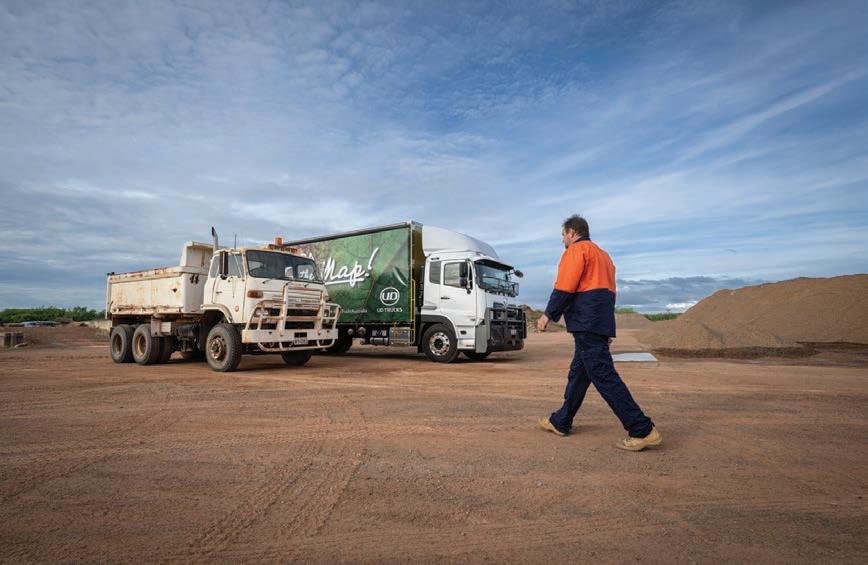
That trust and confidence in the UD truck products has been ongoing given the desolate and challenging conditions.
“Probably the biggest pressure is our isolation with parts supply and getting and keeping things running,” said JSW Owner Peter Woodhead, who needs to have a strong inventory of backup parts on hand.
“People are also a big shortage. I know we’re not alone with that but it’s pretty hard to entice people to come up and live in extreme conditions at the moment,” he said.
In winter, weather is idyllic, hovering between day time temperatures of 25 to 30 degrees. But that all changes once the wet season arrives according to Woodhead, whose father founded the original brick manufacturing business in 1975.
“From November until April it’s 40 degrees, wet and an afternoon shower can see 25 to 50ml of rainfall,” he said. “Roads become impassable, so we’ve got to be careful where we go and don’t go, depending on the time of year.”
JSW currently have five UD Trucks in their fleet for a total of ten purchases from the brand all up.
“Our business was built on them,” said Woodhead, who along with his brother joined their father at the company once they had finished high school.
“What I like about UD Trucks is that they’re built solid, reliable, low maintenance, easy to drive and are comfortable,” he continued. “Our guys love driving the UD Trucks and out of all the vehicles in our fleet they
probably spend the least amount of time in the workshop.”
Distances travelled by the fleet annually can vary due to the kind of work required of it. These range anywhere from 100,000kms to 250,000kms.
“Engine hours are probably more,” said Woodhead. “It’s a lot of work off road on dirt roads so we generally reach speeds of 40 to 50kms per hour.”
Despite these locational challenges, Woodhead said his UD Trucks have provided a solid and reliable platform to keep JSW running and with minimum downtime. A 1983 UD CW40, the very first UD vehicle JSW bought, is still in operation for the business today.
“It was purchased as a 6-wheel tipper. The customer decided they wanted to go to a semi so it was converted to a prime mover and towed a bogie tipper around for probably five years of its life and then as things got bigger, we converted it back to a tipper,” recalled Woodhead.
As part of Lap of the Map, an initiative launched by UD Trucks, to customers in less central locations, Woodhead
was full of praise.
“I think the UD Trucks Lap of the Map is an awesome incentive.” he said. “We get to have a look at these trucks in person. We’re fairly remote so we don’t get to go down to the dealer often and see what’s new and what’s out there so it’s really good for companies like ours.”
Vice President of UD Trucks Australia, Lauren Pulitano described the journey of JSW Holdings over the decades as unique and inspiring.
“Considering JSW Holdings was established nearly 50 years ago and has been able to thrive in such a remote and extreme part of Australia, it is truly a testament to the entrepreneurship and strong leadership of Peter and originally, his father,” she said in a statement. “Our UD Trucks are built to sustain the unique and demanding conditions of Australia and to hear of a remote business like JSW building their business on UD Trucks that is extremely humbling. The story of JSW is truly one that UD is proud to be a part of and we thank Peter and the JSW team for continuing to put their trust in UD Trucks all these years on.”
PRIME NEWS
PRIME NEWS 22 may 2023
Peter Woodhead at his depot.

This information is general advice only and does not take into account your objectives, financial situations or needs. You should obtain and consider the relevant Product Disclosure Statement and Policy Wording (as applicable) from zurich.com.au before making a decision. A target market determination is available at zurich.com.au/GI-TMDs or by calling us on 132 687. The issuer of general insurance products is Zurich Australian Insurance Limited (ZAIL), ABN 13 000 296 640, AFS Licence Number 232507 of 118 Mount Street, North Sydney NSW 2060. ZU233775 V4 12/22 LEWG-019393-2022 Much more than truck insurance. Zurich seeks to improve safety in the trucking industry through its fleet risk management services. We work closely with customers on request and aim to optimise business processes and driver behaviour. This can help to reduce claims, keeping trucks on the road. Ask your broker about Zurich today.
> Mercedes-Benz to debut eActros at Brisbane
for sustainable road transport in our region,” he said.
electric truck, will make its Australian debut at this month’s Brisbane Truck Show. The long-awaited vehicle is focused on heavy-duty, short radius distribution with development trucks having been put to work in select fleets
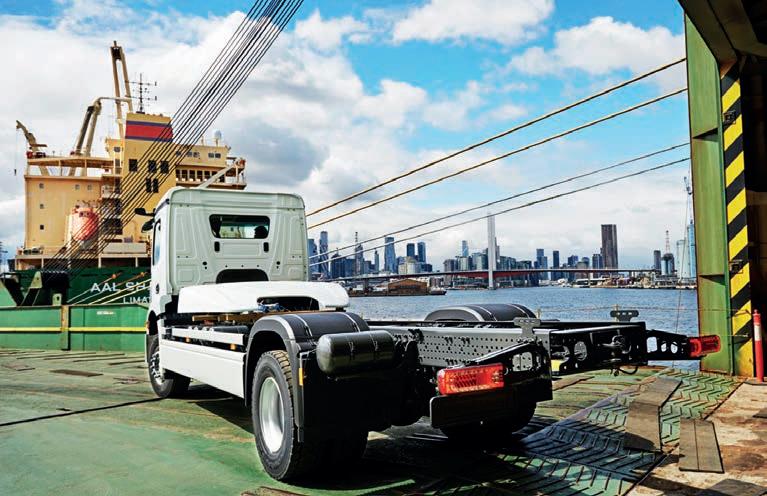
Benz Trucks Australia Pacific Director, Andrew Assimo, said he looked forward to presenting the heavy-duty electric truck to the Australian public.
“The local debut of the eACtros represents the start of a new chapter
> Booth Transport leader mourned
Booth Transport Director, Brian Booth, has sadly passed at the age of 79. Booth Transport was founded in 1936 by Brian’s father, Lindsay Booth, with just a single vehicle which transported wine and farm goods south of Adelaide.
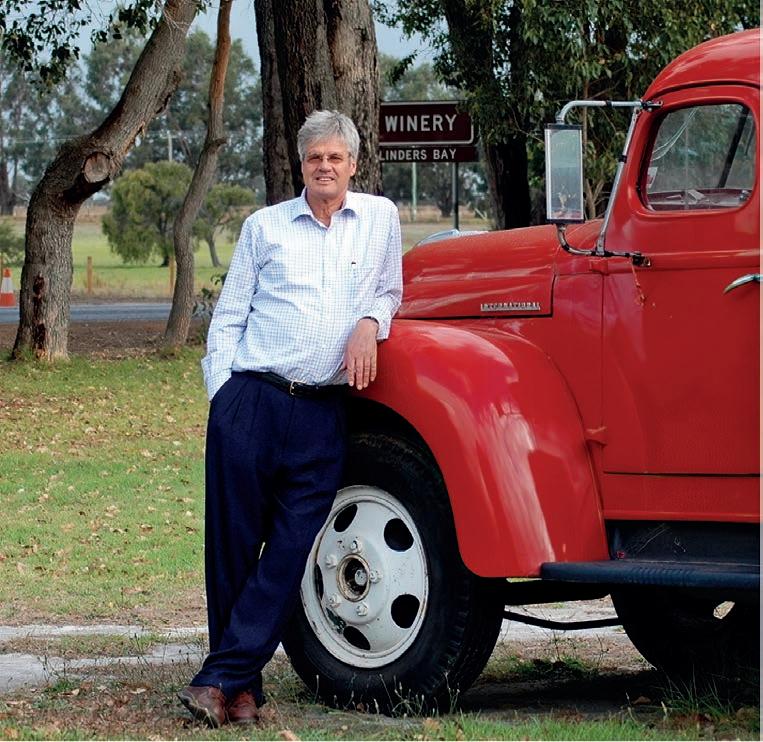
Booth joined the company in 1958 and played a key part in the fleet’s growth to become a leading carrier of bulk food, container transport and logistics today. Due to this growth, Booth Transport now has a fleet of 270 commercial vehicles nationwide along with depots in every state.
The long-standing company is now run by the third generation of the Booth family. Booth Transport CEO, Nathan Falconer, extended his condolences.
“He was proud of the where the business is today, and he was excited about the possibilities in the future,” he told Prime Mover
“Whenever Brian travelled to a depot, he always made time to engage with staff. Leaning against a bullbar of a prime mover, talking, and listening to a driver was a common sight.
“He was always the first to be on any meeting, and he would say, if you’re not 15 minutes early, you are late.”
Booth Transport has been active in dairy transport since the 1990s when

it diversified the business with the purchase of a Deniliquin-based milk transport company. Operations have since grown to see linehaul tankers of milk and dairy
A local validation program is also expected, designed to ensure the vehicle specification is tailored for Australia’s unique conditions, as well as to meet the specific requirements of local customers. The program will include four eActros trucks in Australia and one in New Zealand. The company is quick to point out, however, that although they are keen to move forward with battery electric technology, they are committed to providing solutions to help traditional internal combustion engine customers drive down their emissions as well.
products travel up and down the east coast of Australia, in addition to the handling of interstate containers from the port in Devonport to Melbourne and also from Melbourne via rail into Perth.
PRIME NEWS PRIME NEWS
24 may 2023
Mercedes-Benz eActros lands in port.
Brian Booth.


www.omfbpacific.com OMFB Pacific Pty Ltd Phone: 1300 040 600 Email: sales@omfbpacific.com •Power Take-Offs • Gear Pumps • Piston Pumps & Motors •Control Valves • Control Systems • DC Powerpacks •Oil Tanks • Hand Pumps • Winches, and more... Backed by dedicated local product support and expert technical knowledge and assistance we’re focussed on providing the most durable solution for your on-road application. With over 70 years of innovation and thousands of customers in over 100 countries, OMFB has become a worldwide manufacturing leader of hydraulic components suited to Transport, Agricultural, Mining, Industrial, Marine, Oil & Gas and Mobile applications. Complete Hydraulic Solutions Tippers Bin trucks Vacuum trucks Truck-mounted cranes Waste management trucks
> Eurocold launches electric truck company
Refrigerated truck assembler, Eurocold, has launched a refrigerated electric truck division. The offshoot known as Revora will be based in Brisbane, Queensland. Revora will reportedly use the knowledge built by its Founder and Managing Director, Avraam Solomon through three generations in the refrigerated transport industry, along with the expertise in the low-to-zero emissions space brought by General Manager, Nathan Gore-Brown. The stated goal of the company is to help move the refrigerated transport industry towards a sustainable future.
Key components such as chassis and fridge, body will be sourced from “best of breed” operators in Australia and internationally.
Gore-Brown comes to Revora with an extensive automotive background from Aston Martin in the UK. He launched Tesla’s initial flagship Brisbane outlet and more recently was a Senior Consultant to government and private sectors on transport decarbonisation with advisory agency, MOV3MENT. The first refrigerated electric truck will be on display at the Brisbane Truck Show, May 18-21.
“Revora is a completely separate and new brand to Eurocold – aimed at future-proofing the sustainability of the refrigerated transport industry,” said Avraam Solomon. “Revora will be Australia’s first fully integrated, electric refrigerated truck fleet supplier.” The program, being headed up by GoreBrown, will assess fleet suitabilities to embrace electrification before assisting customers into the crossover. The trucks and energy solutions will be all on a long-term lease with Revora. To optimise efficiency once going electric, Revora is devising a technology-led process that will assist fleet owners to ensure they are maximising opportunities through telematic data tracking on the vehicles and software to monitor energy systems. “Avraam has the vision to provide a sustainable future for the refrigerated transport industry through establishing a line of highly efficient, cutting-edge green transport solutions. Our customer base, partners and alliances are in third party logistics, broadline food services, along with the meat, seafood, dairy and produce industries,” said Gore-Brown. With the majority of refrigerated

transport deliveries being ‘last mile’ deliveries and in urban areas, GoreBrown explained that electric trucks are perfect for this duty cycle.
“EVs are particularly well suited to urban and stop-start tasks,” he said. “This is down to their ability to recapture energy through regenerative braking. Typically, the refrigerated transport industry has a large portion of the fleet running last mile delivery and that’s where electric trucks excel.
“In addition to this, as we move towards government-mandated net zero emission targets, electric trucks will provide opportunities for our customers to gain new contracts due to businesses wanting to reduce their carbon footprint.”
Revora’s offering includes initial consultation on current fleet makeup and measurement of diesel usage; suitability to cross over to electric refrigerated trucks; supply of optimised zero-emission refrigerated commercial vehicles energy/charging stations (optimised for fleet size and operations model) staff training; and oncall support.

PRIME NEWS PRIME NEWS
26 may 2023
Revora electric truck concept.


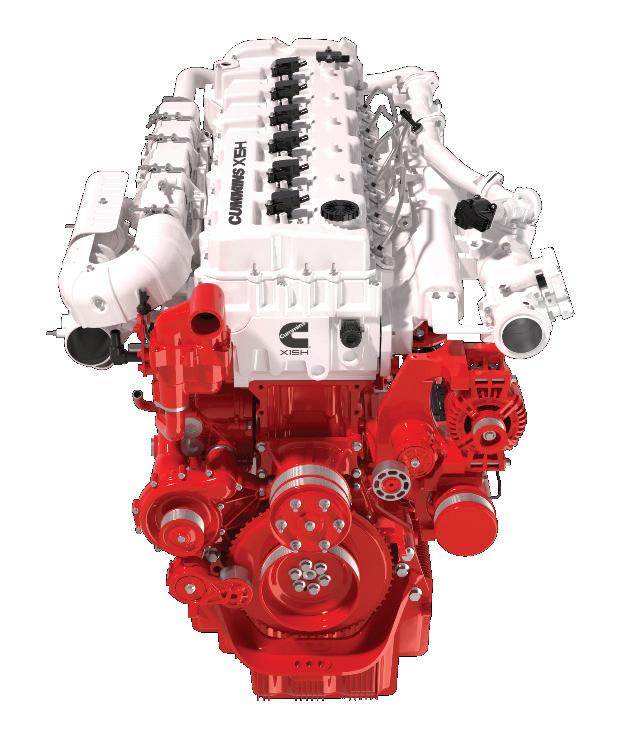




> Spudshed aligns with UD Trucks in Perth
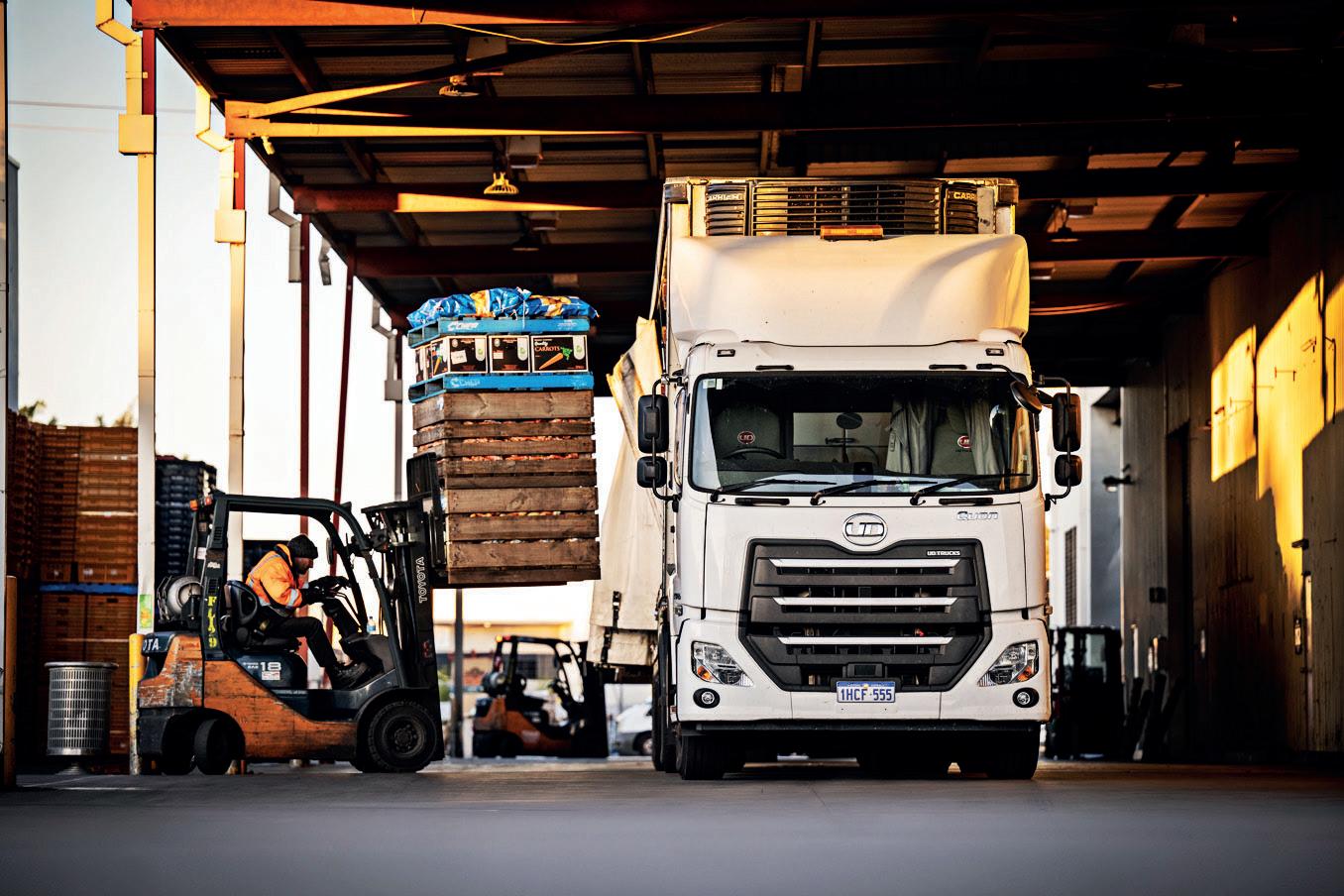

Western Australian supermarket chain, Spudshed has undergone a serious period of growth in recent years. An ongoing relationship with UD Trucks, for whom it has purchased 17 commercial vehicles to date, has helped it build its brand and footprint, harvesting and delivering fresh, locally grown produce to Perth where it operates 17 retail stores offering a large range of quality produce including meat, dairy and groceries.
With farms spanning all the way from Manjimup up to Kununurra, and more than 1100 Spudshed employees to see through business operations, the Galati family business has become a key identity in Perth.
From the beginning, the business philosophy for Spudshed was simple in bringing down the cost of weekly shopping and making healthy fresh produce affordable for the people of Perth.
Decades on little has changed.
Owner Tony Galati and his brothers Vince and Sam, grew up helping their Sicilian parents run a two-hectare market garden that was established in Spearwood in the 1960s.
By 1998, a simple farmer’s market had evolved into Spudshed and the business has since bolstered itself into the multimillion-dollar operation that it is today. With rapid expansion comes the necessity for reliable and efficient transport in getting food delivered to their stores consistently and on time. At the Canning Vale depot Spudshed moves between 400 – 500 pallets daily. The trucks are loaded every morning according to Galati.
“You don’t realise how much is involved in getting produce to a retail store or to the markets – and if you don’t have the reliability of your trucks, you’re in trouble,” he said.
Reliability was one of the main factors
that steered the family towards UD Trucks after time spent researching the products.
The majority of the fleet comprises UD Quon GW26 460s. Spudshed’s trucks typically travel between 600 to 700 kilometres a day, and close to 1200 kilometres during the busier season, making reliability a non-negotiable.
“We bought one truck and then another one and now we’ve got 17 UDs at this stage and we’re looking at buying a few more,” said Galati. “They’re great on fuel efficiency and for the horsepower they’ve got and for the tonnage we cart, they’re really good. Probably the best in the market that I’ve seen.”
It’s been a bonus for Galati that his drivers enjoy driving the UD Trucks every day.
“The air-conditioning, the driving, the way they steer, the way they handle the road – they’re really happy with the trucks. I tell some of my drivers that they should be paying me for driving these trucks,” he said.
Spudshed also runs a nursery where it propagates all of its own seedlings.
“We virtually plant them from the seed, then six or seven weeks after being in the nursery, we put them out in the fields and grow them out over ten to 12 weeks,” said Galati.
After they have been picked they are brought to one of the packhouses where they will eventually be dispatched to markets, chain stores, Spudshed or exported.
The success of Spudshed, despite being in an industry known for challenges, is dependent on a series of factors according to Galati.
“For us, success in the business is what you put into it. You’ve got to nurture your business, you’ve got to live in it,”
“I’ve been in the game since I was a young kid and grew up on it. And my kids did the same thing. They grew up in it, they were born into it.
“It’s a family business and we do it to the best of our ability.”
PRIME NEWS PRIME NEWS 28 may 2023
UD Quon GW26 460hp being loaded up in Perth.
Safety. Performance. Comfort. ALL THE WAY
The new IVECO S-WAY range takes the on road and liveability experience to the next level.
Drivers enjoy a SAFER driving experience with world class driver assist technology. The S-WAY cab’s improved aerodynamics maximises the fuel efficiency without compromising the PERFORMANCE. The driving ergonomics and cab have been reimagined and designed for supreme COMFORT.
S-WAY makes tomorrow safer, more productive, and even more comfortable.

iveco.com.au Drive the road of change
Fujian Motor range of heavy-duty hydrogen trucks bound for Australian distributor HDrive has taken place. The vehicle was recently shipped from the Zhangzhou Development Zone.

Present at the ceremony were Liu Yongxiang, Deputy Secretary of the Party Committee of Zhangzhou Development Zone and Executive Deputy Director of the Management Committee, Scott Brown, Managing Director of Pure Hydrogen in Australia, Jason Pecotic, Managing Director of HDrive in Australia, and the Economic Development Bureau of Zhangzhou Development Zone.
“We are pleased to cooperate with Wisdom Motor. Currently, countries around the world are striving to achieve carbon neutrality, and the demand for green travel is increasing,” said Pecotic. “We hope to work with Wisdom Motor to create a high-efficiency and lowenergy consumption green smart manufacturing path.”
In November last year, Wisdom Motor signed a memorandum of understanding with Pure Hydrogen and HDrive in Australia to deliver 12,000 hydrogen-fuel heavy-duty trucks over the next five years.
will be the first hydrogen fuel heavyduty truck to be delivered after the agreement was signed.
Its hydrogen fuel cell system delivers 110-400kw of power and a range of up to 1,000 kilometres. The vehicle, which is being marketed as an ideal intercity freight and provincial long-distance transportation solution, derives power from Ballard Power fuel cell stacks, and relies on an integrated control system with what Wisdom has described as a “360° multi-sensor fusion perception system.”
The body adopts a patented annular gantry beam with full load-bearing structure in addition to high-strength stainless steel and composite materials. With the streamlined design of a ventilated motorcycle helmet, the fluid sculpture of the cab achieves a modern aerodynamic look.
The OEM claims the fibre body covering technology has helped reduce its weight by 10 per cent compared to similar products on the market.
The interior is driver-centric and is defined by a homely concept design with a cockpit conceived as an “intelligent mobile home”.
In addition to a wrap-around centre

instrument cluster, and multi-function steering wheel, it also comes with a massage seat.
Wisdom Motor is confident the truck can have a service life of 20 years.
“Wisdom Motor will work with its partners HDrive and Pure Hydrogen in Australia to lead the innovation of zero-emission commercial vehicles with world-leading new energy technologies, better serving our customers in Australia and around the world,” it said in a statement.
In 2022 HDrive became the first company in the world to deliver hydrogen fuel cell coaches for Fortescue Mines in Western Australia. In March of last year, Pure Hydrogen announced that it would provide JJ Richards & Sons, Australia’s largest privately owned waste management company, with a hydrogenpowered waste truck and hydrogen refuelling services.
Beverage giant, PepsiCo, is anticipated to begin a trial of the hydrogen-powered truck jointly designed by HDrive and Wisdom Motor in Brisbane later this month as it evaluates commercial use cases for the fuel cell vehicles in Australia.
30 may 2023
HDrive executives attend handover ceremony in Zhangzhou, China.


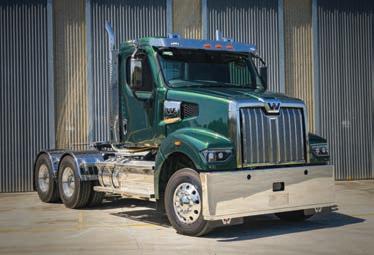
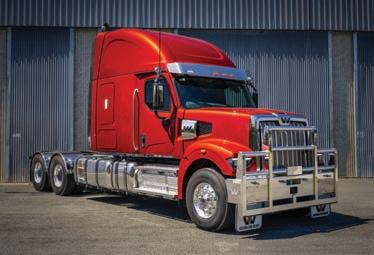






































































> Port Lincoln freight route improvements get greenlight
A key freight route in Port Lincoln, South Australia will receive important upgrades as part of the latest Federal Government funding release. The upgrades are aimed at increasing safety outcomes and productivity for heavy vehicle operations in the region. The intersection of Porter Street, Liverpool Street and Railway Place, at the end of the Lincoln Highway, will receive traffic signals, a dedicated right-hand turn lane, improved drainage, widening and pavement works. “Investment in segments of our roads which are well-utilised by heavy vehicles has never been more important, with many of our communities grappling with ongoing flooding and tightening supply chains,” said Carol Brown, Federal Assistant Minister for Infrastructure and Transport.

The $3.6 million put towards the project comes from the Heavy Vehicle Safety and Productivity Program which has committed an ongoing $65 million per year to state, territory and local
> Centurion champions regional road safety in WA
Thirty Centurion trucks are on tour across Western Australia to promote the Road Safety Commission’s latest campaigns. The sides and backs of the trucks will display the campaigns ‘Don’t drift off’ and ‘No one plans a crash’. Every year approximately two thirds of the state’s road fatalities occur in regional areas and 2022 was no different, with 64 per cent of people who died on

48 per cent of fatalities. While there are many factors that can cause a vehicle to leave the road, fatigue can and does play a role.
At 13 metres in length, the trucks will be highly visible to regional drivers as they transport groceries and other essentials from Perth to the north of the State. They will be on the road during the busy April school holiday period and visible to
governments. This builds on the Federal Government’s $140 million commitment to upgrade heavy vehicle rest areas over the next ten years which is expected to begin later this year.
distances for the eclipse, particularly those not familiar with WA roads, the Road Safety Commission recently launched its ‘Welcome to Country Roads’ campaign. The campaign is a collaborative effort with Aboriginal Elders which celebrates the connection First Nations people have to their Country and provides drivers with tips for a safe journey through it.
“This partnership with Centurion is a fantastic visual way in which to share our latest road safety messages where they are needed most — our regional roads,” said Road Safety Minister, Paul Papalia.
“These trucks will serve as a mobile road safety reminder for drivers while they are behind the wheel. We’re asking drivers to be warned against fatigue and to be mindful of other behaviours that can lead to a crash like using a mobile phone or rushing to overtake.
“Road safety is everyone’s business, and this is a great example of how the private sector and Government can work together to reduce deaths and serious injuries on our roads.”
PRIME NEWS PRIME NEWS
32
A bend in the highway to Port Lincoln in South Australia.
Paul Papalia, Road Safety Council Chair Katie-Hodson Thomas and Centurion CEO Justin Cardaci.
THE CONNECTED TRUCK
The Connected Truck is transforming the way our teams work by bringing real-time visibility and information to the workplace. This technology enhances not only our driver’s safety with fatigue and maintenance tools, but also promotes sustainability through fuel efficiency and effective job management.

Scan the code to find your way to us!

Stand 104, Hall 4
1300 111 477
TeletracNavman.com.au
> McGrath Newcastle endorses new Freightliner fleet
A Newcastle container hauler has sung the praises of its latest additions — four Cascadia prime movers. After encountering a supply issue with another truck brand, Tony McGrath, who runs McGrath Newcastle, turned to the Freightliner Cascadia, a vehicle he hadn’t considered previously. The first Cascadia, purchased through Daimler Trucks Newcastle and salesman, Phil Mason, performed so well McGrath has since ordered three more.

McGrath Newcastle now has four 126 Cascadia models in the fleet, which feature the range-topping 600hp 16-litre DD16 engine, teamed up with the latest generation 12-speed automated manual transmission

(AMT). Having had a positive Detroit experience previously, McGrath thought the engine would perform well — and he was correct.
Two of the trucks running as 79.5 tonnes A-doubles between Sydney and Newcastle are returning best-infleet fuel economy of 2km per litre despite the high drag profile of the two 40ft shipping containers on the back. Fuel economy, so far, is better than the other trucks in the fleet according to McGrath, who notes the Cascadias have also been wellreceived by the company drivers, many of whom were fans of other trucks in the fleet before the new Freightliners arrived.
“They have been very, very positive
about the Cascadias,” he said. “Once they drive a Cascadia, they are asking if they can stay in them, which is certainly a good sign.”
Comfort, according to McGrath, is one of the major reasons it is winning over the drivers.
“It is a lot of more comfortable than the other trucks we have in the fleet — that is clear,” he said.
The 126 Cascadias also deliver when it comes to safety and Cascadia is the only conventional truck in Australia with a driver’s airbag.
McGrath knows a lot about customer service. To this day he still delivers for one of the two customers he had when he first started his business all the way back in 1980.
PRIME NEWS PRIME NEWS 34 may 2023
Freightliner Cascadia 126.

CHARGED AND READY. The new eActros and eEconic. and Mercedes-Benz are trademarks of Mercedes-Benz Group AG. Overseas model shown.
> Flood-impacted WA receives new fatigue exemption notice




The National Heavy Vehicle Regulator (NHVR), Main Roads Western Australia, and the South Australian Department for Infrastructure and Transport have collaborated to deliver a new fatigue exemption notice. Its aim is to enable drivers operating under the National Class 3 Supplementary Access (Western Australia Assistance) Exemption Notice 2023 (No.3) to legally operate under ‘Exemption’ work and rest hours instead of Standard Hours when transiting through South Australia.


NHVR CEO Sal Petroccitto said that drivers who work for an operator that holds current accreditation through WA Heavy Vehicle Accreditation (WAHVA) can use the new National Heavy Vehicle Western Australia Supplementary Work

and Rest Hours Exemption (No.1) when operating under the National Class 3 Supplementary Access (Western Australia Assistance) Exemption Notice.
“In addition to the WAHVA requirement, to use this fatigue exemption, drivers must be delivering goods from southern Western Australia to the flood-affected Kimberley Region, and have had a medical check in the past three years if aged 49 or younger, or in the past year if aged 50 or older,” he said in a statement.

The NHVR has also recently extended the National Class 3 Supplementary Access (Western Australia Assistance) Exemption Notice until 30 June, 2023. “The extension of this notice is an important step in supporting the ongoing recovery efforts in the
flood-affected regions in the north of Western Australia, by authorising the continued access of Class 3 heavy vehicles that are roadtrains up to 53.5m in length to a specified network from Western Australia to South Australia,” said Petroccitto. “We ask that drivers of these vehicles please remember that the roads on this route are not designed for these longer vehicles, and to exercise particular caution and drive carefully when travelling to and from the affected regions.”
Back in February, the NHVR released a temporary notice to support the movement of essential food items from South Australia to Western Australia during the flooding events that impacted large parts of central Australia.
PRIME NEWS PRIME NEWS
36 may 2023
A CTI Logistics B-double navigates receding floodwaters in Western Australia.



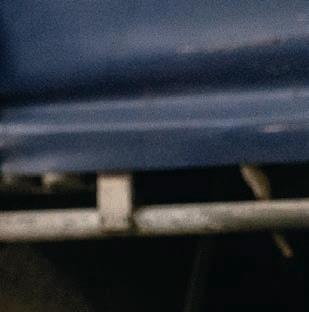











































































YOU DESERVE A SMOOTHER, BETTER BUSINESS WITH CALTEX
Caltex, we
premium industrial lubricant technologies available for every kind of operation – from mining to agriculture, power generation to construction, trucking to global marine. No matter what challenges you might face, the journey will be Smoother, Better, Together with Caltex. To find out more about Caltex fuels and lubricants, visit www.caltex.com/au/business-solutions or call us on 1300 723 706
At
are committed to providing the most advanced
Nissan throws in with heavy duty BEVs
Nissan is delivering new vehicles from the Port of Los Angeles to dealerships in the Los Angeles region using two battery electric vehicle (BEV) heavyduty, Class 8 trucks.
Two major manufacturers of electric heavy-duty trucks, Nikola and Kenworth, will each provide trucks that will pull traditional car haulers. The program is being conducted in collaboration with logistics partner Avant-Garde Auto Logistics LLC, a woman-owned transportation company headquartered in Smyrna, Tennessee.
Nissan has also collaborated with current logistics partner Wallenius Wilhelmsen to install a charging solution to support the trucks operating from the Port of Los Angeles.
“Exploring the use of BEV trucks for new vehicle delivery is an important


milestone in our journey toward carbon neutrality throughout our business,” said Chris Styles, Vice President, Supply Chain Management, Nissan North America. “By being an early adopter of this technology, we’re showcasing our innovative spirit and positioning ourselves to meet our longterm goals for zero-tailpipe-emission transportation.”
Appropriately, the first dealership deliveries with the BEV trucks, to Downey Nissan in California, included Nissan’s all-new, all-electric crossover, the 2023 Ariya.
The company anticipates the proof-ofconcept project will help Nissan and its logistics partners understand more about the use of all-electric trucks for vehicle delivery.

Following the initial trial with four BEV
car hauler trucks, Nissan plans to deploy additional trucks in the Los Angeles area. Building on lessons learned from these projects, Nissan could eventually begin using BEV trucks for a variety of logistics uses.
As one of the first automakers to use allelectric heavy-duty trucks to transport new vehicles to dealerships, Nissan is now building on its commitment to achieving carbon neutrality across its operations by 2050.
Along with launching EVs to make accessible electric mobility widespread, Nissan is looking for opportunities to reduce emissions from other parts of its business. As part of the company’s Ambition 2030 plan, Nissan has a target of 40 per cent of its US sales being electric by 2030, with more to be electrified.
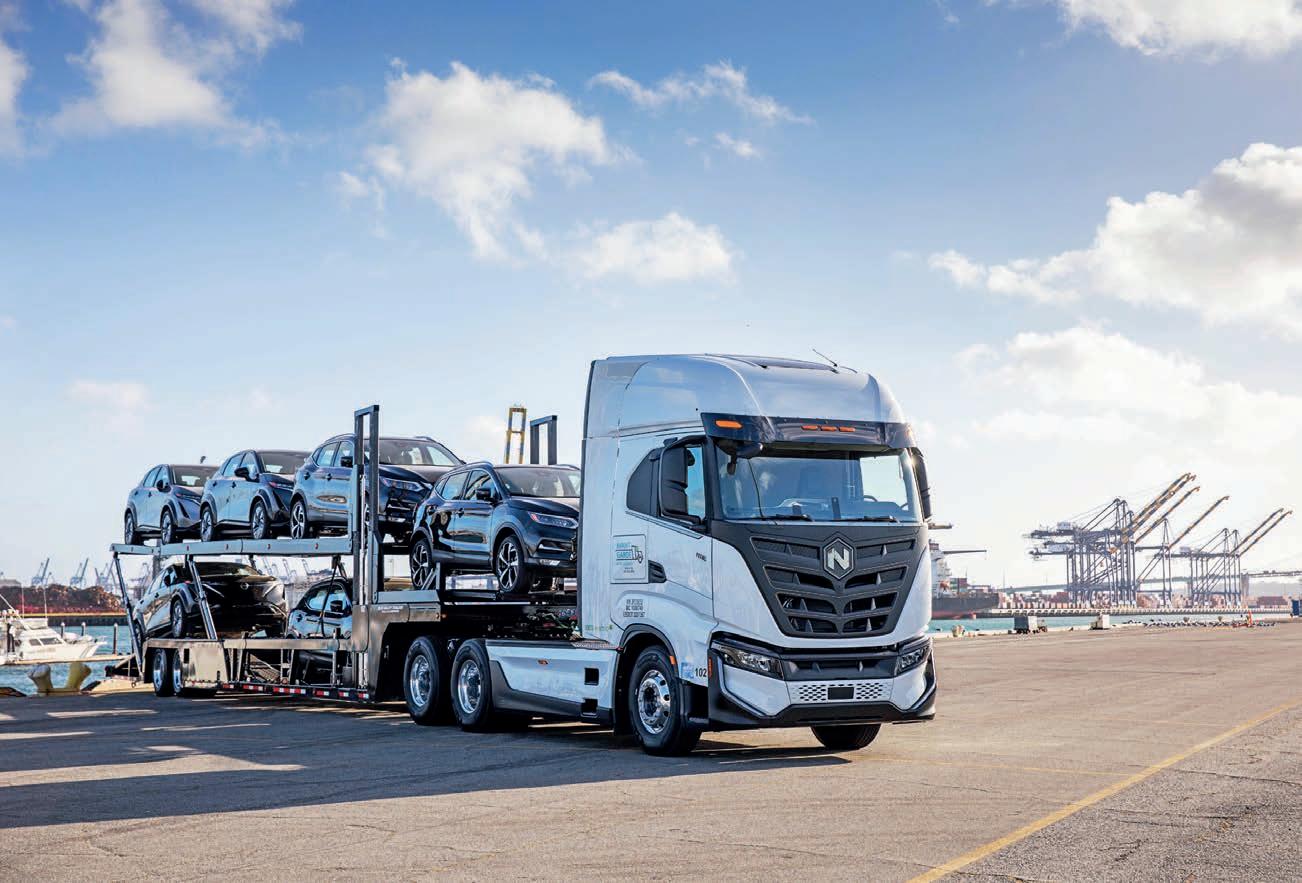
38 may 2023
GLOBAL NEWS
NikolaTre Class 8 semi at the Port of Los Angeles.
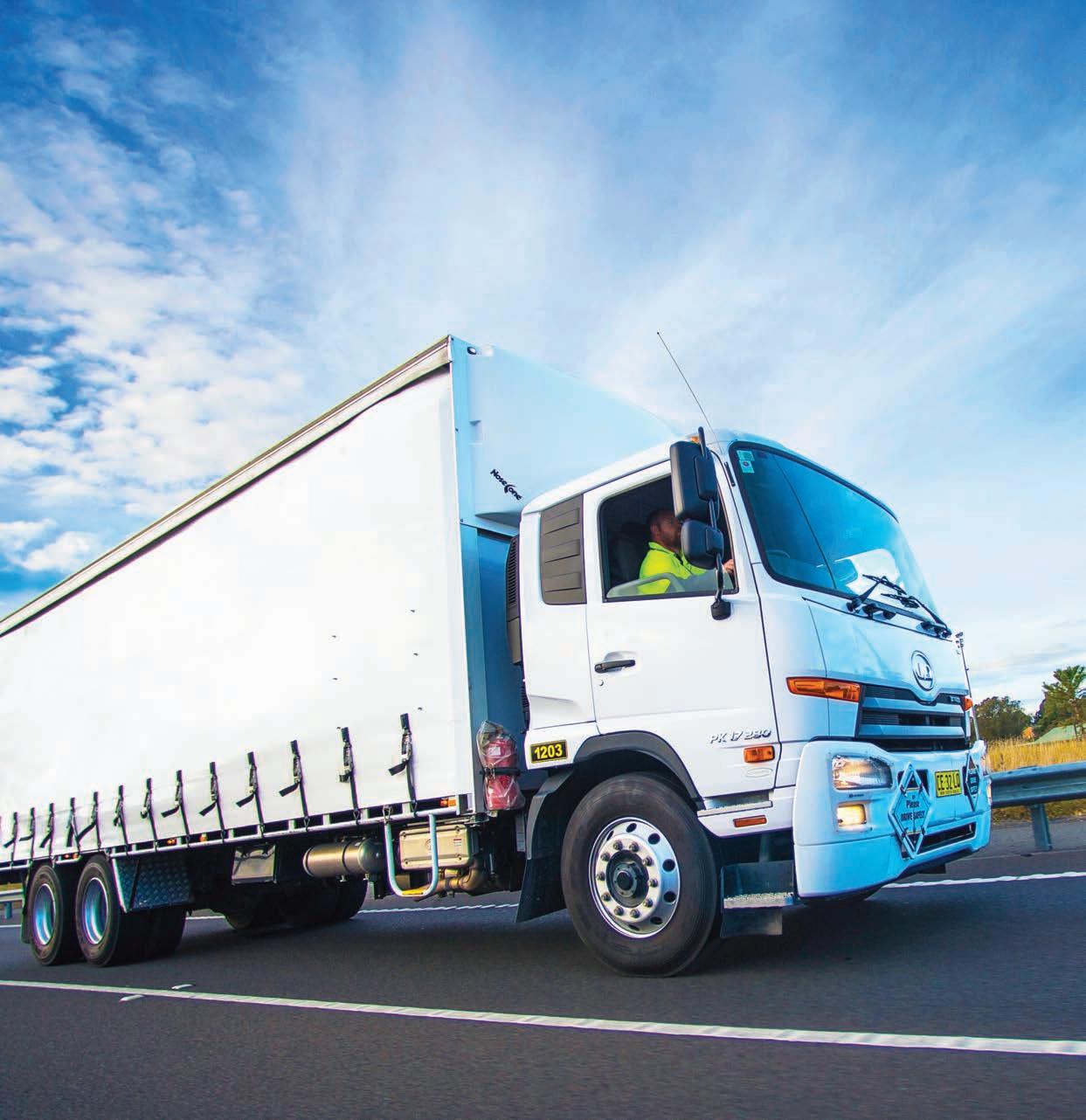





Mexico’s biggest truck fleet expands
KenMex compressed natural gas powered trucks have been added to Mexico’s biggest truck fleet operated by Trayecto.
Recently formed following the merger of Alianza Trayecto, Grupo Larmex and Grupo Transportes Monterrey, Trayecto operates over 300 CNG prime movers in its fleet of 4,000 trucks throughout Latin America.

The company, at present, provides the most complete portfolio of transportation services in Mexico, including regular and specialised cargo
in Mexico, USA and Canada, transporting different types of goods including domestic, food grade, hazmat, gases, chemicals, beverages, intermodal, controlled temperature and vehicles. The compressed natural gas powered trucks have Hexagon Agility fuel systems.
Hexagon Agility claims its ProCab 175 and ProRail 30 CNG fuel systems with integrated Blue iQ provide a driving range on par with counterpart diesel trucks, enabling Trayecto to utilise CNG, and obtain its environmental benefits,
without sacrificing performance.
“Our goal is to address the challenge of decarbonisation and implement technologies like natural gas where it makes sense,” said Jorge Casares, CEO of Trayecto. “Hexagon Agility has been instrumental over the last decade helping Grupo Transportes Monterrey transition diesel trucks to reduce our carbon footprint with natural gas. We value our partnership and look forward to many years of delivering safe and reliable transportation throughout Latin America.”

GLOBAL NEWS 40 may 2023
Jorge Casares.
PERFORMANCE AND ECONOMY

no compromise
Detroit’s DD16 delivers all the power you need.

With up to 600 horsepower and 2,050 lb-ft of torque, the big bore workhorse provides efficient and dependable power and performance without compromise. Detroit’s advanced technology also means GHG17 requirements are met through innovative fuel efficiency resulting in lower emissions.
This power, performance and efficiency prowess is backed by our industry-leading warranty and extended coverage packages that ensures the highest level of support for our customers.
Combined with superior fuel economy and the absence of a midlife change out, the DD16 delivers an enviably low total cost of ownership and maximum uptime.
This is all backed by our well-established and extensive national service and support network which, together with our highly skilled factory-trained technicians, means you can count on getting the right advice when you need it.
With Detroit, there’s no compromise.
detroitanz.com detroitanz
Fran De Sanary is a Senior Risk Engineer and Sustainable Mobility Consultant with Zurich Resilience Solutions (ZRS). He has been involved in the Heavy Vehicle and Transport industry for over 40 years, including many years working as a Group Fleet and Risk Manager. At ZRS, Fran provides practical and costeffective risk management solutions for Fleet, Process, and Transport businesses that maximise asset protection whilst minimising financial risk.
THROUGH THE MOTIONS
Iremember being at a convention back in 2016, when, to much fanfare, a significant European manufacturer unveiled its new electric vehicle. By the time the convention finished, however, the vehicle was practically redundant due to the tech advancements that had subsequently occurred. Seven years ago, EV technology was moving so quickly that new advancements soon became yesterday’s news.
That steep development curve is common in most new technology, and at some point the curve plateaus. Technology will still continue to develop and evolve, but at a significantly reduced pace. Reaching that plateau triggers large-scale adoption – and, from a commercial vehicle perspective, that’s where we’re now at with EVs. That’s why it’s imperative companies take time to understand the impact the transition to EVs will have on their business, and how they will navigate this transition. Because it will have a major impact, and it’ll come much sooner than many people realise. Some think the EV transition is 20-30 years away. No, think more like five to 15 years.
In the not-too-distant future, you’ll be unable to purchase petrol or dieselfuelled vehicles. Regardless of what’s happening here, the European, Chinese and US markets dictate our vehicle supply, and they’re not going to continue manufacturing petrol and diesel vehicles just for us.
The move to alternate-powered vehicles is coming – quickly – and those businesses that are ready to adopt the new
technology will be in a far better position than those that aren’t.
The EV challenges that businesses need to consider
To transition successfully, businesses will need to have a strategy and processes in place to manage the risks that will consequently present themselves. A consideration is how the cost and depreciation of vehicles is viewed. New business models will be needed, as the cost of electric and hydrogen-powered trucks will be significantly greater than current petrol and diesel counterparts. Of course, grants are currently available and carbon credits can be accumulated. But that cost outlay will need to be factored into the long-term financial strategy, and how that return on investment is modelled will need to change. Other factors will need to be brought into the ROI process rather than the direct and obvious.
Some costs may be offset by customers. For example, in the short- to mediumterm, customers may be willing to pay a premium to have their deliveries made by an electric vehicle.
But other returns will need to be identified and quantified. Having a consistent and reliable stream of power to charge EVs is another challenge. Is the infrastructure that’s currently in place suitable to charge the number of vehicles you need now and into the future? Recently, I worked with a company that spent $250,000 to get new transformers in the street to satisfy demand. Without it, they wouldn’t have been able to power their fleet.
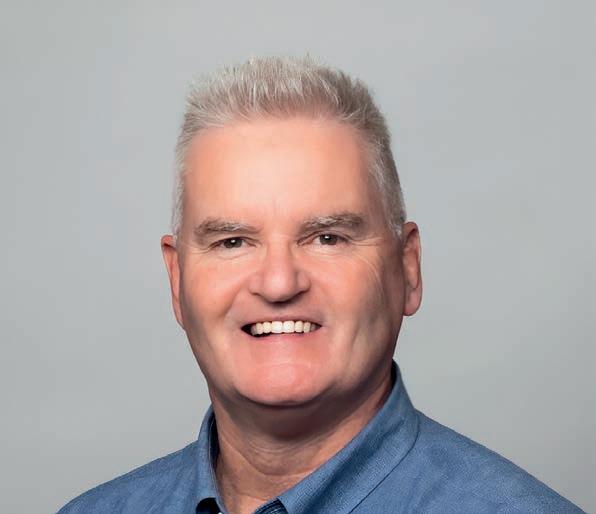
42 may 2023
RISK MINDSET
The biggest EV risk businesses face? Doing nothing.
Fran De Sanary
Driver education holds the key to adoption
The experience of driving an EV is different, and how you transition drivers will determine how well new vehicles are adopted. I know of two fleet businesses that began using electric vehicles –exactly the same models – with very different results.
The first company undertook a thorough training and education program with their drivers; the second practically handed over the keys and that was it.

While the first company enjoyed a very successful transition, the second company had a group of dissatisfied drivers to placate. Training is important, because driving an electric vehicle is different. Range anxiety is real, and regenerative braking and eco-safe driving techniques are key to maximising range. Regenerative braking, however, mostly happens when the foot is off the accelerator and not on the brake — and for drivers who are used to driving foot-to-brake it will mean a change in driving style.
Those drivers who’ve been managed well,
and have been part of a structured change management program, tend to prefer EVs. They are less fatigued and it’s a smoother ride — once you know how to drive them.
There are also practical risks to consider. What happens if someone trips over a charging cable? What eventuates if an employee is charging their work vehicle at home and there’s a fire?
These are just examples of the considerations that together, over the coming years, we need to understand and make provision for.
The transition to EVs is going to be a logistical and financial challenge. It’s new, it’s different, and it’s not simple or easy. However, the biggest risk for businesses regarding EVs is to sit there and do nothing.
Currently, the EV uptake is voluntary, but this will not always be the case. In the near future you’ll be forced to take action. Those businesses that have taken the time to map out their EV strategy, adapt to the challenges and maximise the opportunities, will be the businesses that have a far greater chance of success.
Starting your EV transition journey Of course, knowing where to start is sometimes the biggest hurdle. The business I work for, Zurich Resilience Solutions (ZRS), a business unit of Zurich Insurance, offers resilient risk engineering services that support businesses in this transition to electric vehicles. The early identification of risks and understanding your business’s resilience to this changing environment is vital and the quality and respected risk engineering services are paramount. We work with businesses to review all processes and procedures, including procurement, driver training and awareness, maintenance, charging infrastructure and placement, through ‘whole of life’ ownership to disposal. Once those risks are identified and mapped, we offer not only pragmatic risk improvement actions, but also assist you to achieve your resilience goals.
If you’d like to speak to the team at ZRS to help you plan your business’s transition to electric vehicles, email resilience.solutions@ zurich.com.au.

primemovermag.com.au 43 SPONSORED BY
New generation DAF Electric vehicles with charger.
TROP THUN

COVER STORY 44 may 2023
UD Quon emerges from the Gillies Range near Cairns in North Queensland.
IC DER
Waste collection specialist, MAMS Group, covers a vast municipal area in North Queensland the size of a European country. For this it relies on a dedicated fleet of commercial vehicles.

primemovermag.com.au 45
ARange, an 800-metre-high partition that divides the enclave of the Far North Queensland coastal plain from the interior Atherton Tableland. In this elevated region headwaters flow southeast into the Herbert River Valley where two historic mill towns are located. The Victoria Mill, established in 1883, on the Herbert River near Ingham was the country’s biggest sugar mill until 1999. Local family business MAMS Group, still a far cry from the guise it operates in today, got its start here. Back then it was carting mill mud and ash out of the refinery for the Colonial Sugar Refining Company, better known now as CSR. That contract was limited to seasonal work, restricted for the best part to six months of the year. In the slack season, MAMS occasionally
term. By the turn of the century, the company had moved into the waste sector having landed a successful tender for a wheelie bin contract awarded by the Hinchinbrook Shire Council. It was its first foray into hook lift and front lift trucks. That contract, three decades later, is still in service today.

The policy writ large for the company, circa 2023, is to consolidate after an expedited period of growth. The resultant legacy is five depots across an area the size of Poland, 60 staff, most of whom are permanent, multiple revenue streams and a growing truck fleet including four new UD Quons.
General Manager Josh Lannen has been with the company since 2010. You might say he married into it because that’s exactly what he did. After meeting his
business which he sold to his two business partners before heading to the tropic far reaches.
MAMS Group, by then, had been servicing a major waste management contract on Palm Island. It had included the construction of transfer stations on the island and the purchase of a barge it initially operated one day a week.
“We were the only way to get anything bigger than a suitcase on and off Palm Island,” recalls Josh. “That business eventually expanded to have multiple prime movers and fridge vans running out of a depot in Townsville to Palm Island for freight and food.”
When MAMS sold the business in 2011 to a group of investors, so that it could concentrate on its mainland waste business, it was operating two barges six
46 may 2023
Josh Lannen at a recycling depot in Cairns.
collection. Revenue is secured in large part from several local government, state government and private contracts. One of which is the Containers for Change initiative launched by the Queensland Government in November 2018. It provides 10-cent refunds for eligible drink containers. More than five billion containers have been processed to date. MAMS, as part of the scheme, began a logistics contract in Cairns that justified immediate investment in additional equipment. Work commenced in November 2021. With COVID disruptions plaguing supply chains, acquiring new vehicles promised to be a challenge. Not so for UD Trucks with whom Josh placed an order of four units after he, by his own admission, visited many dealers and

tested half a dozen different trucks. The first three, 8-litre 6x4 UD Quons, arrived within four months. A fourth, the UD 6x4 Quon 11-litre CW26460TAA, has recently, like the others, had a Palfinger hook installed in Townsville.
“UD were unbelievably good,” says Josh. “Our need was to get three trucks really quickly which they delivered on and the fourth one we have just taken possession of.”
MAMS, an acronym for Mud Ash Management System, runs truck and dog combinations on the Palmerston Highway and over the Gillies Range. In one 19-kilometre section there is 263 corners. The fourth truck — the 11-litre — has higher horsepower capacity (330kW) enabling it to overcome the snaking and often steep terrain. Hardly monotonous, the spectacular scenery, all the same, can threaten to distract

even the most experienced of operators. Most of the drivers working at MAMS are required to do a ten-hour shift.
“We’re not doing arduous highway driving by any means but after ten hours in the UD the time doesn’t weigh on you,” says Josh. “All the guys love the new UDs. The comfort it provides is particularly noted and appreciated.” For much of the wet season humidity hovers in the mid 90s. Venturing outside at times is almost unbearable. Cool rains don’t usually arrive until late afternoon when the work shift is over. The new Quons, in any event, are holding up well. Drivers can operate the remote control Palfinger hooks without having to leave the comfort of the cab. The application also poses an interesting hurdle.
Installation of a 6.2 metre hook lift on the back of the body warranted a longer chassis, yet the means to back into the
primemovermag.com.au 47
Tyre wear and fuel burn figures have impressed the team at MAMS Group.
sheds, where recyclables are delivered, require four- and five-point turns just to access these locations.
“One of the main reasons we got the UDs was their tight turning circle,” says Josh. “We needed a cabover and something that was exceptionally manoeuvrable. Most of the other trucks I drove didn’t have a chance of getting into some of these places we need to get into.”
In Cairns, where its four UDs are all based, MAMS carries three different product types: aluminium cans, clear PDT bottles, like those used for milk, soft drinks and water; and glass bottles. The hook lifts are moving 15 cubic metre skips. Materials are sourced across the Cairns and Cassowary coastal region as far north as Mossman, via Tully and out to the Atherton Tablelands. The trucks are generally fairly light on the road compared to most other trucks. Even so, the new heavy rigid UDs are consuming less fuel than some of the slightly older medium rigid trucks in the fleet.

Six months after the 8-litre Quons were introduced, Louise Lannen was analysing fuel burn and tyre usage, a metric she likes to evaluate regularly. Initially she thought someone had made a mistake entering numbers for the new UDs. “She told me the fuel usage and tyre wear on the UDs was like half of what it should be,” recalls Josh. “My wife scrutinises all that stuff thoroughly.” After spending a day and a half going over the data they found, to their delight, that there was nothing amiss. “No one had missed anything,” he says. “They’re just that good.”
All four UDs are rated to the Japanese pPNLT equivalent of Euro 6 emission requirements with an AdBlue capacity of 50 litres.
Active safety features include Traffic Eye Brake System, Traffic Eye Cruise Control, Lane Departure Warning System, Electronic Stability Control and Automatic Hill Start Assist.
The fleet presently accounts for six prime movers, 23 heavy rigid trucks and six medium rigid trucks plus an assortment of utes and light vehicles.
Tyre wear is measured through partner, Bridgestone, who supplies all tyres for the commercial vehicles used by MAMS. Josh says he knows how many kilometres the fleet gets out of every tyre, from every position on the truck.
“We’re pretty adamant about using data and twice a year we will sit down and compare performance and tread to make
gone to Bridgestone because we get the most out of that arrangement. They’re not the cheapest but they’re the best value for our money — when you look at downtime for changing tyres.” Going up and down winding ranges is
48 may 2023 COVER STORY
weight on board when we’re going up and down the Gillies Range, which is a pretty wild range to go over or on the Palmerston Highway in the UDs, fuel burn and tyre wear on those three trucks is the best out of the fleet.”
commercial side of its operations, the business removes skips from construction and demolition sites between Ingham and Innisfail. This also entails house renovations, spring
problems of the industry in recent years have been problems of transition.
In 2020 federal parliament passed legislation banning the export of unprocessed waste overseas via the Recycling and Waste Reduction Act.

primemovermag.com.au 49
The UD Quons have handled the steep cornering of the nearby ranges with aplomb.
Australia being a nation that exports more manufactured goods than it it will reconfigure local infrastructure to reprocess and re-manufacture recyclables

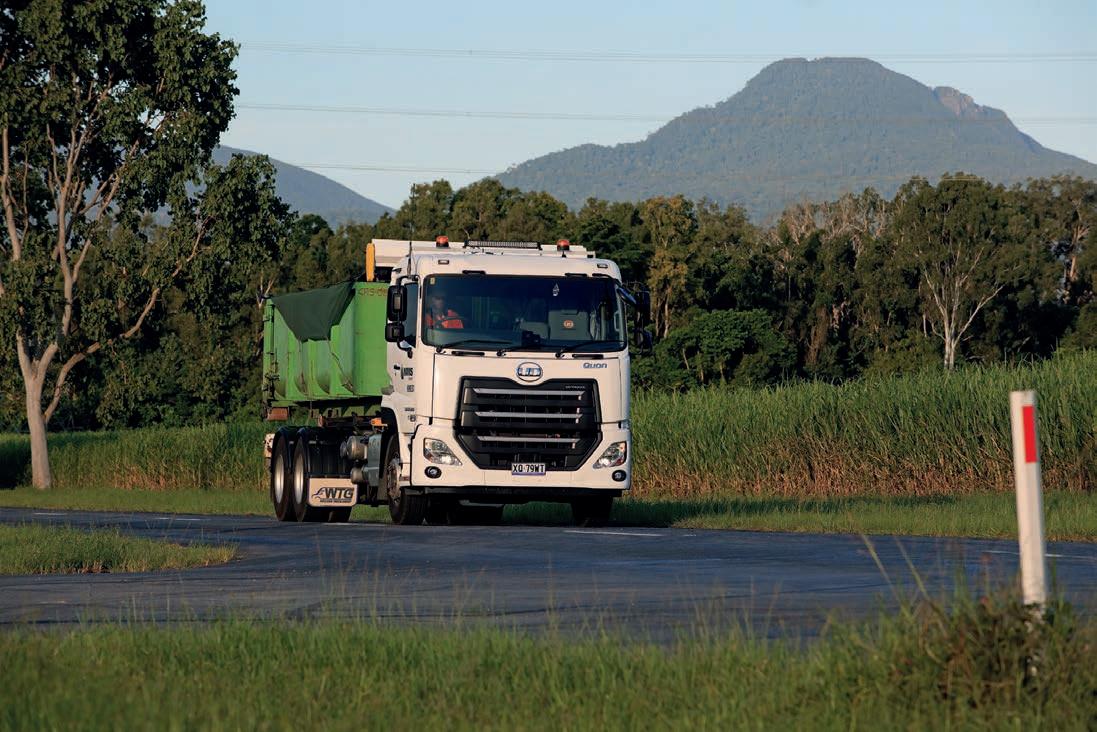
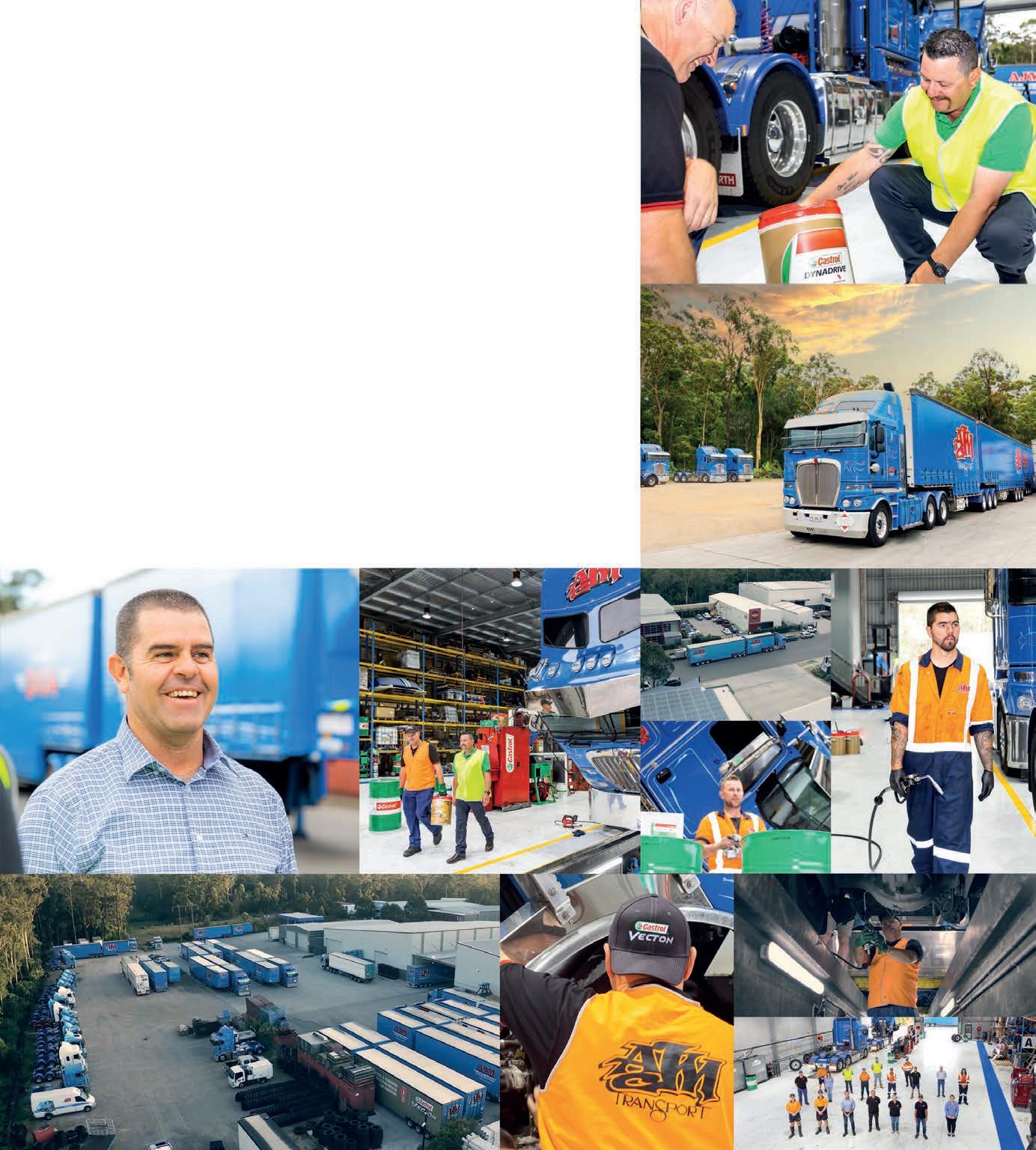
onshore. For MAMS Group that means having to find Australian-based processors for the likes of agricultural plastics, a commodity not in high demand according to Josh.
“We used to export all of it directly out of the port,” he says. “Now we’re having to freight a lot of that product down into Melbourne to get it processed.”
Josh, who is 40, is covering a huge swathe of territory himself managing the five depots. His 2018 Toyota HiLux, which he handed down to a work colleague over Christmas, already has clocked over 300,000 kilometres. Since he was 21 he’s had a pilot licence. It’s time, he believes, to make more use of it — so he tells Louise.
“I’ve been pestering my wife a lot about buying an aeroplane,” Josh jokes. “I’m still trying to convince her.”
The sky, at least for the moment, really is the limit.
COVER STORY
The new UD Quons cover elevated coastal terrain with pockets of lush sugarcane.
The hook lift unloads one of the bins in Cairns.
AJM CLOCKS OVER 3 MILLION KMS’ PER

When clocking up 3,000,000 kms’ a month you can’t cut corners with your truck fleet. That’s why Newcastle transport specialists AJM use multiple Castrol products across their fleet maximising asset life and increasing profits. We’ll help you make it happen. Visit castrol.com.au
MONTH WE HELPED MAKE IT HAPPEN.
LIGHTNING SMOKE STACK
Gavin Sutton Transport demonstrates that commitment and agility are vital to create a successful modern transport operation.
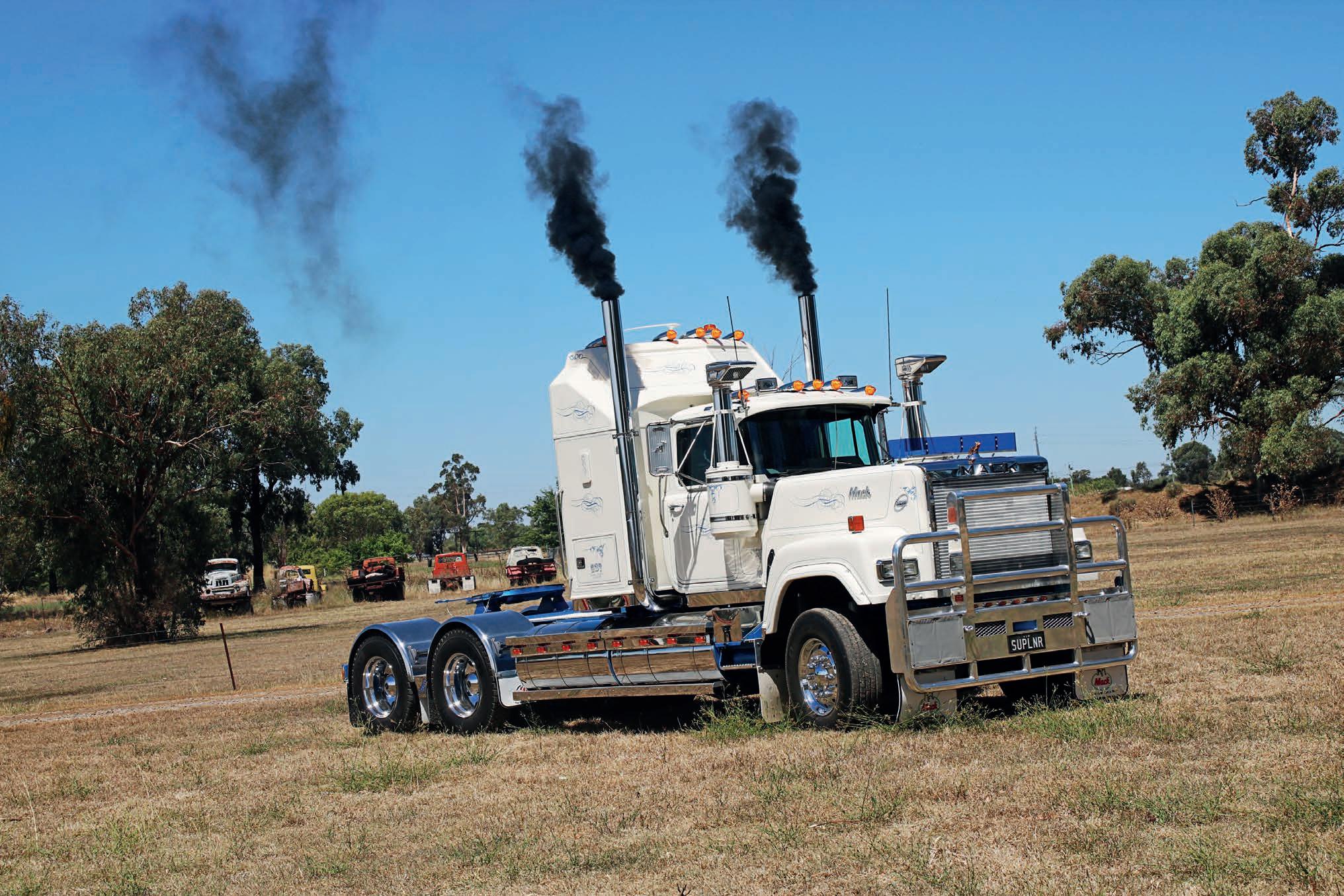
FLEET FOCUS 52 may 2023
The restored Mack SuperLiner.
Gavin Sutton seems to have no particular loyalty to one brand of truck. It’s whatever is most suited for a particular job, which explains Gavin recently taking delivery of the Number 693 Kenworth Legend SAR which shares its dedicated accommodation with his magnificently restored 1989 Mack SuperLiner. The majority of the current fleet of Gavin Sutton Transport are Volvos and Kenworths, both of which are normally replaced at around 700,000 kilometres. Living in Tamworth, Gavin worked for a number of local transport businesses including Howard Haulage, Timberline Transport and Carey’s Freightlines as he developed his expertise in the management of transport operations.
Subsequently, Gavin Sutton Transport (GST) was created when Gavin bought out the transport section of a local earthmoving business in the mid-2000s. Two trucks which he still operates to this day were part of that deal. Initially, it was mostly float work involving machinery for hire companies and government entities but this has transitioned to becoming
predominantly flat tops and drop decks as the business has expanded and diversified in a different direction. Today, Gavin has 22 trucks, including several with truck-mounted cranes, and more than 50 pieces of trailing equipment and operates throughout the eastern states of Australia. “It’s taken lots of hard work, a lot of sleepless nights and a lot of seven-day weeks to get to this point,” he says. Relocating pieces of machinery remains an important part of the low loader division while much of the company’s growth in recent years has come off the back of transporting pre-cast concrete components such as pipes and culverts for Humes which has a manufacturing plant nearby in Tamworth. Pre-cast pipes and other building components can be transported from as far away as Humes’ plant in Townsville to be delivered to Adelaide and Melbourne.
Over the past four years the massive Inland Rail project has seen up to 18 GST roadtrains per day delivering pre-cast concrete items to the Moree section of
you might have to tread water and do other things until the next one comes online,” says Gavin. “We have to maximise the investment in the gear plus my staff get used to constant work. A quiet time can make you rethink things and also have a bit of a clean-up of surplus equipment, and it can be a juggling act, but we are fortunate because we have always owned a lot of our gear.”
For the Inland Rail project GST had Vawdrey build 15 new trailers which was a sizable acquisition for the fleet.
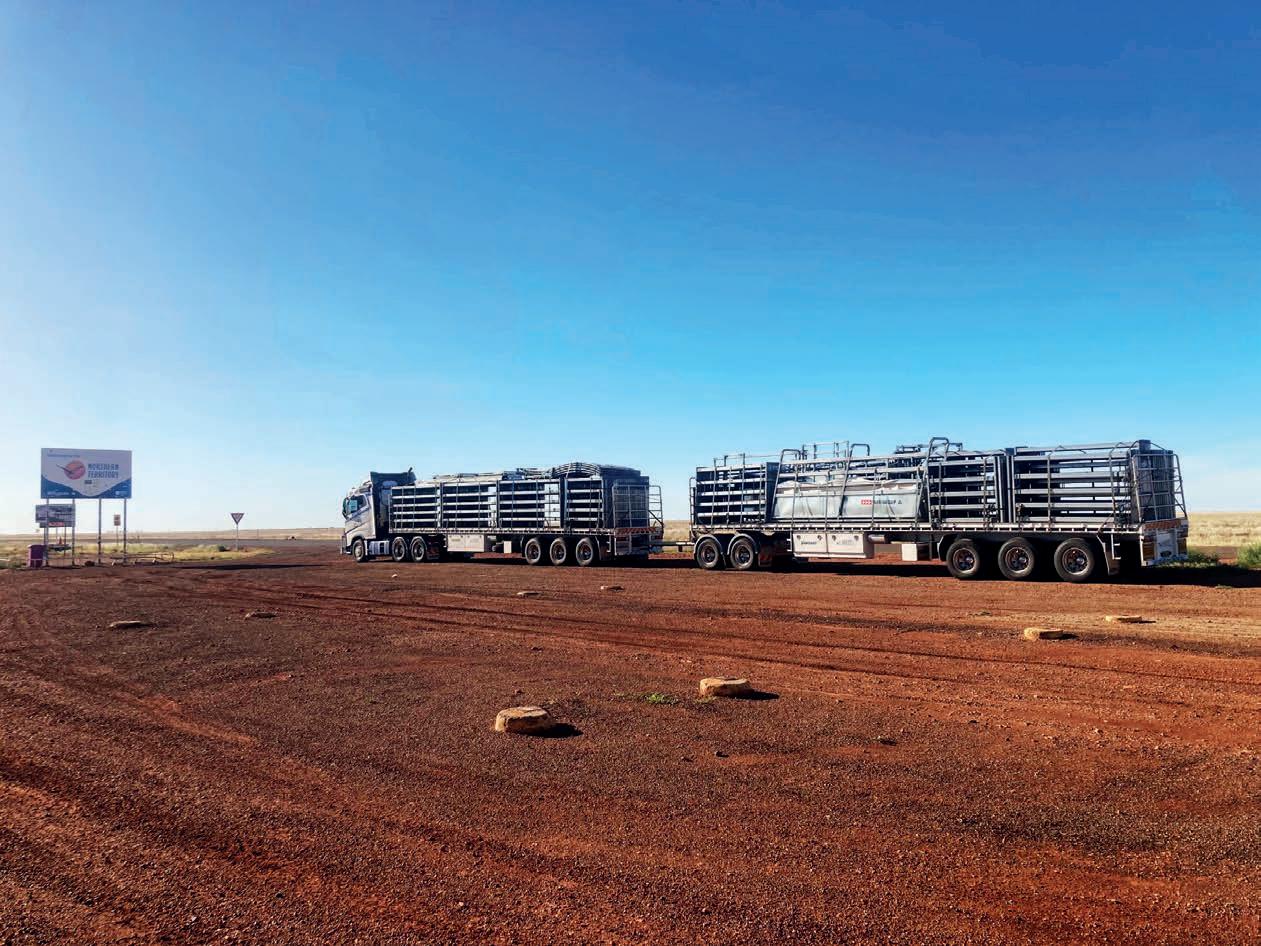

This type of infrastructure construction can be seriously affected by weather, as well as be influenced by the component manufacturer’s production schedule, and it hasn’t been unusual for GST to deliver loads to Daly Waters in the Northern Territory and then transverse 2,000 kilometres across northern Australia to Townsville to collect a load of pipes destined for Melbourne.
Other projects that GST will be involved with over the next couple of years include the upgrade of the Newell Highway,
Volvo FH double roadtrain headed to the Northern Territory.
Harbour bypass.
Over time the prime mover fleet steadily expanded to include various brands, with Volvo currently the dominant badge.
“I didn’t favour one brand or another,” says Gavin. “My first ever truck was an old cabover Kenworth with a 6-92 Detroit in it. I don’t have a particular love for cabover Kenworths although I’ve got a K104B, an old K125 and a new K200 which is probably the best to drive because it’s


54 FLEET FOCUS
Gavin Sutton.
Volvo FH 600hp triple roadtrain.
an auto.”
As work began to escalate, Gavin needed a cabover truck in a hurry for B-double work and turned to a local dealer.
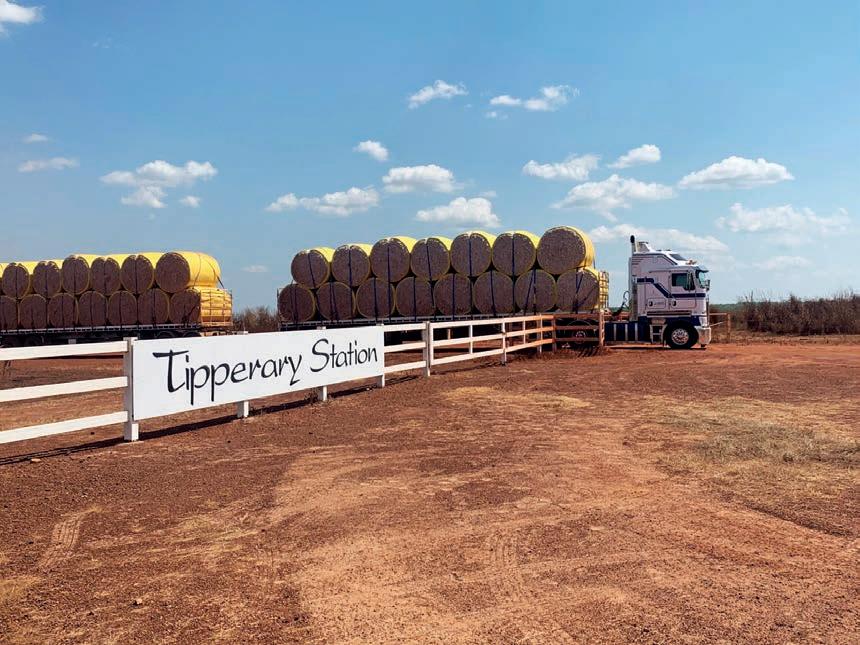
“I’d been friends with John Saint at the JT Fossey dealership just up the road for a lot of years,” he says. “If you’d said to me two years prior to then that I’d have four new Volvos parked in the yard I’d have laughed at you.”
More Volvo prime movers have since
“It never entered my wildest dreams that I’d ever pay around half a million dollars for a prime mover, nor wait nearly two years for it to come off the production line,” he says. The Legend SAR features additional custom touches including the paint scheme and extensive stainless steel trim pieces. Gavin was bemused that the Legend had almost 5,000 kilometers on the clock by the time it was delivered to his yard due to the truck being built in Bayswater, driven to Toowoomba to have an Icepack fitted, then driven to be custom painted in Brisbane, back to RC Metalcraft in Albury for some ‘bling’, then to the Brown and Hurley dealership in Coffs Harbour for its pre-delivery finalisation before eventually making it to Tamworth.
“It was nearly due for its first service,” jokes Gavin, “But the efforts of the many people involved have been worthwhile.”
In contrast with Gavin’s latest version of the Kenworth Legend is his awardwinning restored 1989 Mack SuperLiner which started life performing express freight along the Newell Highway between Melbourne and Brisbane, followed for a period hauling mine explosives around Mudgee in New South Wales. It then clocked up another 20 years following its conversion into a heavy tow truck operated by John Dunn based at Moonbi just north of Tamworth.
Upon acquiring the Mack and aided by
mudguards and new brackets for the fuel tanks which themselves were wrapped in stainless steel. New front and rear suspension components were sourced and fitted. A new 500hp crate motor had already been installed and the nine-speed Mack transmission was replaced with an 18-speed gear box.
“We wanted a direct box to slow it down a bit,” says Gavin. Not just a pretty show truck, the Super-Liner was put back on the road pulling roadtrains every day grossing up to 90 tonnes. Currently back on single trailer registration the Mack still does the occasional load as well as attending truck shows.

Despite a new interior being sourced and fitted, Gavin says: “It’s a bit more comfortable driving the SAR.”
Future restoration projects include an International 3074 similar to what Gavin first drove on interstate routes, to be followed by a C1800 International powered by a 160 Cummins.
“I should have gone with the C1800 first and had a bit of practice, knowing what I know now,” says Gavin in relation to the effort expended on the Mack’s restoration. Gavin Sutton not only has the ability to build a successful specialised transport operation utilising the latest in truck engineering and technology, but he can do so while maintaining his appreciation for road transport heritage — a rare thing indeed.
primemovermag.com.au 55
Kenworth K200 hauling bales of hay.
CONNE HIGH SPEED
Fred’s Interstate Transport has become a major player in interstate freight services throughout Victoria, Sydney and Brisbane since 1978 when Frederick Borg founded the company. Together with a team of owner-drivers who were instrumental in transporting client products, the business soon expanded to the substantial fleet it is today with several long-term clients, many of whom remain.
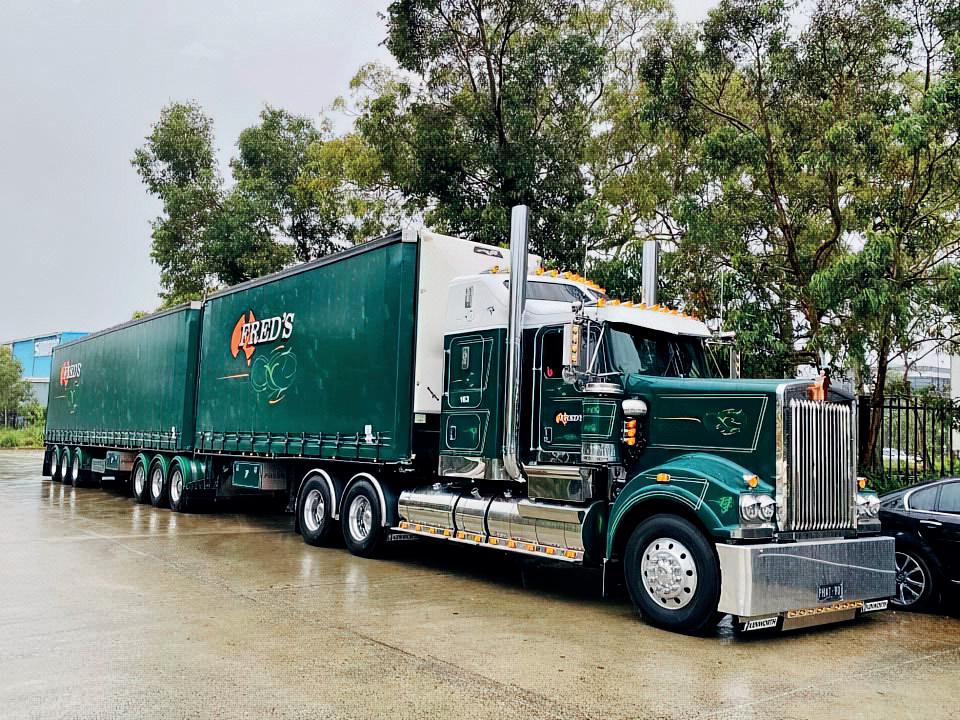
In recent years the fleet has undergone a complete transformation to now
include more than 135 A- and B-double combinations, pulled by 65 Kenworths varying from K200s and T610s to T909s in 36- and 50-inch integrated units.
The entire business model itself has changed as well. A more specialised focus, according to Managing Director, Danny Borg, has occasioned a move away from sub-contractors and tow operators.
“We made the decision to do everything with our own fleet,” he says. “So, in the last five years we have grown the fleet in order to have complete control and
transparency on what’s happening in terms of service levels for our customers.” Fred’s also recently built its new workshop facility in Shepparton, which was another part of the major change in operations at the business. The depot was designed to handle the volume of the new fleet while providing trailer refurbishment programs, general maintenance of vehicles, high flow service facilities and new wash bays.
At present, the oldest prime mover in Fred’s fleet is five-years of age. And since this particular vehicle arrived, almost 40
FLEET FOCUS 56 may 2023
By having its entire fleet fitted with JOST components, Fred’s Interstate Transport’s has been able to gain an extra advantage in the field of efficiency.
Kenworth T909 on B-double duty.
CTIONS
new trailers have been delivered — all decked out with JOST equipment.
The relationship between JOST and Fred’s began in 2007 as Danny recalls. Although it initially began with JOST Modul landing legs being fitted to the trailers, the fleet has since grown to include JOST fifth wheels and kingpins as well.

“Their product was a standard OEM thing at the time, which we were very familiar with, so we were happy to use it,” Danny says. “We’ve been using their landing legs ever since and we’ve never had any trouble with them. In recent years we’ve moved to their turntables and kingpins too, which wear very well. We didn’t use a lot of them
prior to that, but in the last five years with the fleet rebuild, everything here is now JOST.”
JOST’s Modul landing legs are a standard fitment to all of Fred’s trailers due to their speed and ease of use. Additional conveniences for transporting freight around Australia have been forthcoming thanks to the low maintenance required. “Drivers enjoy the ease of the Modul landing legs due to how easy they can select gears when lowering or raising the
gearbox.”
According to Danny, the reliability and strength of the JOST product, by his reckoning, goes unmatched.
“It’s just a good, solid and reliable product that does its job,” he says. “I don’t get any complaints about the JOST products from our drivers, so that tells me that they like the product and that it’s doing what it’s supposed to do.”
Simple for operators to use, the JOST JSK37CW series of fifth wheels feature
 JOST JSK37CW series fifth wheel.
JOST JSK37CW series fifth wheel.
position and when the secondary lock is down — allowing them to effortlessly connect and disconnect trailers. Since reverting to the JOST JSK37CW low maintenance fifth wheel, the process of coupling and uncoupling units at Fred’s has never been easier.

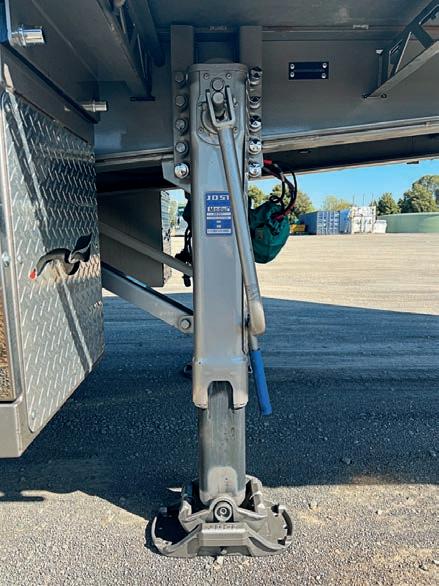
“As a product it works flawlessly,” Danny says. “The main thing I like about their fifth wheels is the fact that they have a really nice positive lock when you’re hooking vehicles up. They’re locked in and they’re easy to unhook, so they’re just a very serviceable unit.”
The fifth wheel also comes standard with an extended handle for ease of operation when splitting trailers, preventing drivers from having to reach underneath the trailer to grab the handle. Also, having LubeTronic on the JSK37CW helps with less maintenance. And, with the jaw constantly being lubricated between service intervals, extended service life is a guarantee.
“The fifth wheels are an excellent product with good wear and they’re affordable to rebuild,” Danny says. “The automatic greasing on the LubeTronics that they run are great, and from a maintenance point of view, you don’t have to worry about it. They’re pretty much set and they have a long life on them, so they’re very simple to maintain. And as I say, they’re very cost-effective in terms of replacement parts – whether it’s foot bushes, jaw kits and the LubeTronic canisters.”
LubeTronic supplies grease directly to the jaw and gives a continuous lubrication for
three years, which is also a peace of mind for Fred’s. With the jaw being properly lubricated at all times, the LubeTronic also helps with easier connection and a longer lifetime for both the jaw and the kingpin. By using JOST’s low maintenance fifth wheel, skid plates are given a longer product life as well. This further reduces the amount of maintenance needed for fleets. And, if there is maintenance needed, it’s an easy fix as replacement parts are readily available through JOST’s national distribution network.
“From a maintenance, lifecycle and serviceability point of view it makes things a lot simpler for our maintenance program routine,” Danny says. “The product’s very simple to work on, it’s quite effective and it’s reliable, so it’s a product that does what it needs to do
at a safety and performance level and requires very little input from us on that maintenance components side of it.”

Like many of JOST’s regular customers, Fred’s finds all aspects of dealing with JOST to be positive. Having direct contact with JOST’s well-known reliable aftersales service, Danny has been confident in placing his trust in JOST for complete truck and trailer fitment throughout the fleet
“Their customer relationships and their service levels are better than anybody else in the market from where we sit,” he says.
“They visit us on a fairly regular basis and are always in communication with us, which is what drove the decision to continue dealing with them in the end.
“They communicate with us and if there’s any issues we have, which there’s very few of, they deal with it a very timely manner.”
Danny is assured that JOST will continue to play a major role in Fred’s operations for many years to come.
“Overall, it’s just a good, all-round product,” he says. “It’s reliable, effective and simple to maintain — and that’s what you want in a big fleet.”
There is much, where future growth prospects are concerned, already in the pipeworks according to Danny. Following recent exponential growth, a new facility is being planned for Brisbane which will complete the circle in the fleet’s interstate operations. With design work currently taking place, it is expected to be finished by 2026.
While there is no doubt Fred’s will continue to expand its presence over the coming years, Danny assures that the fleet will keep the original values established by his father and founder, Frederick, close to its heart.
“Although we have gone through a number of changes, the guiding principles remain pretty much the same,” he says.
“Fleet-wise it’s a continuation of what the business was in its early days while raising the profile with the new fleet and modern facilities, and really taking it to the next stages as a second and third-generation operation. We’ll move forward from there and continue to do what we do best while sticking to our roots.”
FLEET FOCUS
JOST Modul landing leg in action.
JOST telescopic landing gear at work under a B-double curtainsider.
Leading the way in vehicle safety and performance
Scully RSV is on a mission to have the safest vehicles on the road. Every day.
Scully RSV and SafetyCulture have partnered to develop an industry leading initiative for transport safety. The digital safety inspection captures the performance of Scully RSV vehicles each and every time they are used on our roads.


The SafetyCulture platform enables a more efficient and optimised inspection capture and reporting system for vehicle compliance and safety. Delivered via a QR code scan, users can launch and complete the vehicle inspection in less than 30 seconds.
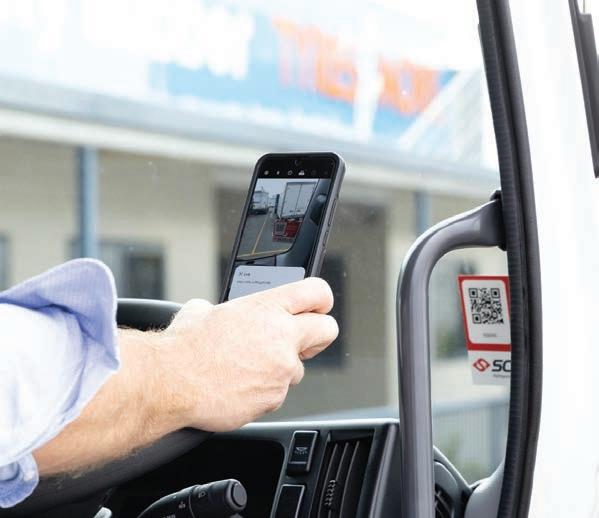
Scully RSV is proud to be bringing this initiative to market with Safety Culture and leading the way in keeping our communities and their families safe. It’s another great example of delivering on the customer promise, that Scully RSV fleet is managed to the highest levels of quality, safety and reliability.
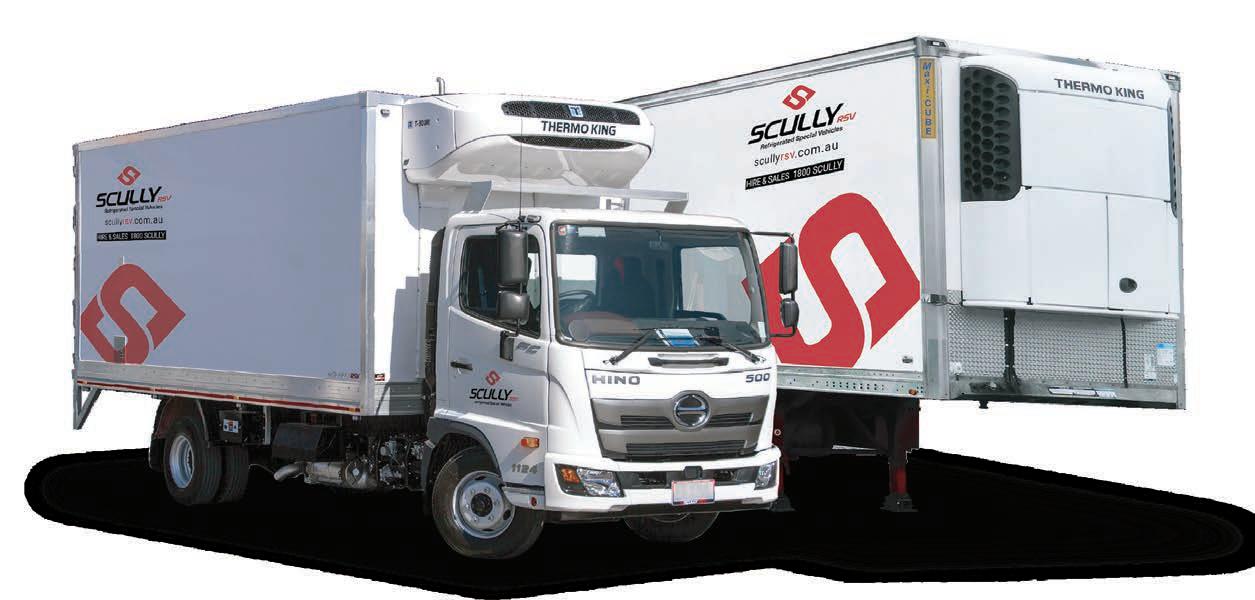
FLEXIBILITY TECHNOLOGY RELIABILITY SERVICE QUALITY 1800 728 559 info@scullyrsv.com.auwww.scullyrsv.com.au
SKY HIGH
Purchasing four Isuzu FYJ 300-350 trucks has allowed Height 4 Hire to build further on its wellknown reputation for providing reliable, safe and well-maintained equipment for hire.
Since its inception in 2010, Height 4 Hire has become one of Queensland’s largest privatelyowned and operated suppliers of access hire and scissor lift hire equipment. Although electric scissor lifts are one of its most sought-after pieces of equipment due to their flexibility in tight spaces, a small turning circle
Managing Director, Ken Bakker, has spent over 40 years in the mining, building and construction industries, and by working alongside his team, he has seen the fleet undergo extensive growth from 55 machines in 2010 to over 1,000 today.
“I’m still loving what I’m doing, but I’m 64 and I’ll keep working for a few
And lastly, in accordance with a more comprehensive checklist, Height 4 Hire also offers an annual inspection which can take over an hour to finish.
Height 4 Hire now has two depots to meet the industry’s demand for rental equipment – one at Richlands on the southern side of Brisbane, and the other on the northern side at Northgate.
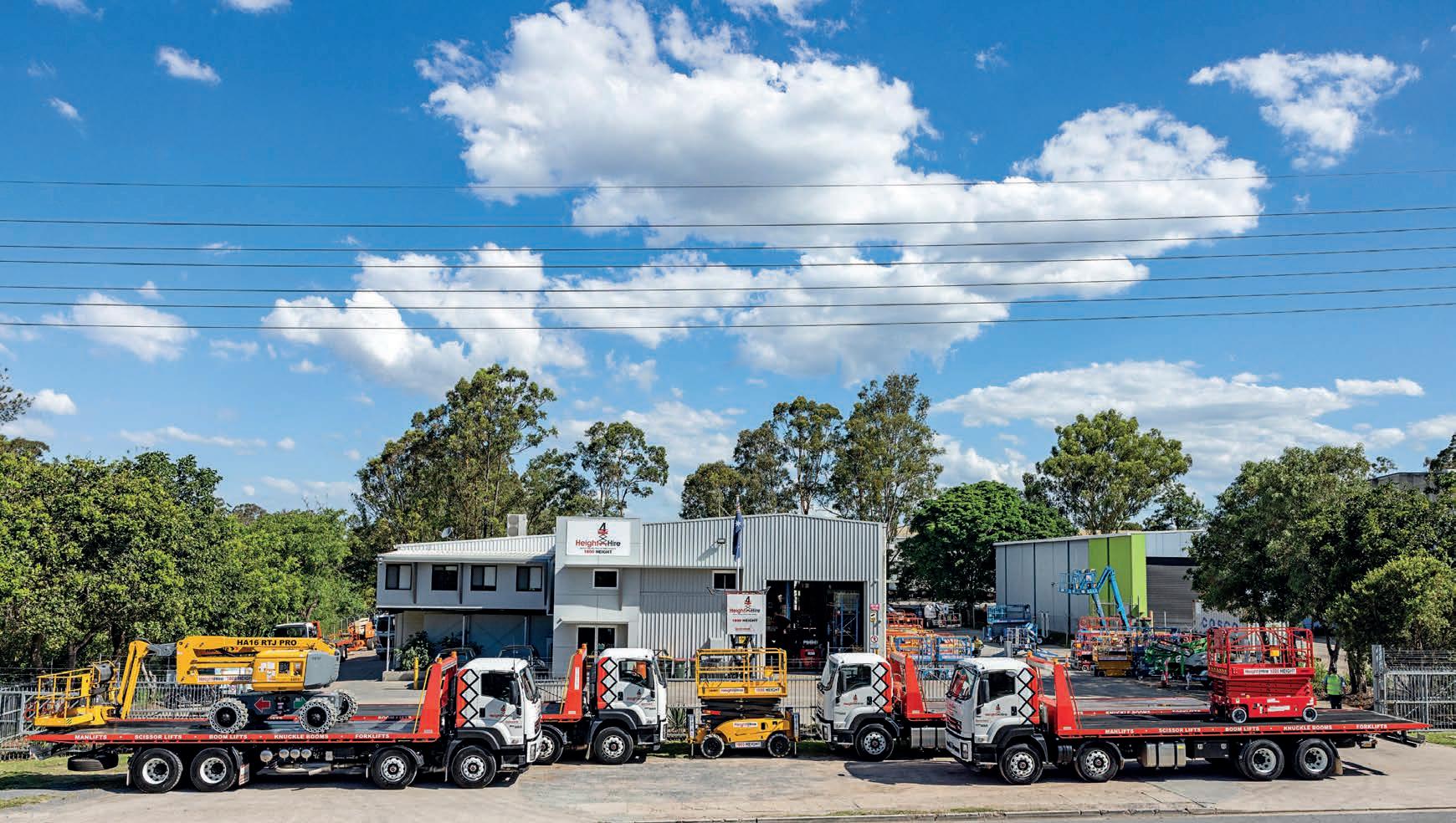
FLEET FOCUS 60 may 2023
The Richlands depot in Brisbane.
“We eventually kept adding machines, trucks to the point where we now have nine of our own,” he says. “Six of the nine are Isuzus and the others are just opportunistic buying where we’ve just absolutely had to have one and the Isuzu wasn’t available at the time.”
Of these new vehicles, Height 4 Hire’s most recent additions – four automatic FYJ 300-350s in 8x4 axle configurations – have allowed Ken to achieve another level of productivity and efficiency while keeping the company’s original values in place.
“Our goal is to ensure our machines are always reliable and we want to make sure we are always safely taking our customers to new heights,” he says. “With our everexpanding fleet access equipment, we aim to provide machinery and services that ensures customer productivity levels are maximised at an affordable cost. Our latest additions from Isuzu
have helped out in this area as they suit our needs more than anything. We cart our machines to various sites around southeast Queensland, and they seem to suit the size of these pretty well.”

The increasing reliance on Isuzu was somewhat a byproduct of having a second-hand truck from the brand that proved ever-trustworthy. By default Isuzu has become, when available, first preference.
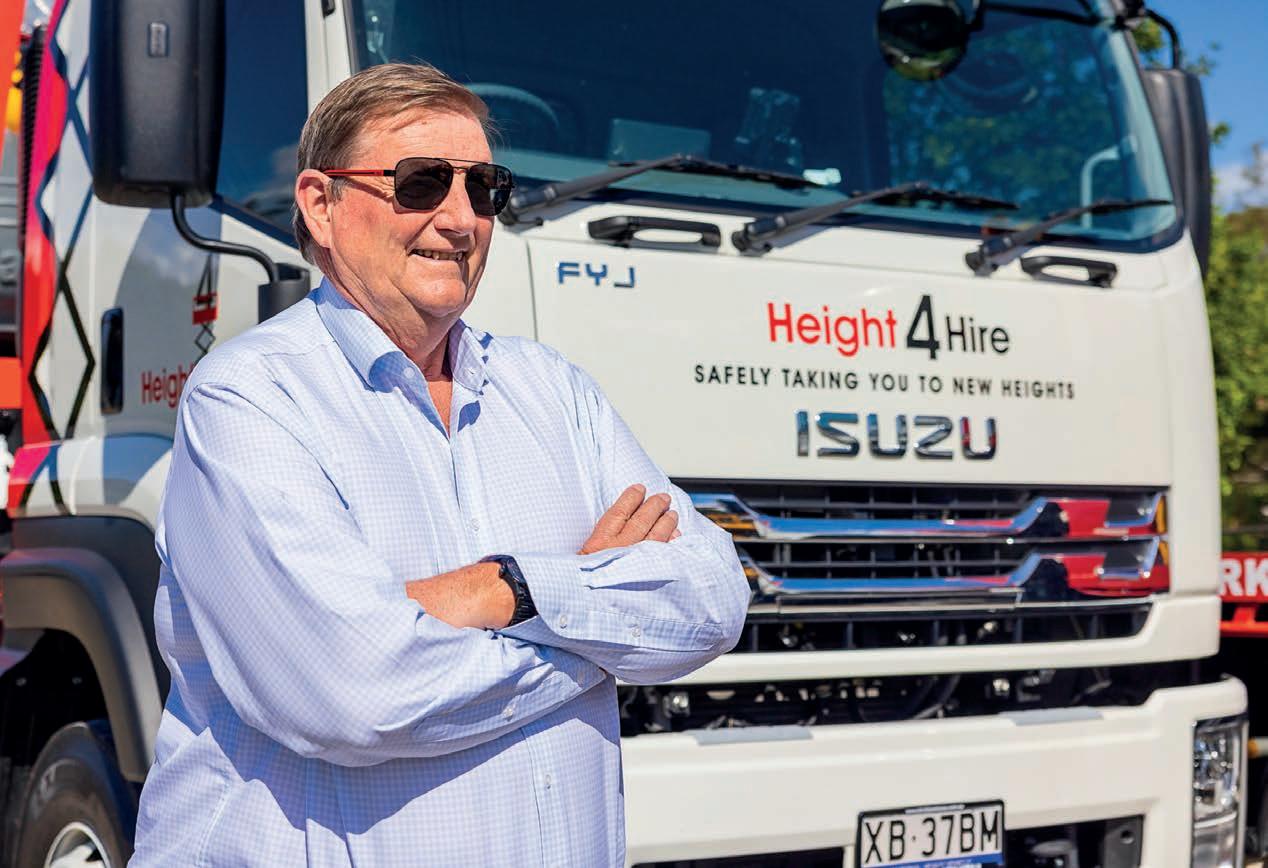
“They’re very reliable trucks and they are well-priced for the market,” Ken says. “While we don’t have a lot to benchmark them against, they do seem to work extremely well for us. The product is very simple for the drivers, and the only thing that changes is the size of the truck, which makes it easier to swap our drivers from truck to truck, something we have to do a lot.”
Equipped with Isuzu’s 6UZ1-TCN engine, the 2021 Isuzu FYJ 300-350
primemovermag.com.au 61
Ken Bakker.
has enough heft to back up capacity with a power rating of 345hp achieved at 2,000rpm and generous torque of 1,422Nm available at 1,400rpm. The FYJ also comes in a 10x4 configuration with a choice of three different transmissions, airbag or steel spring suspension, and multiple wheelbase lengths. At the heavier end of the spectrum, Ken’s
4430 transmission, which was a significant upgrade on the Allison 3200 transmission. At the time of its release, it was widely considered the industry norm for this class of truck. The FYJ also houses Isuzu’s load-sharing front suspension that allows customers an additional one tonne on the front axle group by evenly distributing weight across both
Isuzu made several design changes to the predecessor in the successful FY series. Most significant of these is a marginally shorter rear axle ratio for all FY Auto models, which, according to Isuzu, was developed in response to demand from the experienced Isuzu dealer network as well as customer feedback. In addition, the new ratio of 5.286:1 is said to provide improved startability in tricky conditions while assisting in overall performance, particularly at lower speeds.
According to Isuzu Australia Limited (IAL) Chief Engineer, Product Strategy, Simon Humphries, who oversaw the fine-tuning of the upgrade, the FY auto models’ overall gearing and on-road performance at cruising speeds is comparable with the manual transmission options.
“It’s now sitting at almost the same as a manual transmission model,” he says. “At 1,830rpm at 100 km/h up from 1,690rpm at 100 km/h with the previous axle ratio — with minimal impact on fuel economy.”
Ongoing refinements in its vehicle technology along with Isuzu’s reputation for product support have been instrumental in making it the leading brand in Australia.

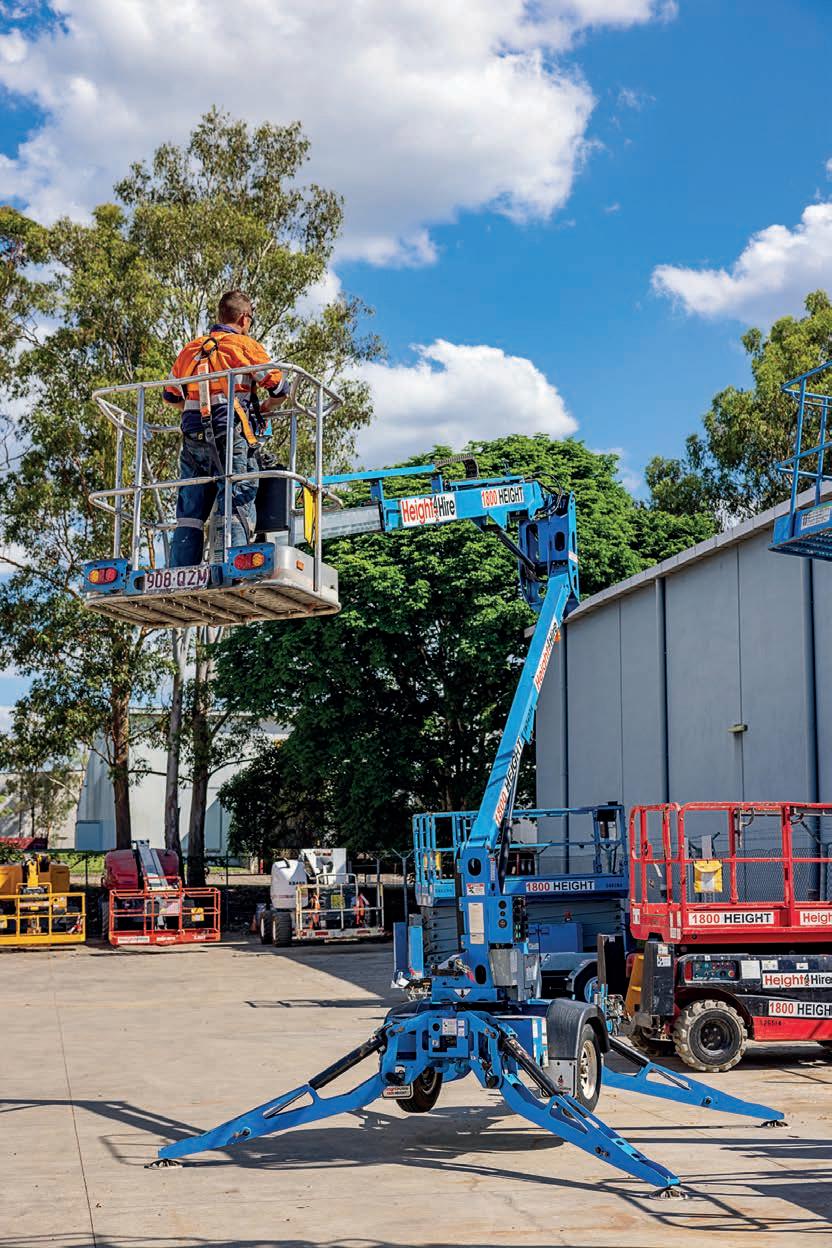
Ken has seen this firsthand himself. “We have a good relationship with Isuzu,” he says. “We’ve found that they’ve got a really good product for us as they know what we want. Nick at Brisbane Isuzu keeps providing timely information as well as to when the trucks are going to be here, what he’s got coming up and the delivery times. If he says it’s going to be here in February, it’s here in February.”
Quite often, conveniently for Ken, the vehicles are delivered even earlier than expected.
“These days a lot of it revolves around what equipment you can actually get your hands on, but with Isuzu that hasn’t been a problem for us,” he says. “In essence, they’re price competitive and they give us a product we want.”
62 may 2023 FLEET FOCUS
A Height 4 Hire telescopic boom lift in operation.






THINK
TANK
The SAF-Holland Kompensator fifth wheel is an application defining piece of equipment in the road tanker category. SRH Milk Haulage, a leading player in the segment, rely on it so much it’s specified across the entire fleet.
In the cut and thrust of moving milk tankers between dairies and delivery destinations the conditions that fleets, who specialise in this unique application, encounter are less than ideal. Heavy loads moving inside bulk tankers on shifting, rutted and often muddy terrain are commonplace. The equipment adopted by these carriers, however, is not. Because of the challenging operating environment, milk tankers have distinct engineering and physical attributes that have made them particularly susceptible to rollovers — a situation the most experienced of
drivers find it often hard to anticipate. Findings from the NTI indicate that tanker rollovers, while not prevalent, account for the highest proportion of such incidents across the industry with dairy tankers found to be 2.4 times more likely to be involved in a major crash than other freight transport. Being stable is not just a state of mind.
Kompensating fifth wheel assemblies have been providing fleets in the dairy industry with significant safety advantages over many years. For SRH Milk Haulage the use of the SAFHolland Kompensator dates back to its
inauguration in 1996. The product is now in use company wide.
The SAF-Holland Kompensator is a fifth wheel specifically designed to provide both front-to-rear and controlled sideto-side oscillation between the truck, customarily a Volvo in the case of SRH Milk Haulage, and semi-trailer.
Company Founder and Director Scott Harvey says every truck in his fleet of over 70 prime movers is equipped with a Kompensator for the safety aspect alone. “As the milk is going one way and the turntable is going the other, the Kompensator keeps it more stable,” he

64 may 2023
TRUCK & TECH
Scott Harvey inspects two Volvo FMs with single tankers.
says. “It also cuts down on metal fatigue so the turntable actually flies and doesn’t bang up on your trailer all day.”
High frame stresses are also associated with the gravity shifts that come with accessing farms on unsealed roads in regional areas that have unfriendly access especially for longer combinations such as A- and B-doubles. The Kompensator, according to Scott helps distribute the chassis of the truck more effectively on-farm.
“These approach roads are quite undulating,” he says. “Instead of the trailer pulling your truck around it keeps your truck straight. You get your traction in the wet and on-farm it’s a lot better with a Kompensator.”
Because the milk tankers on farm pickup require torsional stress relief, the cradle design of the SAF-Holland Kompensator Mount facilitates sideto-side compensation. In turn, this allows more flexibility between truck and trailer by reducing torque and twist transfer through the fifth wheel. The double oscillating mounting system is instrumental in reducing stress. Unlike a traditional double oscillating mount, the Holland Kompensator actually improves the roll stability of the combination by increasing the height of the roll centre of the towed vehicle.

Heavy rains last year across Western Australia and the eastern seaboard, regions SRH Milk Haulage tankers are most prevalent, made the rough going in the green dairybelts even more of a slog. “Especially where we turn around in dairies and that’s where the kingpin puts stress on the trailer with the metal fatigue,” Scott explains. “If you’ve got a Kompensator, the Kompensator is moving with the tanker on the slides so it’s not actually getting the bending and twisting of the metal which causes the fatigue and it helps keep your four drive wheels on the ground nice and level. So it also gives you a good advantage to pull it out of the slurry or whatever conditions you find yourself in.”
There are presently 68 units in the
fleet equipped with the Holland Kompensators. That’s quite a commitment, not to mention an endorsement of the product. In Western Australia Scott opts for three-inch pins on the roadtrains while in NSW and Victoria the fleet runs two-inch pins. No middling name in the industry, SRH Milk Haulage is regarded as one of the big four dairy carriers. As a company it certainly stands by its product suppliers. While there are some Mercedes-Benz, Kenworth and Scania prime movers in operations, the predominant truck of choice is Volvo.
Typically, the operational cycles of the vehicles run anywhere between 36 and 42 months. That results, usually, in an overlap of older units and new trucks. Fleet replenishment therefore is ongoing given the nature of the product being moved.

Harvest goods like milk not only must be secured to meet loading performance standards but must be temperature controlled at once for time and distance. In short, SRH Milk Haulage can’t afford any breakdowns.
Victoria and Western Australia both have a similar amount of units, approximately 17, with the balance of
the national fleet found in the Hunter Valley of NSW. The bigger A-double spec units are powered by Volvo FH16 in either a Globetrotter or flat roof for Performance-Based Standards. The FH13 540hp is the truck assigned B-double work from Perth and the East Coast. For farm pickup operations, a Volvo FM13 Globetrotter is specified for single trailers. A recent order of 28 new Volvos is presently being delivered courtesy of VCV Beresfield Key Account Manager Craig White.
In Western Australia, where it exclusively uses Tieman Tankers, SRH Milk Haulage runs bigger eight wheelers that can be loaded under permit. A move from an 8x4 to a new 8x6 120-tonne rated combination is underway. The tri-drive truck on a quad front trailer with a tri dolly and a quad rear trailer is presently being built and is likely going to be the biggest road milk tanker in the world. Byford is the tanker manufacturer of choice for its Victorian operations where it runs an impressive 30-metre combination from Phillip Island in Victoria north to Labrador, more than 1800 kilometres away on the Gold Coast. At the home depot in Maitland on the NSW lower Hunter
primemovermag.com.au 65
SAF-Holland Kompensating fifth wheel assembly.
trailer suppliers partly for streamlining workshop tasks.
The dairy industry has a history of excellent, but isolated, initiatives to improve the safety performance of transport equipment. As a transport application it has evolved, largely of
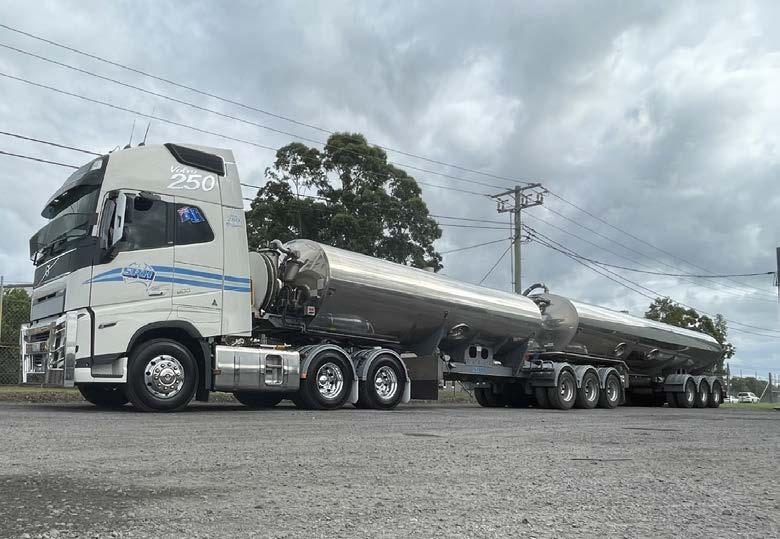
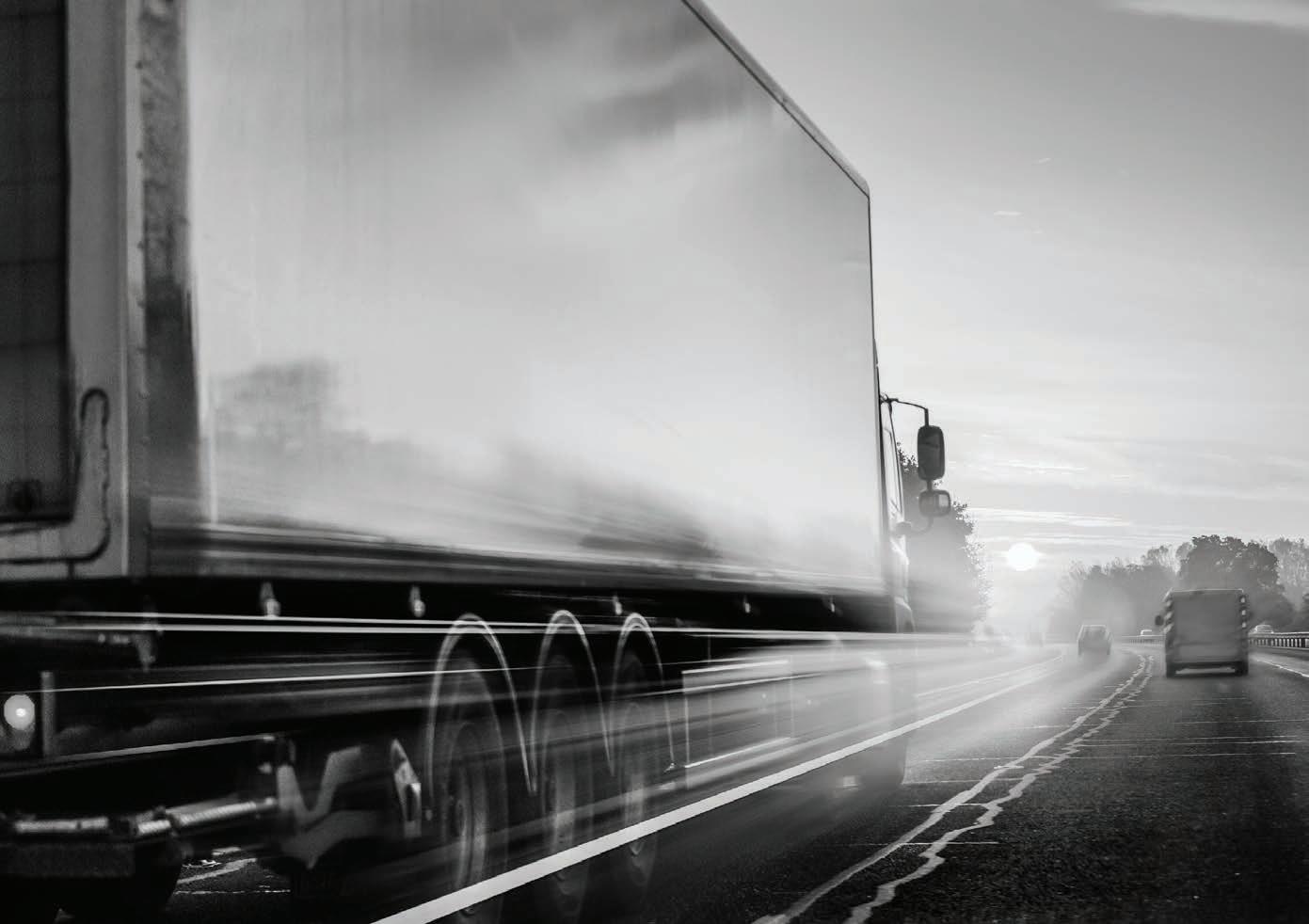
without major intercession from government or industry bodies.
A new preventative safety initiative called Spilt Milk, aimed at reducing rollover incidents through targeted education of drivers, fleet managers and maintenance providers across the dairy
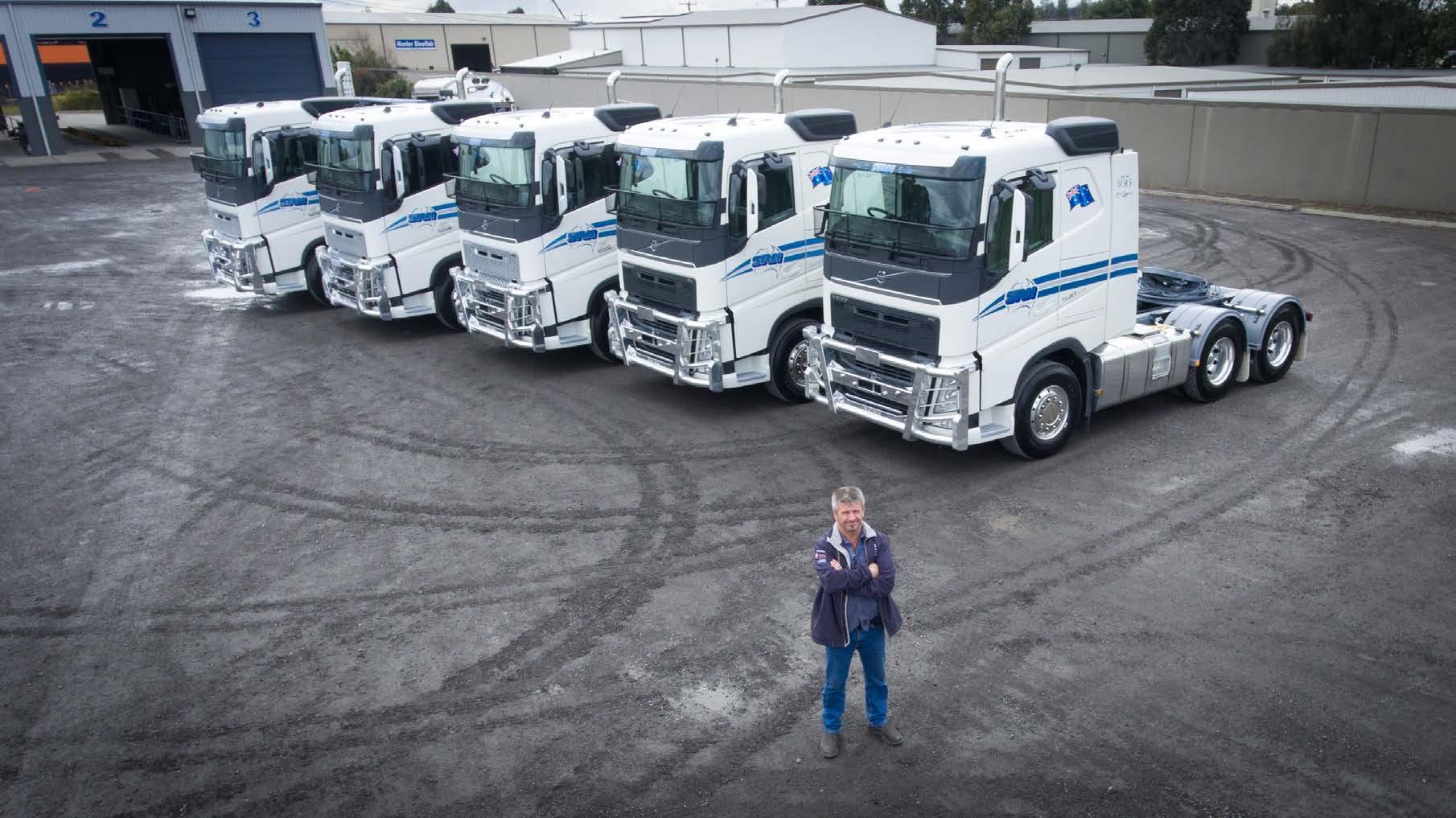
among key stakeholders many of whom were directly involved. Scott’s daughter, Blair Harvey, SRH Milk Operations Manager, was one of them.
“When you look at it in isolation even though there’s not an industry standard for milk transport drivers you can see with those companies that took part in the NTI workshops that we were all striving for best practice in a similar way,” says Blair. “Safety is a cornerstone of operations and having the best equipment can be critical to maintaining those high standards.”
NTI Transport Safety & Risk Engineer, Adam Gibson and Alan Pincott, representing a third-party, Australian Trucking Safety Services, both visited the SRH Milk Haulage head office. The first official discussion with the fleet sought to understand how they recruited drivers and the reasons behind their equipmentbuying decisions. Alan also joined some of the senior drivers at the business on their runs in addition to a few of the newer drivers to gain perspective of both sides. Any pronounced differences in
66 may 2023
TRUCK & TECH
Scott Harvey and a selection of the Volvo prime movers.
SRH Milk Haulage PBS combination.
their experience were noted. Blair says it was edifying to read in the findings that the milk transport companies who participated in the study were all, to some degree, on the same page with regards to how they operated.
“All in all, we discovered we share many commonalities in how we buy the equipment to the processes of putting on and inducting staff,” she says. “They are related in that sense. The better the equipment, the better the standard of driver.”
Having elite equipment, such as the SAF-Holland Kompensator, helps to alleviate the pressure of labour shortages synonymous with the current market.
“It’s getting harder to find drivers in the industry but by investing in the best equipment it helps put you ahead of the game,” says Blair. “Having that upper market commitment to the top manufacturers definitely helps us attract drivers and keeps everyone safer on the road.”

Names like Tieman Tankers, Byford, Volvo Trucks, SAF-Holland and even Guardian, whose Seeing Machines technology was recently adopted by the fleet, makes the processes pivotal to making a hard job much safer and productive. When it comes to the SAFHolland Kompensator Blair says the benefits are immediate and long-term.

“The roads are not getting better. In fact they’re definitely getting worse,” she says. “Especially when we’re going farm route, so you definitely see a difference there. You need something that moves with the trailer and not against it. Having a turntable like the Kompensator is a big plus.”
Scott agrees. While the Kompensator commands a premium price point, the widespread use his fleet gets out of them more than covers the cost.
“There’s savings just in the longevity,” he says. “They only have to save you once from rolling over or getting out of the bog and it pays for itself.”
Cloud-based job scheduling and dispatch software that delivers •Proof of delivery, time stamped and auditable •Three-way SMS between dispatch, truck & customer •Real-time invoicing •Template driven software - works the way you do •Integrates with existing business tools 5,000+ active users Over 400,000 jobs per month dispatched Customers in 10 countries www.vworkapp.com
TECHNOLOGIES A TALE OF TWO
A real world comparison between diesel-hybrid and current diesel technologies produces some impressive results.
The concept is simple: take two Hino 300 Series 616 TradeAce trucks, fit them up with realistic simulated loads on their Ready to Go alloy trays, and operate them on the same route for the best part of a day and compare the numbers recorded by a Hybrid and a current spec diesel. The 616 TradeAce is powered by a 4.0-litre 150hp (110kW) diesel engine driving through a 6-speed Allison automatic transmission. Of course, it’s impossible to drive two trucks at once so we take the lead
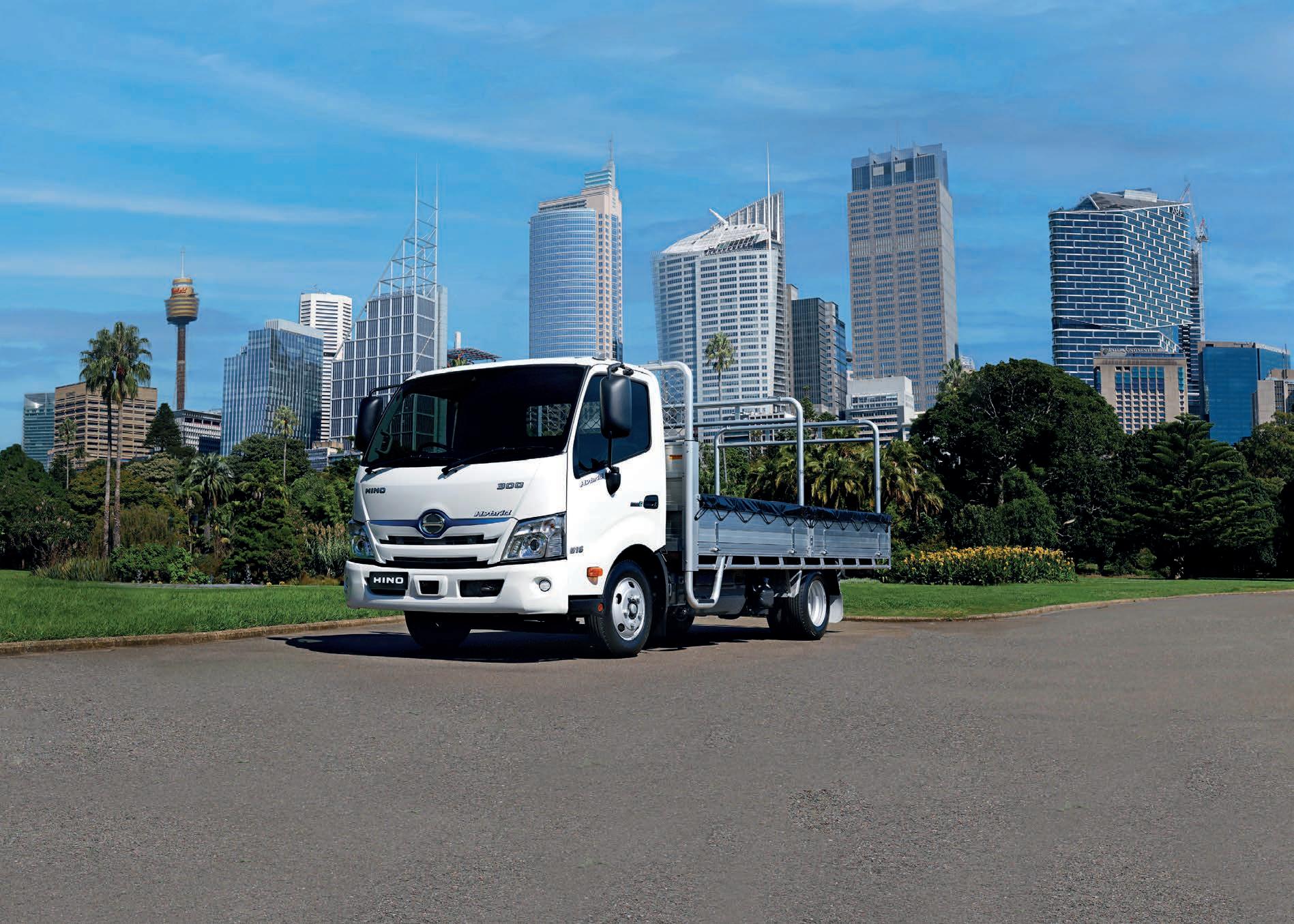
in the Hybrid while a Hino staffer pilots the diesel version and stays close behind us. The planned route takes us on what could, definitely, be a realistic delivery run around Sydney with simulated dropoffs at such iconic locations as the Canterbury Racecourse, Sydney Fish Markets, Barangaroo, and Woolloomooloo as well as the loading docks at well-known hardware chains and shopping centres. The HinoConnect telematics program is utilised to accurately measure the fuel consumption of both vehicles.
Remember, same load and same route at the same time of day (we were actually nose-to-tail for much of it) so same traffic conditions. It could be argued that the only potential variable could be different driving styles, but this is mostly negated by travelling so close together and the results for both vehicles show no harsh braking or acceleration incidents. The Hino Hybrid uses a parallel electric diesel design and a Toyota Group nickel metal hydride battery, which has been used in over 15 million hybrid vehicles worldwide. The Hybrid’s 4.0 litre four-

68 may 2023
TRUCK & TECH
Diesel-powered Hino 300-Series 616 takes a tour of Sydney.
efficiency suffered so went back to automated manuals for production hybrid trucks. The box has a very low first gear and double overdrive ratios meaning hill starts are easy and cruising at 100 km/hr is done at around 2,000 engine rpm. On take-off, the electric motor initiates the drive momentum and once moving the clutch engages smoothly to tap into the power from the diesel. A bonus for maintenance costs is this set-up results in a substantial reduction in clutch component wear as the clutch only has to match speed between the motor and the engine rather than take the strain of the initial take off.
also operates as the vehicle’s alternator for both powering electricals such as lights and the multi-media system, in addition to recharging the main battery and the conventional 12-volt battery. Regenerative braking and battery charging can be maximised by using the wand located on the steering column which would operate the engine brake on a diesel-only Hino 300. Even around town the regenerative braking is very effective and will extend the life of brake components such as pads and rotors. The stop-start system minimises inefficient idling time and we soon become quite adept at anticipating traffic light changes
growing model for the year, helped along with the introduction of the new Alloy Tray and TradeAce Built to Go models to the Hybrid Electric range and can be ordered fitted with a Hino Genuine aluminium tray, ladder racks and a Hino Genuine alloy bullbar on Wide Cab models or an alloy nudge bar on Standard Cab units.
As with other Hino Hybrid Electric trucks, the new Built to Go models include the comprehensive Hino SmartSafe safety package with advanced driver-assist technology including Pre-Collision System (PCS) with Autonomous Emergency Braking (AEB),

primemovermag.com.au 69
Hino 300 Series Hybrid TradeAce.
Pedestrian Detection (PD) and Lane Departure Warning System (LDWS). This is in addition to Vehicle Stability Control (VSC), reverse camera, dual SRS airbags, and four-wheel disc brakes.
Hino announced in 2022 it would be pursuing a renewed focus on the Hybrid and has revised the way it presents the Hybrid equation to customers.
“It used to be how long to pay back the premium,” says Hino Australia’s Department Manager - Product Strategy Daniel Petrovski. “But customers are not buying like that anymore and the payback needs to be on a cash flow basis and at the end of, say, a five-year finance arrangement they also need to have more cash in their pockets with a Hybrid than if they’d bought a diesel.”
Currently the Hino Hybrid has a premium over the diesel of just over $16,000 based on the list price of each truck. Hino has developed a Return on Investment calculator which allows the input of a number of variables including

current and predicted cost of diesel fuel. Hino is being realistic in presenting hybrid-diesel trucks as a solution to emissions issues. There will be Battery Electric Vehicles, there will be Fuel Cell Electric Vehicles and there will be Hybrids. Larger vehicles and long distances do not suit current BEV technology and Australia will require extended ranges for many applications. But in the meantime, smaller vehicles performing metropolitan tasks, similar to this typical stop-start multi-drop exercise, can be contributing to the operator’s bottom line from day one. It’s widely acknowledged that the cost of diesel is unlikely to go down, and although this exercise used the then current retail diesel price of $2.00 per litre, as the price at the bowser goes up the Hino Hybrid presents an even better business case.
During the four or so hours of our trip the diesel Hino consumed 15.7 litres of fuel while the Hybrid only used 11.5
less. Examined on the typical km/litre metric, this converts to 6.13 km/litre from the Hybrid and 8.63 km/litre for the diesel model.
Extrapolated over a theoretical 12 months travel of 48,500 kilometres, the savings are a remarkable $2,973 based on $2.00 per litre. Take it out to 5 years/240,000 kilometres and the Hybrid’s savings amount to $14,868 without taking into account the reduction in maintenance costs associated with operating a Hybrid. And the planet receives a bonus as well. Using the same input numbers the Hybrid emits 511 kgs less CO² per month than the equivalent diesel, or 6,137 kgs less per year.
OK, so here’s the disclaimer: environmental benefits and operational savings will vary according to each application, but we are left in no doubt that the Hybrid’s performance capabilities closely match those of its sister diesel equivalent on what we consider a realistic and

70 may 2023 TRUCK & TECH
The Hino 300-Series 616 is powered by a 4.0-litre 150hp (110kW) diesel engine.


FAREWELL TRANSMISSION
Oakdare Holdings has landed three new Kenworth T659s, marking, historically, the very first automatic transmissions introduced into the North Queensland carrier’s fleet.
In the dusty domain of heavy-duty hauling, even today, a non-synchro manual gearbox is something akin to a sacramental rite. A cultural legacy as much as it is one of competency, the ability to drive stick shift is not as widespread nor as mandatory as it once was. Technical virtuosity, while hard to come by, has been important for the industry. Mastery of an 18-speed
Roadranger might be like having a 9th degree red belt in jiu-jitsu. But in recent times the realm of the roadtrain is being shaped by a host of external factors with vastly improved technologies, skills shortages, and inflationary costs par for the course when it comes to the discretionary spending process of a serious fleet.
Oakdare Holdings, a carrier based
in North Queensland, has recently taken delivery of three new Kenworth T659s. The trucks are powered by a 550 horsepower Cummins X15 which has been matched with an Eaton 22 series Ultrashift plus transmission — the first automated gearboxes in the fleet. The sidetipper roadtrains, rated to 165 tonnes, couple two trailers with a converter dolly and cart coal at a mine

TRUCK & TECH 72 may 2023
Oakdare Holdings works between mining and quarry cartage.
site in Collinsville in the Northern Bowen Basin. Working in the upper thresholds of mass loading, the new trucks, which arrived in a daycab configuration in January, are operating on private mine roads, with a permit for a public road crossing.

The new additions were originally ordered through Brown & Hurley in Townsville as part of a fleet replacement program. The Kenworths they are replacing have, however, been retained and are now deployed in other, less demanding operations after a four-year service life.

Until now, Oakdare has been an 18-speed manual gearbox company.
“These were the first three trucks that our company has ordered with an automatic transmission,” says Wes Connolly, Oakdare Managing Director.
According to Wes, the Kenworth T650
to T659 models Oakdare operates, are a proven workhorse up in the area the fleet commonly frequents in northern and central Queensland.
“They’re a tough truck,” he says. “They work in pretty trying conditions giving you good service and reliability. That’s what it boils down to.”
The circuit the new Kenworth T659s travel on is 9.5 kilometres one way. But in a 24-hour period an average number of loads can be as high as 30.
anywhere between 13 to 15 times a shift.
“It’s not a distance that gets us but the hours that the trucks do,” says Wes.
The trucks that have been replaced had amassed 20,000 hours during their four years of service.
The contract with the mining organisation requires the vehicles to run 24 hours daily, seven days a week.
As there are not too many more demanding applications for heavy
primemovermag.com.au 73
The new Kenworth T659s.
vehicles, Oakdare has opted for a full heavy duty Dana driveline with a D2000F front axle, 52-190 rear axles and SD350 driveline on a 25-tonne-rated 6-rod rear suspension.
Of the 27 trucks in the fleet approximately 75 per cent of these are equipped with a full heavy duty Dana driveline according to Wes.
“The heavy-duty driveline has given us minimal trouble,” says Wes. “They’re a proven driveline. It’s robust. It’s strong. It’s reliable.”
He adds, “We went for the heaviest one available for a bit of extra comfort and security.”
The fleet runs everything from B-doubles, which is their smallest combination to quad roadtrain combinations that cart quarry products to northern road works projects and mineral concentrate to Townsville Port.

“Probably half of our income is derived from the mining sector whether it be coal or metalliferous transport,” explains Wes.
The other half is derived from general roadworks predominantly supplying
cartage for some local quarries to TMR projects.
Predominantly sidetipper focused on its operations, Oakdare is supplied its AZMEB units by MaxiTrans. Until now, Oakdare has been, as a blanket rule, an 18-speed manual gearbox company.
“We chose the Eaton 22 series Ultrashift plus transmission just for the number of gear shifts that’s required on that job on the short cycle and to reduce driver fatigue,” says Wes. “It gives us more options to employ people that are only familiar with automatics and it opens our range up a bit more in the current employment climate where it’s hard to find people. We need to accommodate everyone for that sort of work.”
Eaton DM clutches, for one, offer durability and performance necessary to withstand the high actuation conditions associated with automated transmission systems. Although it’s too early to tell if the gearboxes have endured less stress given the move to automatics, Wes is hopeful that they will help extend the clutch life.
“That’s one of the big things we’re focused on, trying to get better with automatic boxes,” he notes.



“The gearbox is programmed to start in first gear at every stop and we stop about seven times each way on each trip.
“So clutch life is a critical concern for us going forward and it’s easier on the driveline by taking out a bit of human error which can crop up from time to time.”
It’s no secret that the supply chain acquisition process has, of late, been lengthy. Oakdare, having lodged an order with Brown & Hurley Townsville, who keep full replacement parts on the shelves every time Wes and his team need them, were, thanks to a fortuitous cancellation, bumped up in the queue, after the dealer found them a new built slot. It was appreciated.
“Our lead time didn’t blow out as long as we were expecting,” recalls Wes. “We probably waited less than six months before the time of receiving the vehicles. Our expectation was for a 12 month, maybe even 18-month wait. For that we’re grateful.”
74 may 2023 TRUCK & TECH
A Kenworth T659 triple roadtrain.




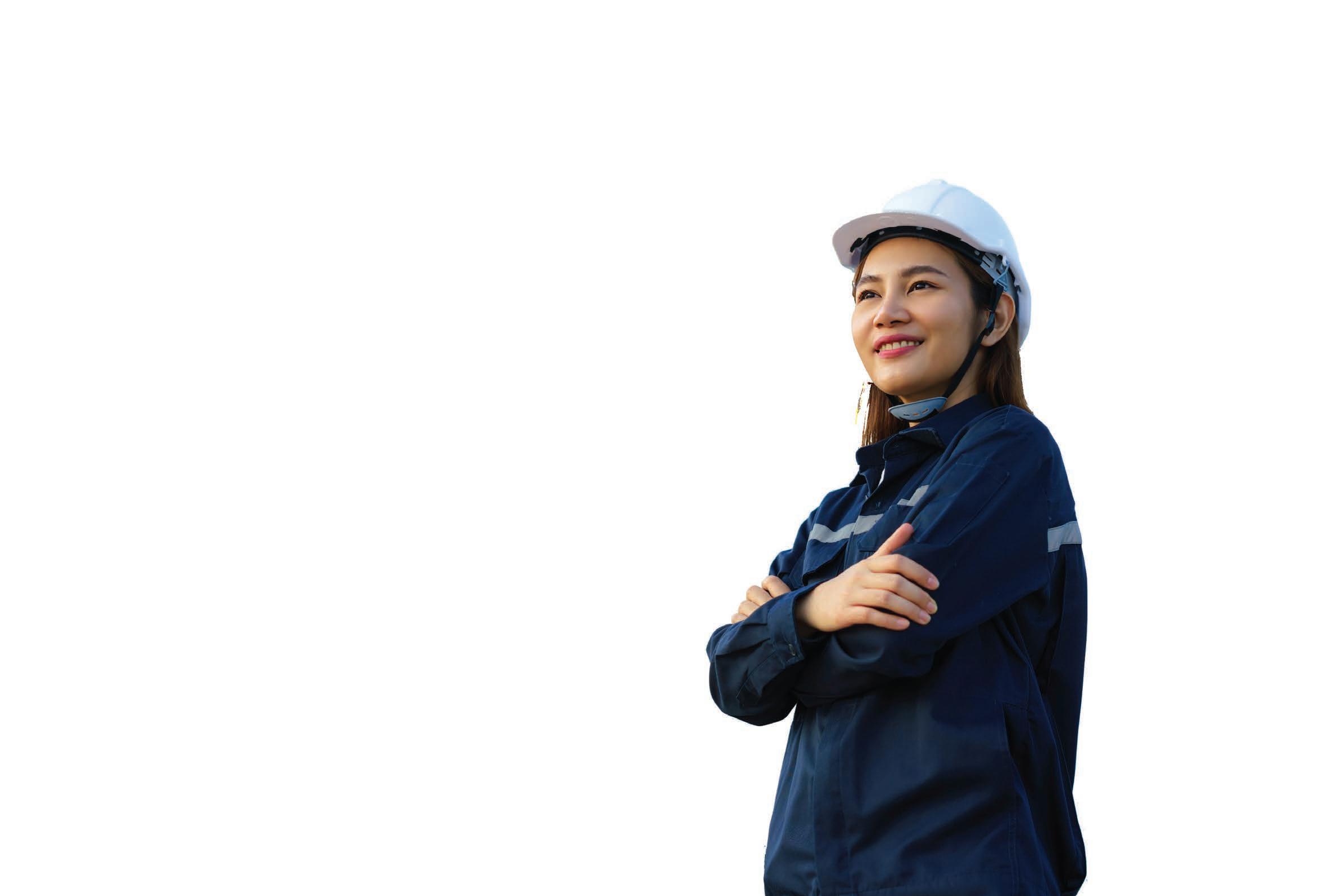


PROUDLY PRESENTED BY MHD upply THURS 8 JUNE 2023 SPONSORED BY Australia
DISPATCH INTEGRATIONS FOR
OPERATIONAL OPTIMISATIONS
As a marketplace, the Australian road transport industry presents a rather distinct set of challenges for fleets. Customers demand they deliver on time; regulating bodies ask they comply to best practice standards; and internal KPIs insist on an elite performance that is reproducible time and again. Data sharing has increasingly, in recent years, pointed the way for top tier businesses to achieve better alignment across these aspirational criteria.
Whether it be for accounting, telematics or task managing, vWork’s off-the-shelf integrations make data sharing between productivity tools easier for fleets in road transport. Many fleets around the world have taken advantage on these integrations and, as a result, have added exponential value to their wide range of services.
Designed from the ground up to be integrated into existing tech stacks, vWork has developed a range of off-the-shelf integrations for accounting and telematics, as well as a flexible API that can connect it with most leading accounting, ERP and CRM tools.
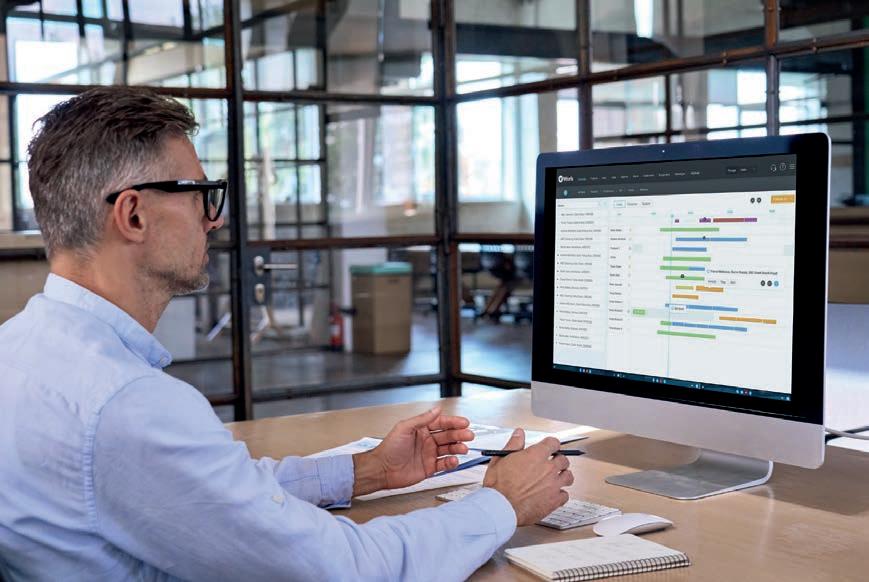
In practical terms this means vWork natively integrates with accounting packages such as MYOB, Xero and QuickBooks and has established integrations to major ERP solutions such as SAP. This enables its users to link delivery directly to invoicing, and according to vWork CEO, Roy Moody,
it means fleet owners can get a highly specialised point-to-point delivery experience from vWork without major technical workarounds.
“When the driver completes a job, an invoice is automatically generated in the connected accounting software,” he says. “This can include details such as distance or time travelled, cost of goods delivered and any additional service charges. Dynamic invoice descriptions make it easy for dispatchers to add invoice detail. The invoice is then ready to send to the customer within minutes of job completion.”
The accounting integration also makes it
really easy to connect existing customers into vWork so you are not double handling information or duplicating customer records. Similar efficiencies are found in vWork’s telematics integrations. Having an off-the-shelf integration with the likes of Webfleet, Navman, Linxio and EROAD enables a whole new level of accuracy in dispatch management. “Telematics integrations with vWork enables you to give dispatchers pinpoint GPS accuracy of all vehicles locations,” Roy says. “It means our customers can invoice with absolute accuracy the distance traveled for each job with a time stamped record of that
TRUCK & TECH 76 may 2023
One of the biggest challenges facing businesses today is integrating all the many and varied applications needed to improve productivity, which is why vWork has taken time out to ensure its dispatch and scheduling software integrates with the major players for Australian fleet owners.
Seamless data flows can be integrated for the convenience of operations staff.
users to replay routes for audit and reconciliation purposes.”
Roy says this is particularly important for highly regulated delivery environments and businesses with complex Service Level Agreements (SLAs) in place.
In constantly looking to deliver the ultimate customer experience in receiving deliveries, vWork also integrates with AskNicely, Salesforce and other customer connected tools to provide an exceptional end-to-end experience.

vWork is designed as a standalone solution and any fleet can get maximum benefit from it as a dispatch and scheduling tool. According to Roy, the fact you can so easily integrate it into your tech stack creates even greater opportunities for enhancing the customer experience and increasing your overall ROI from using vWork.
“We have native integrations for the most common instances we come across and we are constantly adding new ones,” he says.
customised ERP implementations such as SAP or Dynamics, our very open, mature API means vWork can be integrated for seamless data flow. vWork effectively connects the dots between your door and your customer in ways no accounting, telematics, CRM or ERP software can.”

The vast majority of vWork’s customers have reportedly been either trying to manage dispatch on spreadsheets and paper logs or have tried to make an existing solution bend to do something it’s not designed to do.
“In the current environment, ensuring customers get goods delivered exactly when and where they expect to is paramount to customer satisfaction,” Roy says. “This includes the ability to communicate with them every step of the way, prove you delivered to any given SLA if asked, and accurately invoice the completed job.”
What vWork delivers is undoubtedly highly specialised. Its ability to integrate
tools brings that specialisation into the reach of a much wider range of fleet owners.
Akitio Trucking runs a fleet of 30 vehicles and, since starting to use vWork, it has halved the number of calls between the office and drivers, reduced the time spent reconciling paperwork by 75 per cent and time preparing invoicing by 60 per cent.
Akitio Trucking Director, Alexander Hunink, says there is no need to reconcile manual dockets anymore.
“The more we have automated for the drivers, the better off we are,” he says.
“Pulling key EROAD data into vWork streamlines the day-to-day tasks of our drivers. Letting the drivers focus on what they do well and automating the rest.”
Working alongside a user-friendly interface capable of syncing data, systems integration and route optimisation capabilities, vWork can be a complete game changer for fleets looking to optimise their operations.
primemovermag.com.au 77
Invoices for completed jobs can be automatically generated.
TOMORROW THIS TIME
AI -powered systems enable operators to automate higher-level, time-consuming tasks plus predict future problems like mechanical failures and fatigue incidents.
Artificial intelligence is increasingly powering technology within the transport and logistics industries, helping to unlock a huge competitive advantage and future-proofing operations. Piqued your interest? Discover the integral role AI-powered telematics play in the trucking industry at Teletrac Navman’s stand at the 2023 Brisbane Truck Show — the epicentre of industry innovation at the Southern Hemisphere’s largest showcase of trucks, trailers, components, equipment, and tech.
Here visitors can discover how Teletrac Navman’s cutting-edge, connected technology can keep businesses moving smoothly and increase profitability, providing the actionable insights they need to cut unnecessary costs and improve service.
One area AI is having a major impact is on the road network. Transport operators, government agencies, and industry bodies across Australia have realised the benefits of AI tech, leveraging data insights from Teletrac Navman’s Smart On-Board Mass (Smart OBM) and Telematics Monitoring Application (TMA) to assess heavy vehicle access to the state road network, creating safer and more efficient roads for all. With Smart OBM and TMA, operators can move more with less by running trucks at higher mass and using larger vehicle combinations. Through better road access, more revenue can be generated by saving on fuel, improved driver hours, reduced equipment wear and tear, and most importantly, having the ability to take on more jobs.
Less trips can be completed for the same amount of work, freeing up
time, eventually, for more loads to be completed. All this means improved truck movements, reduced CO2 emissions, less maintenance, more profit, and increased safety across the board.
Traditional telematics systems rely mostly on GPS and motion sensors as they collect a narrow set of data points, based on location, diagnostics, and routing. These systems produce important but limited feedback, mostly in the format of tables of data that can be difficult to decipher or understand. In comparison, with an AI-powered system like TN360 or its Smart Dashcam solution, operators can automate higher-level, time-consuming tasks plus predict future problems like mechanical failures and fatigue incidents, but also displays information in visual formats that can be molded into what matters the most to a team or business. The scalable cloud ecosystem that connects data from sensors, cameras, and mobile and third-party applications in real-time, along with artificial intelligence, makes this possible. The ability to capture, connect, and process robust amounts of data with immediacy has transformed telematics saving time and increasing efficiency.
Teletrac Navman’s TN360 highlights efficiency opportunities in areas like route planning, logistic workflows, maintenance, driver behaviour, compliance, and fuel management. Users can quickly receive business intelligence metrics simply by asking a question of TN360’s smart AI engine with voice-command technology, eliminating the challenge of wading through traditional data analytics to find the right information.
Andrew Rossington, Chief Product
Officer, says the Teletrac Navman technology is robust enough to support an entire business.
“Our technology supports all roles in your business — whether you’re a driver or admin staff, right through to maintenance, safety managers and directors,” he says. “Designed to integrate seamlessly with

BRISBANE TRUCK SHOW PREVIEW 78 may 2023
operators can digitise and automate manual tasks to save time, ensure compliance, and improve communication and safety. Instead of relying on timeconsuming, paper-based reporting, they will have access to real-time, intelligent insights gathered from digital reports and live vehicle data.
“This supports you to make informed decisions and streamlines your day-today,” says Andrew. “As a result, you’ll be free to focus on the important tasks in your role and can keep the business running smoothly, maximising productivity, and improving ROI.”
There’s also good news for those who work outside of the transport industry. Intelligent telematics isn’t just for
improve site management, particularly in large infrastructure projects with so many moving parts.
“Using telematics, you can maintain visibility of vehicles entering and leaving your site,” he explains. “For traffic management on large complex jobsites, companies are increasingly using GPS telematics integrated with portal software to obtain visibility across inbound and outbound trucks.”

Via a single system, fleet and operations managers can track when a truck is arriving on site, provide the necessary site inductions, and ensure drivers have had the required rest breaks.

By adding weigh-scale integration, they’ll also know what the truck is carrying at any
gate to use and where to offload.
At the same time, the crane driver is alerted and can be ready to unload as soon as the truck arrives, drastically improving efficiency.
“In terms of budgeting and increasing profitability, you can look at a whole project and its materials to see what requires chasing up or where you need to alter quantities,” says Andrew. “This is critical to ensure you aren’t going over budget and helps you improve the accuracy of future quotes.”
Telematics, ultimately, isn’t just about the here and now, it’s a forward-thinking approach that can help businesses thrive and grow in the weeks, months, and years to come. Are you ready to future-proof
experts at the Brisbane Truck Show - Stand
TRAVELS SAFE
With a growing fleet of utes, trucks and trailers, Scully RSV needed a platform to increase visibility over the performance and safety of its rental fleet, no matter where its vehicles were located. Scully RSV wanted to know that before each vehicle was used, drivers had completed a pre-start checklist – and they also wanted this data readily available, immediately after the check was completed.
Folllowing a review of several digital platforms, Scully RSV approached SafetyCulture to collaborate on developing a pre-start questionnaire. And, after conducting a three-month trial with a sample set of customers to test the system
for themselves, Scully RSV found the answer it was looking for.
“During a course of discussions with SafetyCulture, together we realised that we could actually use their platform to solve our problem, and we ended up doing that,” says Scully RSV CEO, Andrew McKenzie. “The next step is continuing to develop it to make it integrate more seamlessly into our business and other peoples’ businesses as well.”
The system itself is very simple to operate. While larger companies have implemented tablets and more sophisticated systems into their vehicles to achieve a similar outcome, Scully RSV solved the issue with QR codes.

“Every truck and trailer in our fleet now has
its own unique QR code on it,” Andrew says. “You literally just walk over to it and scan it and your phone will automatically open up the asset-specific checklist for that vehicle that needs to be inspected on the day.”
From here the user is prompted to a checklist to confirm, for example, if indicators and brake lights are working. “It’s a simple web-based form, and once you hit submit, it’s finished,” says Andrew. “That’s all you need to do.”
Once completed, the questionnaire goes back to SafetyCulture and notifies Scully RSV that the daily inspection on that vehicle has been done. If an operator doesn’t do the inspection, the system will also send an exemption report to Scully
80 may 2023
Scully RSV has transformed the way operators can complete pre-start inspections through a software, developed by SafetyCulture, which uses QR codes to its advantage.
BRISBANE
TRUCK SHOW PREVIEW
Scully RSV refrigerated fleet at one of its depots.
RSV which is then followed up with an automatic reminder to the operator with a further escalation process if multiple days have passed. Today, SafetyCulture is the largest checklist application in the world. It has over 65,000 organisations using the platform in over 180 countries, and, like Scully RSV’s efforts, the program began with the objective of finding a way to keep people in the workplace safe.
SafetyCulture has been a partner of Scully RSV by previously providing its GPS solutions in addition to working closely with a number of its other providers as well. Andrew says by having extensive experience dealing with its platform himself, he knew it was the perfect choice for this task.
“From our perspective SafetyCulture is a nice fit with our business,” he says. “They’re very likeminded to ourselves and they are very entrepreneurial by wanting to continue to challenge the status quo. We don’t want to sit here and keep doing the same thing every day, and SafetyCulture are the same. They’re a dynamic business, we
giving them visibility over fleet performance and safety,” he says. “Our platform is empowering drivers to take responsibility for safety, and we’re proud to be part of this innovative solution that will make a positive impact in the transportation industry. By collaborating with Scully RSV, we were able to provide a platform that not only gives them visibility over their fleet’s safety and performance but also allows them to take proactive measures to ensure the safety of their drivers and communities.” Looking back on the successful integration of the technology within his own fleet, Andrew believes SafetyCulture’s system is something ideal for scaling up within the wider transport industry.
“For us to be able to provide this as a solution to customers is part of our commitment to continuing to push the barriers in terms of safety and compliance,” he says. “We’ve already had conversations with a number of major transport companies who are really interested in what we’ve done and what we’ve
soon be readily available for other transport providers to access direct from SafetyCulture. With a view to keeping communities safe while adhering to its chain of responsibilities, Scully RSV is now rolling out the safety check across its entire fleet, an initiative that the Heavy Vehicle Industry Australia acknowledges.
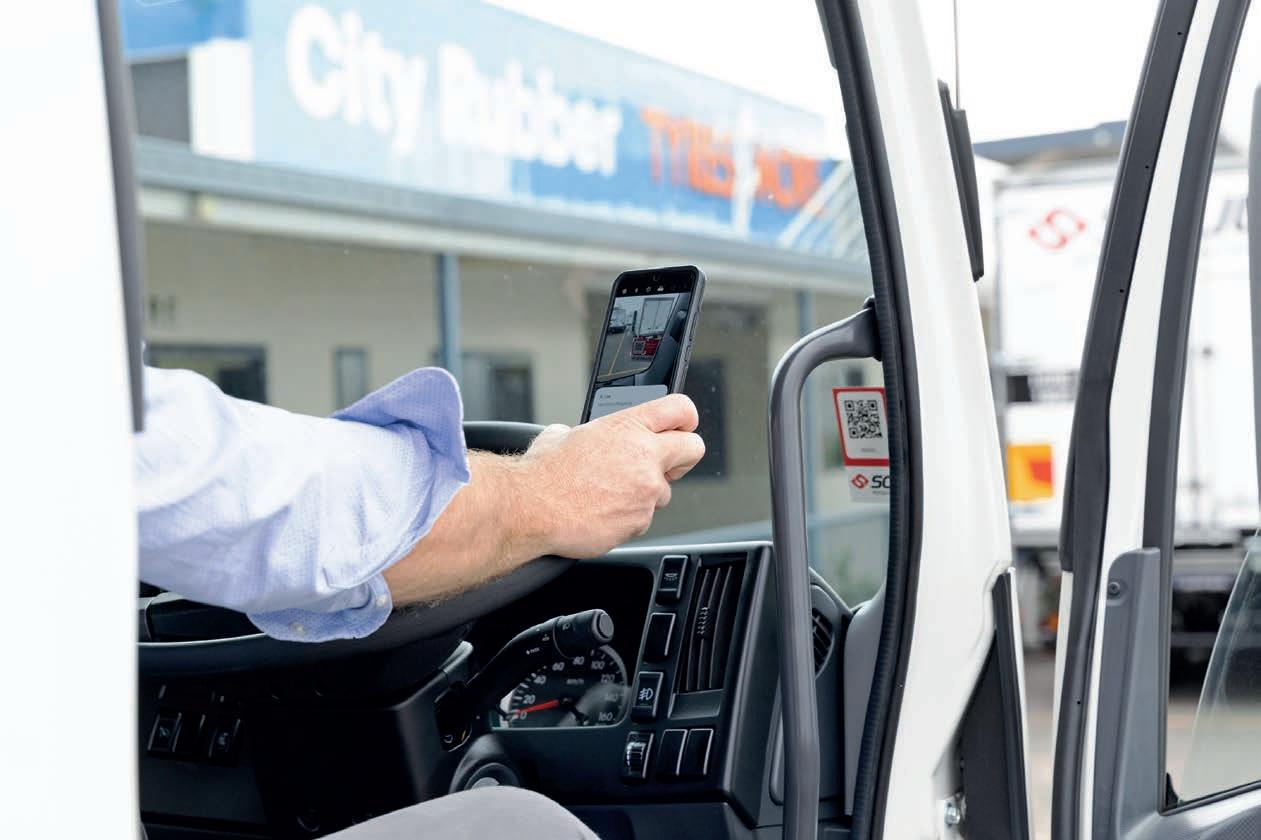

“This is an innovative example of technology being applied to achieve practical and tangible safety outcomes,” says a HVIA spokesperson. “Australia’s heavy vehicle industry is on a neverending quest to make our roads safer, and to ensure that every road-user gets home safely.”

As Scully looks to roll out this initiative to their entire fleet, user education will be key according to Andrew.
“The next part for us is highlighting importance of having to fill out these daily prestart inspections and making it known that it is a requirement,” he says. “If something goes wrong, it will provide drivers with the peace of mind that the information and data is all there. Then,
A Scully customer uses the pre-start questionnaire on SafetyCulture.
JOINT FORCES
For 120 years the HELLA brand has built a global reputation as a leader in high performance and quality products. Last year HELLA was acquired by automotive components manufacturer Faurecia, with the new association helping to establish umbrella company, FORVIA, making it the seventh largest automotive supplier in the world.
As market leaders in different fields, HELLA and Faurecia share in a vision, mission, and similar purpose. That focus extends to the megatrends of the automotive industry, namely autonomous driving, electrification, and sustainability.
Improving vehicle safety and the user experiences while reducing its environmental impact is at the forefront of this combined vision. The HELLA
brand remains a key presence in the design and development of their products and packaging.
The joining of HELLA and Faurecia also brings with it significant market leverage with one of every two vehicles produced globally now equipped with its products.

Through the sharing of knowledge and expertise, along with FORVIA’s noted ambition to reach $53 billion sales by 2025, HELLA Australia Managing Director Darren Robinson anticipates only positive developments and opportunities for the brand’s OEM and Aftermarket customers globally, including those here in Australia.
“With approximately 150,000 employees, operating in 42 countries across 300 sites and with 77 R&D centres housing close to 35,000 engineers, we
can utilise experts across all business areas to support our business here in Australia,” he said. “And with technology increasing at a faster and faster pace, we will be well positioned to offer the products, support and services required to support our customers with innovative new products, and to support the global transition from legacy combustion engines to electric vehicles and hydrogen well into the future.”
FORVIA’s current business and planned growth across global OEMs will likely offer up significant opportunities for local aftermarket customers as high investment in both R&D and innovations ensure a strong supply of new products and innovation. More than $4 billion has already been committed to R&D in 2023. According to Darren this puts the company in a
82 may 2023
HELLA head office in Melbourne.
Automotive supply giants HELLA and Faurecia have combined their collective resources under global parent FORVIA which will make its debut at this year’s Brisbane Truck Show.
BRISBANE TRUCK SHOW PREVIEW
strong position to ensure Australian manufacturers and its aftermarket distributors have access to the very latest across innovations, products, technical information, training and support.
“We will continue to invest and develop our employees, products and service approach in Australia over the next five years and beyond and have clear strategic plans to increase our market shares between two- and four-times market growth, depending on individual customer segments such as Aftermarket, Truck, Bus & Trailer,” he says. “This will be achieved by continuing to offer the latest products, by focusing on customer requirements and by generating market pull for our distributors.”
Through its Electronics and Clean Mobility Divisions, HELLA and Faurecia are winning OEM business for steer-bywire systems, high-voltage converters, radar sensors, shake sensors and intelligent battery sensors. As a group, the company is also heavily investing
in hydrogen related components and systems.
Commercial road transport is very much advancing parallel to trends seen similarly across the automotive industry. Electrification and sustainability being two of the primary drivers. Greater use of electronic components in commercial vehicles, according to Darren, will continue to enhance efficiency and safety gains.
“This is one of the key portfolios that we will expand our offering to commercial transport,” he says. “Providing lighting solutions as a complete package which will improve efficiency for builders”. Regionally, shrewd investment in manufacturing has protected the business from the current uncertainties inherent in supply chains. For its commercial vehicle customers around 70 per cent of the products come from its state-of-the-art electronics and lighting production facilities in New Zealand, where it has been at the forefront of LED lamps since 1990. These products have, to date, received considerable worldwide recognition in the road transport, automotive and safety lighting segments. This year the business celebrates 50 years of manufacturing in New Zealand.
As FORVIA, presently, explores bringing new products to the Australian market it will not only continue to pull products from its existing product ranges but
drive the product development required to ensure local customers receive the right product for the specific application it is intended for.
“At this month’s Brisbane Truck Show we are showcasing our latest transport industry products which provide exceptional reliability and comfort, with installation and repair efficiencies,” says Darren. “One special feature will include showcasing our Plug and Play Electrical Junction Box for trailers to provide better safety, reliability and labour efficiencies. We’ll also have a new range of accessory lightbars, beacons, and work lamps on display.”

Also featured, as part of the FORVIA display, will be a Smart Massage Seat cover and new Black Magic TOUGH light bars. The comprehensive range of light bars are specially designed for tough environments.

On a global scale, FORVIA is implementing an energy transition plan that will include Australia. The company has committed to CO2 Net Zero by 2045. The CO2 neutrality project is managed as part of the “climate strategy and sustainable transformation” initiative, reporting to the Executive Committee. Its holistic implementation includes an operational interface network for all Business Groups and support functions. A monthly and global dashboard of key indexes is used to closely monitor the roadmap and react appropriately. At HELLA’s New Zealand factory, its main supplier for lighting products in the commercial vehicle segment, electricity is sourced from 100 per cent renewable hydro energy. Meanwhile, HELLA Australia has, to date, eliminated 70 per cent of plastic from its product packaging.
“There will be projects that we will also implement at HELLA Australia based on this initiative,” says Darren.
“At HELLA Australia we have transitioned to green energy for sourcing the electricity of our head office by installing solar power in February this year.”

primemovermag.com.au 83
Faurencia Smart Massage Seat Cover.
TAKING
ACTION
Road transport fleets have little more than 12 months to plan contingencies for how they will operate once the longcoming obsolescence of the 3G network in Australia goes into effect. For many, a platform decision beckons that is set to determine operational integrity over the next five years and beyond. Even the best operators may not know the extent of the time that their installed devices in vehicles spend inside and outside network connectivity.
The biggest of the mobile network providers, Telstra, will be the first to abandon 3G as it frees up cellular frequency bands ahead of migration to LTE. At that point, there will be two ways for fleets to be left in the cold, to borrow from Hemingway — gradually and then suddenly.
Geotab, a fleet management and telematics leader globally, can identify which devices are at risk of being without coverage after the shutdown. That’s a major advantage for its customers, given businesses that
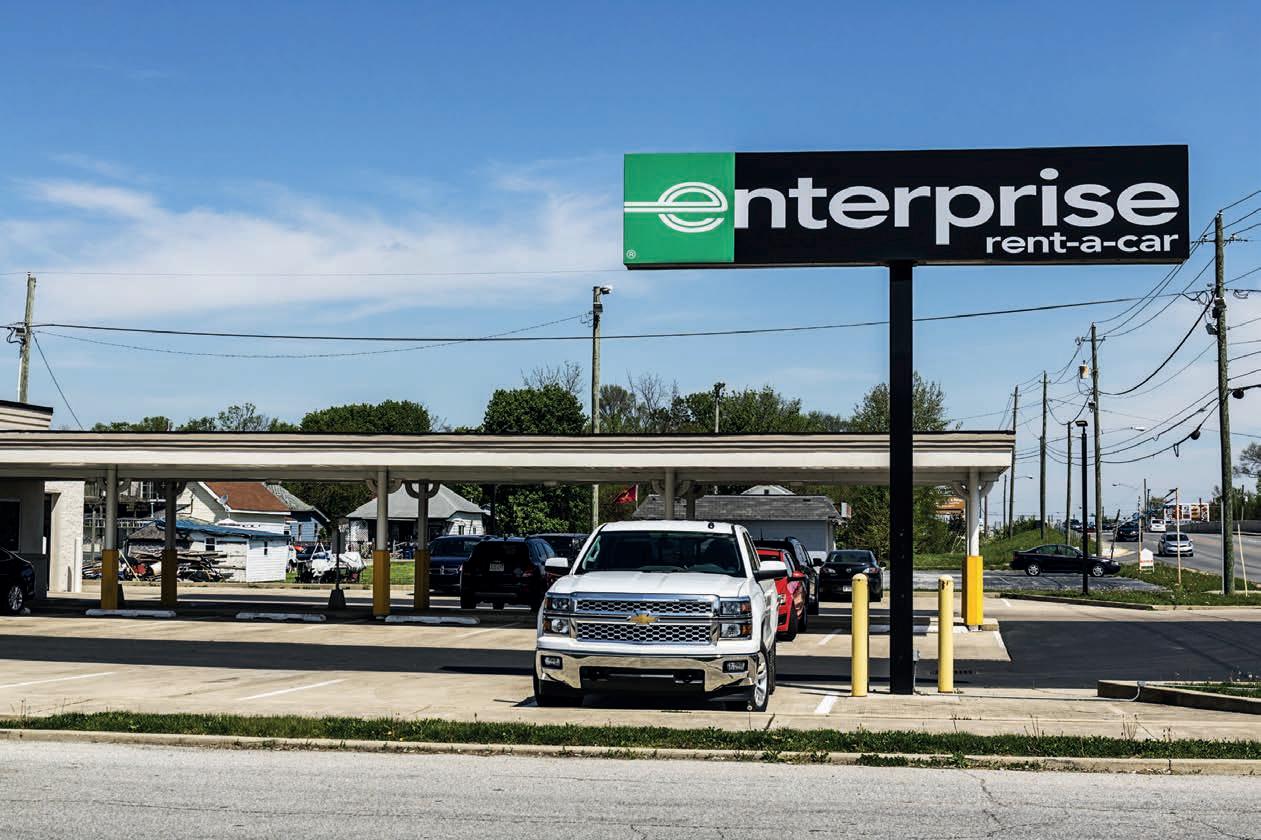
BRISBANE TRUCK SHOW PREVIEW 84 may 2023
In a volatile, fast-changing economic climate such as this one, transport businesses will be hard pressed to find the same level of integrated support and data reporting telematics specialist, Geotab, currently offers its customers.
A Chevrolet Silverado at a rental branch of Enterprise Fleet Management.
reap benefits from big data can’t afford to be estranged from the numbers. Nor will the ripple effect be easily contained. Deprivation of key data sets is going to negatively impact compliance obligations in crucial areas of the business including requirements like finance, environmental outputs and labour practices. New learnings that have been applied to change controls and monitoring to maintain pace with operational procedures such as emissions and freight movements will also be impacted. Many of these daily pressures, what’s more, are going to be exacerbated in a sustained period of economic downturn. To offset losses, mitigate risks, and perhaps even grow, organisations must stay productive. That will mean for transport businesses stretching every dollar further. In a fleet sense, assets might need to be redeployed to cover new areas. Business processes will have to be streamlined and asset utilisation improved.
Capturing and leveraging fleet data can help inform management decisions based on gaps or efficiency opportunities. Fleet replenishment, once a mechanism of road transport conducted like clockwork, is, in the post-COVID world of rising inflation, a fickle enterprise, increasingly spaced out as costs for manufacturing and labour affect vehicle availability, deliveries and eventually their values.
For any fleet overwhelmed by the pressurised conditions of the current market, Geotab can light the way forward. The family-owned company provides telematics technology to more than 3.5 million vehicles and data-driven insights to over 45,000 customers worldwide. Through a suite of over 150 hardware add-ons, software add-ins and applications available on the Geotab Marketplace, it enables users to customise their solution for any task, no matter how immense. The Geotab capabilities are prodigious as the team at Enterprise Fleet Management recently discovered.
Enterprise Fleet Management engaged Geotab to conduct an enormous fleet EV Suitability Assessments (EVSA), one of the
largest ever undertaken in the segment. Recognising the transition to electric vehicles was well underway Enterprise Fleet Management knew it had to base its long-term business strategy on reliable data — not assumptions.
Not only did the study of over 91,000 vehicles allow the team at Enterprise Fleet Management to better understand the market opportunity today, but it also provided valuable insights to further support their customers into the future. The study found that approximately 12,000 vehicles (13 per cent) of the analysed vehicles could be economically replaced by EVs today. Near-term electrification, meanwhile, could achieve a total potential saving AUD$45 million and 194,000 tonnes of CO2 emissions over four years.
“This wasn’t just a study on vehicle availability today versus tomorrow”, explains Dain Giesie, Assistant Vice President of Business Development for Enterprise Fleet Management. “We contributed real-world experience that informed data inputs for depreciation, fuel costs, vehicle costs, after-market costs and more to give us a deeper perspective into our customers’ potential future needs and how we can best support those needs”.
Using aggregated data from Geotab to show how vehicles were being used by Enterprise Fleet Management clients, the two teams were able to produce a factual and reliable suitability assessment on a
scale never attempted before.
With its fleet largely made up of mediumduty work vehicles and utilities, Enterprise Fleet Management wanted comparison data from the EVSA.
As the market expanded, what would today’s EV opportunity look like versus tomorrows? Enterprise Fleet Management already had a pretty good idea: EV pickup trucks were anticipated to play a much bigger role in the future. The study helped confirm this: Up to 45 per cent (approximately 42,000) of the analysed vehicles could be electrified as EV utilities entered the market. From further assessment the business was able to quantify how EV pickup introductions would impact the fleet overall.
“The study highlighted the opportunities and needs of our customers for us,” recalls Dain. “We could keep our strategic planning process on track and continue to be a fleet management leader for those we serve.”
In sum, the data prompted Enterprise Fleet Management to act.
Accurate, real-world data sourced directly from the fleet helps Geotab reduce as many assumptions as it can for analysis and projections. In turn, this will allow its customers to better serve theirs.
Many of the big carriers in Australia, for this reason alone, are going to have to review what telematics can do for their business into the next decade. Preparing for it now will help ensure there is one.


primemovermag.com.au 85
GMC Hummer EV.
SQUEAKY CLEAN
before that, so it’s been a long time.”
As a Kenworth and DAF dealer franchise, Gilbert & Roach were, as a consequence, already a PACCAR Parts agent. So, as Chris says, it made sense to get everything from the one place.
“We were selling a lot of aftermarket items other than the genuine Kenworth and Isuzu product, but we didn’t have a good range of truck wash and those sorts of products,” he says. “My predecessor, who made the decision to start dealing with ITW Polymers & Fluids, was obviously convinced that it was a good product. It definitely has a strong position in the marketplace in among a raft of other different products which do a similar thing, but just not as well.”
Gilbert & Roach is a premier truck dealership for Isuzu, Kenworth and DAF trucks with several locations scattered throughout New South Wales. The company was first established in 1946, making Gilbert & Roach one of Australia’s longest-serving truck dealerships — under the ownership of Suttons Motors.
Gilbert & Roach has been offering products from the Kenworth franchise to its customers since 1981, but in addition to dealing a range of high-quality trucks across three respected manufacturers, it has also established an excellent rapport
with ITW Polymers & Fluids, and in turn, PACCAR Parts.
The relationship with ITW Polymers & Fluids’ dates back to the mid ‘90s. After it began to purchase the Chemtech, Permatex and Rain-X lines directly from PACCAR Parts, Gilbert & Roach has found it easier to guarantee quality and reliability on its shelves.
“We had been selling Chemtech for a number of years before PACCAR Parts saw that we were selling heaps of it and decided to partner with us,” says Gilbert & Roach Huntingwood Parts Manager, Chris Richardson. “I’ve been here since 1996 and we were already selling their stuff
For its entire existence, ITW Polymers & Fluids has had the capability to excel in the market because of its broad product offering. Along with Chemtech, its wellknown truck wash product, ITW Polymers & Fluids offers a series of sealants and adhesives through the Permatex range which are all available at Gilbert & Roach. “They are all very well-known products in the market which have sort of become an industry standard,” Chris says. “We have a large showroom at our dealership where we have a lot of products, and they’ve certainly got a good position in that showroom. And although Permatex is in competition with another really strong brand in the market, we have seen increased sales on Permatex’s product lately.”

86 may 2023
Among the various products and innovations being showcased at Brisbane Truck Show this year, ITW Polymers & Fluids will make its presence known by showing off its highly praised Chemtech truck washes, Permatex adhesives and Rain-X cleaning solutions.
TRUCK SHOW PREVIEW
BRISBANE
Chemtech truck wash products.
when it comes to trucks by gravitating towards certain brands which gain more attention in the industry. With the ability to offer these more popular products to customers directly, the benefits have rubbed off on Gilbert & Roach as well. “It’s funny, because you wouldn’t think



drum of CT18’ and we didn’t have it, they would just go elsewhere. We wouldn’t be able to convert those customers to a different product, they’re just going to buy the one they want from somewhere else. So, in that sense, it’s very advantageous for us to sell Chemtech.”
the reputation of the product. He says this initially influenced Gilbert & Roach’s decision to begin supplying ITW Polymers & Fluids, given that it, not unlike the product’s quality, has continued to impress him over the years.
“From an ITW perspective, they have always offered us a lot of support,” he says. “Bryan, their sales rep, has always been helpful when it comes to us having sale days, events, and things like that. He’s always happy to help by providing material for promotions and things like that.”
And PACCAR, as Chris notes, have been no different.
“They make sure that they have a really broad range of products, and they make it easier to buy everything from them instead of getting it from a lot of different suppliers,” he explains. “When people have a good experience with a product they keep using it, and that has absolutely played a part in the success of Gilbert
primemovermag.com.au 87
Gilbert & Roach is a PACCAR Parts agent.
Gilbert & Roach Huntingwood dealership.
INNOV PARTNERS IN
easy to install and use.
In addition to the HSV Series valves, OMFB will also showcase its 2-function auxiliary radio remote tipper control kit at the Brisbane Truck Show. The product has been designed to be installed in parallel to a manual pneumatic control and allows an operator to control a pneumatic tipping valve by means of a radio remote control and includes shuttle valves and fittings making it ideal for retrofitting to existing set-ups.
Tbeen working together to bring innovative hydraulics solutions to the transport industry for over 30 years. TES and their customers know they can depend on OMFB products to ensure that their vehicles are reliable, safe, and efficient.
TES are at the forefront in the design, supply, and installation of transportation equipment, and have a prolific history of innovation and excellence in the industry. Previously operating as Gough Transport Solutions, the company strengthened its operational capabilities by joining Sime Darby Motors Group in 2019 and rebranded to Transport Engineering Solutions. This name-change reflected TES’s commitment to innovation and excellence, and it marked the beginning of a new era of growth.
OMFB’s origins started in 1950 as a small mechanical workshop in Italy run by three
the post-war rebuilding reconstruction. Over the past 70 years, OMFB have established themselves as an internationally renowned manufacturer of the highestquality hydraulics components serving multiple market segments.
Partnering with OMFB was a natural choice for TES due to OMFB’s reliability, safety, and efficiency; all of which are crucial requirements in the transport industry. TES will be showcasing OMFB Products including the HSV Safety valves at the upcoming Brisbane Truck Show from Thursday 18 to Sunday 21 May 2023. These valves are manufactured to exacting standards, ensuring high levels of safety and reliability. With their pilot-operated design, they offer the fastest lowering speeds on the market and minimal pressure drop. They also feature an emergency override function for added safety and security and a 1/8” to 6mm airline swivel fitting, making them

With TES and OMFB showcasing the latest and greatest in hydraulic technology at the Brisbane Truck Show, technical experts from both businesses will be available to answer any questions visitors may have about their products, system solutions, and future directions in OMFB technology.
 TES General Manager, Paul Lewin
TES General Manager, Paul Lewin
88 may 2023 BRISBANE TRUCK SHOW PREVIEW
TES is showcasing OMFB Products including the HSV Safety valves at this year’s Brisbane Truck Show.
HSV Safety Valve.
YLZ has recently built truck and trailer tipper combinations using TES products.
ATION
says it doesn’t matter if attendees are seasoned industry professionals or just getting started.
“All will be welcomed at the TES stand where they can experience the cutting-edge innovations that TES and OMFB have to offer,” he says. “Technical experts from both TES and OMFB will be on hand to answer any questions visitors may have about our products, system solutions, and future direction in OMFB technology.”
The partnership between TES and OMFB is testament to the ongoing power of collaboration in the transport industry. It was further strengthened following the opening of OMFB’s Australian branch in Tullamarine at the end of 2019, another initiative to best serve its customers.
Along with OMFB’s commitment to manufacture at the highest standards, its has afforded customers high-quality and reliable solutions that will help it to drive continuing innovations and continual improvement for the future.
The customer service the business offers, according to Paul, gives it a major advantage and point of difference from its competition.
“We have OMFB product experts stationed in every mainland state, who are equipped with the latest tools and knowledge to provide top-notch assistance with the fit-up of OMFB products and hydraulic systems,” says Paul. “We take pride in our expanding workshop network, which includes a brand-new fleet of Mobile Service vans staffed by highly experienced hydraulics technicians. With on-site fit-ups and diagnostic support available, our customers can rely on us for efficient and effective solutions.”
Just as the partnership forged with OMFB represents a cornerstone of its success, TES
places a high value on their deep technical expertise and local knowledge.
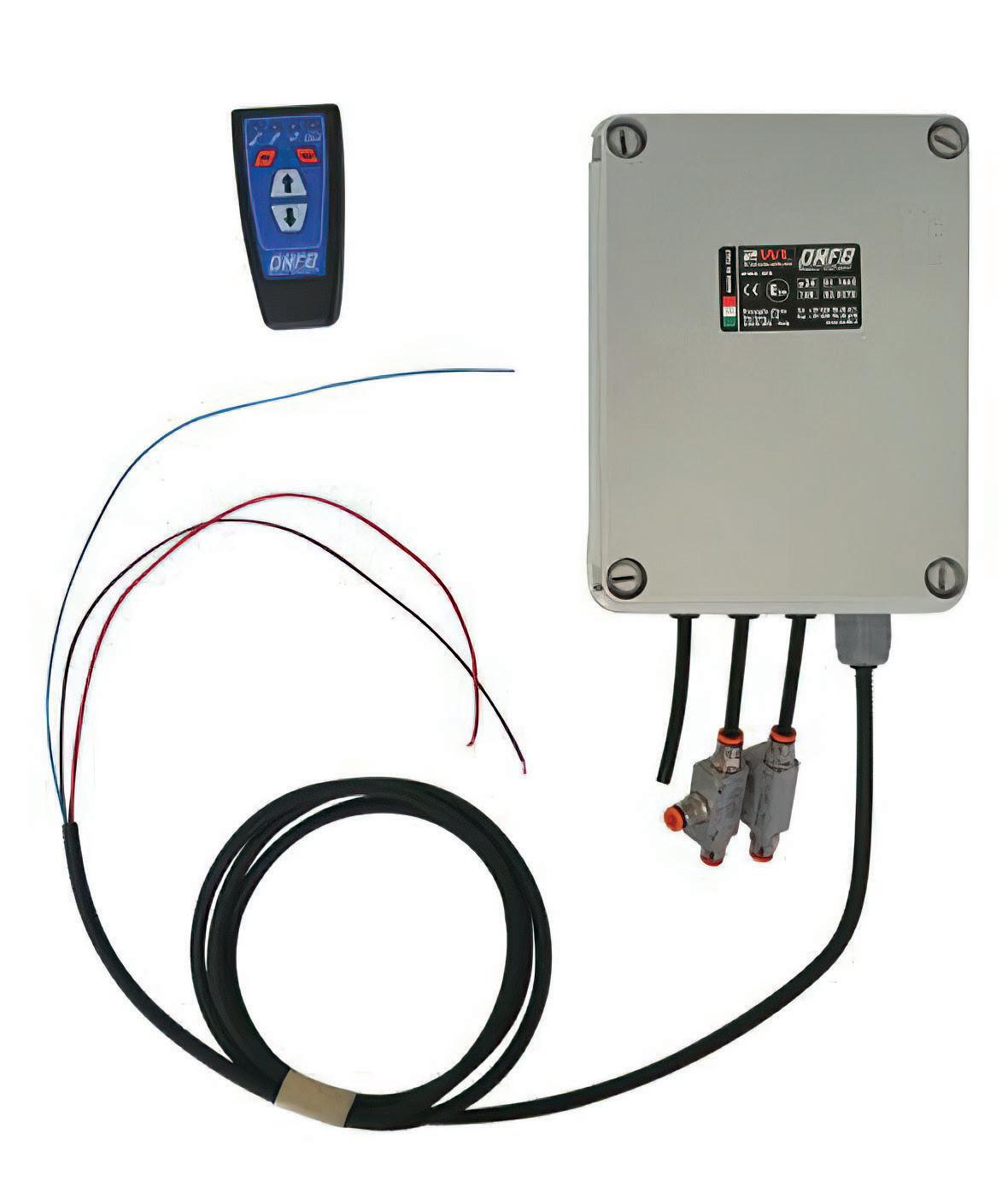
“Their Australian office provides us with unparalleled support and insight, which enables us to better serve our customers and stay ahead of the competition,” says Paul. “Thanks to their expanding local technical and marketing team, we have
been able to strengthen our collaboration and grow our partnership with OMFB even further.”
Visit stall 309 at the Brisbane Truck Show to talk with the team about how TES and OMFB can help with first-class solutions for your hydraulic needs.

primemovermag.com.au 89
OMFB 2-function auxiliary radio remote tipper control kit.
GEAR FINDING ANOTHER
It’s often said that without trucks, a country stops. In a country as vast as Australia, that’s certainly true. Trucks travel thousands of kilometres every day of the year, keeping Australia moving. That’s why Allison remains Australia’s number one choice for fully automatic transmissions in medium duty and light heavy duty truck sales. Fleet owners and operators understand that when it comes to reliability, productivity and ease of operation, no-one comes close.
Australia is Allison’s third largest market behind the US and Canada, according to Robert Cavagnino Australian Sales Manager for Allison Transmission.
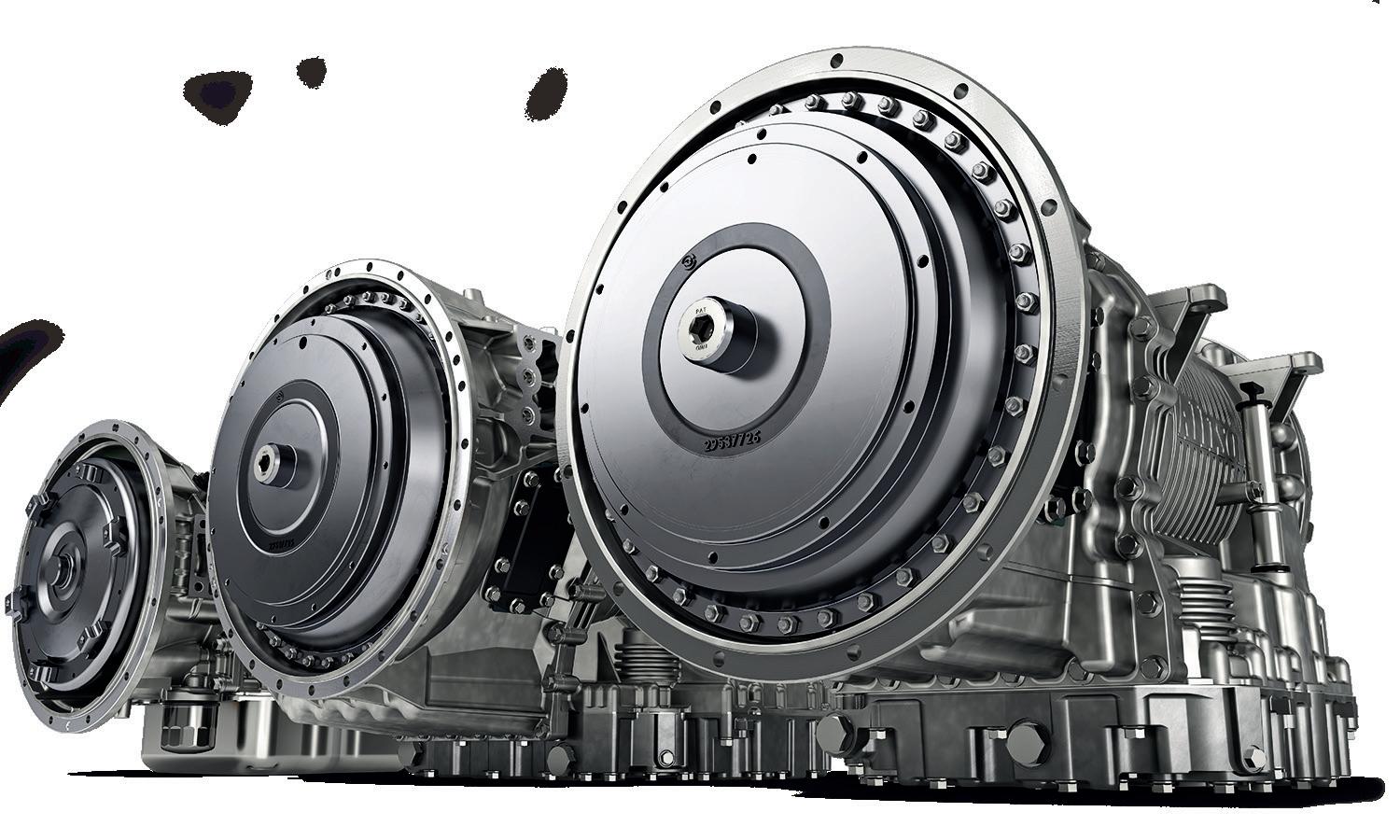
“We have a quality product and work very closely with OEMs to be able to articulate what is needed for the harsh Australian
environment, creating resilient vehicles to overcome myriad challenges,” he says. “A robust fully automatic transmission plays a key role in meeting that brief.”
To keep our trucking industry running smoothly – literally – you need safe, reliable, smooth transmissions. Allison Transmission is the world’s largest designer, developer, manufacturer and distributor of fully automatic transmissions for medium-duty and light heavy-duty vehicles. And it’s why over 300 of the world’s most highly regarded commercial and military manufacturers specify Allison products. But why do they, and thousands of other businesses globally insist on putting Allison transmissions and hybrid propulsion systems in their vehicles? Put simply, it’s because Allison products
make their vehicles, and ultimately their business, more productive.
In the trucking and heavy vehicle industries, productivity can make or break a business. Allison automatic transmissions have a reputation around the world for quality, reliability and durability because they are designed and built to last. They can also help businesses do more work in less time, which is basically the name of the transport and distribution game. How do they do that?
They provide superior startability, faster, more fuel-efficient acceleration, higher average speed, more kilometres per day and as result of all that, increased productivity.
“With greater reliability comes greater productivity,” says Robert. “We know that
BRISBANE TRUCK SHOW PREVIEW 90 may 2023
Once you’ve tried Allison transmissions, you’ll never shift.
Continuous Power Technology allows for uninterrupted engine power to wheels.
our customers rely on our transmissions to make their vehicles spend less time being maintained, and more time making their business profitable.”
In the long-run they cost less due to their unique design which requires less maintenance, making them more economical to run and allowing vehicles to spend more time on the road.
Since Allison Automatics use a torque converter instead of a dry clutch, wear and tear and subsequent maintenance and servicing are greatly reduced.
Of course, every transmission, no matter how well designed and built, will require some level of servicing. And for that, Allison has an extensive network of 43 authorised distributors and dealers across Australia and New Zealand.
Safety is, of course, a huge factor when it comes to medium and light heavy-duty vehicles. And in this area, Allison comes to the fore once again.
“With Allison Automatics, there’s no clutch or manual gear changing.” Robert says. “So driver attention and awareness is maximised, and both hands stay on the wheel during gear changes. In trucks or buses, that’s exactly where hands belong.”
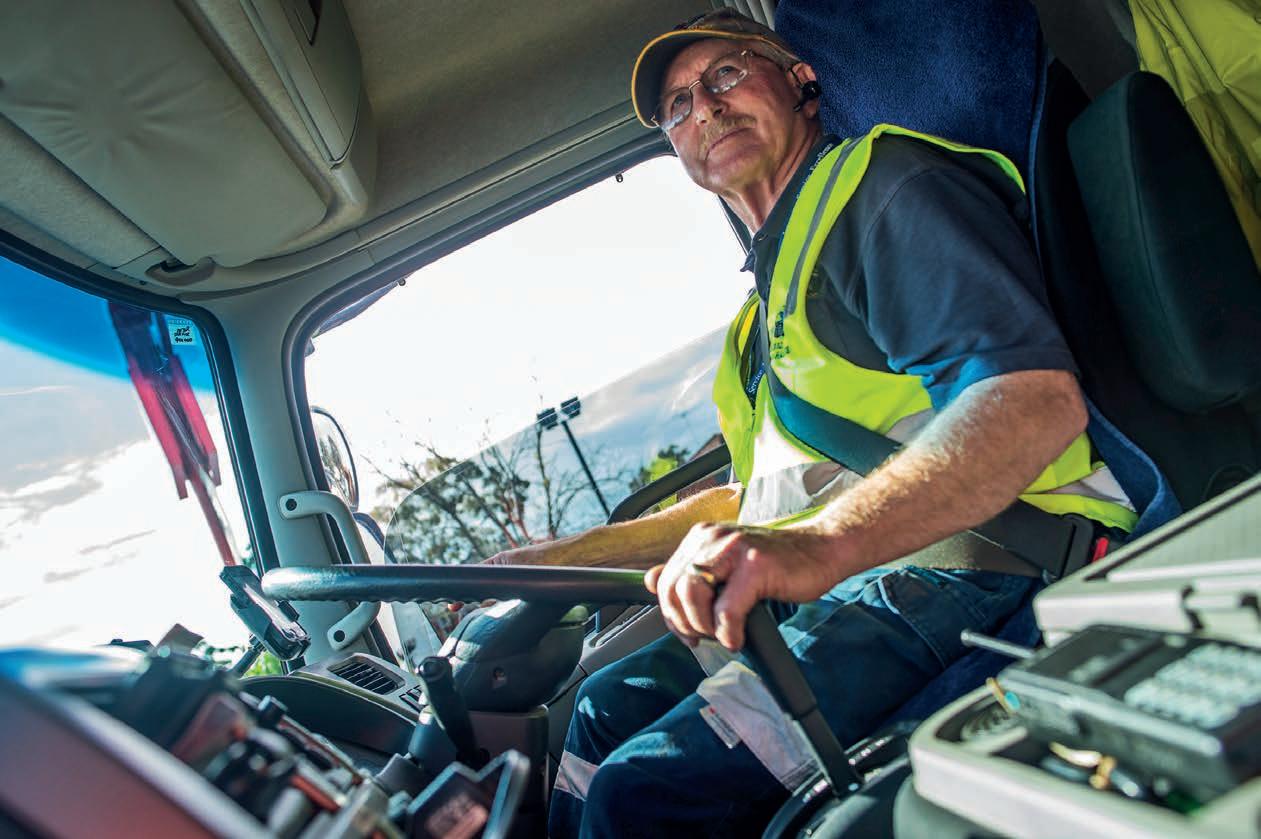
When downshifting, the Allison transmission never misses a gear — the technology makes it impossible. Electronic controls ensure that the transmission is in neutral any time the driver leaves the cab, and the transmission automatically interlocks with equipment like rear door or ramps for added safety and security. Better manoeuvrability is another huge advantage of an Allison Automatic. When driving uphill or downhill with a heavy load, Continuous Power Technology allows Allison fully automatic transmissions to deliver uninterrupted engine power to the wheels, for improved overall manoeuvrability. The Allison Automatic gives operators greater control and makes the time spent out on the street as productive as possible.
Allison’s torque converter creates an infinitely variable gear ratio that further manages power to the wheels. Using just the accelerator means drivers can more precisely control vehicle speed, have more control on gradients, and ultimately protect the driveline from shock and reduce long-term vehicle wear and tear. Delivering greater control, it also provides drivers with the ability to keep both
hands on the wheel with no clutching or shifting. Additionally, it makes multi-point turns in tight spaces more efficient and manageable.
In Australia, a lot of valuable cargo spends a lot of time and distance on the road. Whether it’s delicate machinery, precious gems or livestock, it needs as little bumping and jolting as possible. Allison, as well as anyone, understands these operational challenges. Again, the smooth shifting provided by Allison automatic transmissions eliminates jarring gear changes and creates a much smoother and more seamless ride for both driver and cargo.
It’s this performance that helps reinforce the adage that once a driver has tried Allison transmissions, they’ll never shift. That’s exactly why Allison Automatics are made for Australia.
“You’ll never go back to changing gears manually again,” says Robert. “Having no clutch will be your greatest ally in those clutch moments.”
For Brisbane Truck Show attendees, Allison Transmission can be found at Stand 96.
 Electronic controls ensure an Allison transmission is in neutral when the driver leaves the cab.
Electronic controls ensure an Allison transmission is in neutral when the driver leaves the cab.
CURI CASES
To further encourage best practice across the Viva Energy network, the company has launched Be Curious. The campaign is aimed at empowering employees to raise awareness should they observe environmental conditions, equipment or a process they are curious about that they think can be improved.
One of the first exercises of the campaign was a safety day held at Viva Energy’s North Fremantle site in collaboration with Toll Group.
As one of Viva Energy’s main service providers in North Fremantle, Toll operates three prime movers, usually a Kenworth T570, that carry a varied ensemble of lube products such as engine oils and oils for gears, hydraulics and transmissions. Viva Energy stores these products onsite, with various grades spread across 20 tanks.

The trucks have up to six compartments on each barrel and a combined pull of up to 220 litres of lube oils weekly out of the site.
Each truck has a payload of about 70,000 litres and is loaded with a mix of products dependent on the site they are destined.
From North Fremantle the vehicles travel an estimated 15 hours on their journey to the Pilbara where they service different customers across the region.
At the Viva Energy facility, a large amount of demolition has taken place on the site which includes buildings that were part of a disused laboratory.
The footprint from the original building
A company-wide initiative, Be Curious, launched last month by Viva Energy is already delivering results in collaboration with its major partners.
was enlarged during that process requiring the installation of a temporary fence so that the site could be excavated and prepared for a new soak pond and eventually an adjoining sealed road. This has restricted the turning circle of Toll’s B-doubles according to Sebastian Scata, Viva Energy Perth Site Coordinator.
“We had some preliminary discussions with Toll and decided to eat into an old garden bed that was previously not causing any encumbrance for them,” he notes. “What we ate up as far as the old footprint of the lab goes, we added to the garden bed in anticipation of a new bitumen road.”
Initially the drivers who were part of the consultation had given the site their blessing as to the new turning circles now imposed on them. When it came to allocating the fence and pushing out the garden bed, which would likely affect the approach of vehicles, there was some reservations raised by two of the drivers on the day with operations staff. The additional restrictions, it was put forward, were likely going to detrimentally impact the flow of their turning circle. Rather than just assume all would be fine to proceed, the group decided instead to do an exercise and liaise with the contractor onsite to include all stakeholders. An orchestrated manoeuvre through the new pathway would be performed in the controlled environment.
“That was a good exercise,” recalls Sebastian.
“There was no requirement or pressure
to speed.”
Drivers were given as much room as possible to ensure they were comfortable. Spotters were put in place to observe the vehicles go through the manoeuvre. After further discussions and a team meeting, the group addressed their remaining concerns. A provision to shift the fence was then actioned. The biggest area of concern, however, revolved around the loading gantry where there were outputs for water and power utilities overhead.
Because part of the road had been closed off for the creation of a soak pond for runoff water and the enlargement of the garden bed, drivers, during the exercise were getting the back of the trailer too close to the overhead gantry during their acute right-hand turn upon departure.
INDUSTRY 92 may 2023
OUS
“It’s an exit loop that needs to be performed to line up with the driveaway after loading,” says Sebastian.
The three trucks that pull out on site have each got dedicated drivers.
“We’ve had a longstanding relationship with Toll and to that extent and at a site level a longstanding relationship with each driver who attend the side regularly,” says Sebastian. “That’s a weekly exercise that we do.”
That familiarity with the drivers
“Then taking it down to that next level with the drivers and having discussions with them onsite when they arrived during the weeks preceding all these works happening and then right up until the day of the safety exercise to determine all of them were comfortable with the new lay of the land so to speak.”
Sebastian adds, “It was basically a working huddle as we went along.”
Everyone across Viva Energy’s operations has been tasked with being curious about
those stories so that other sites might be invigorated and seek to ask similar questions and challenge some of the rules on the sites and, in turn, feed off each other.”
Once everyone was comfortable with the new driveway construction, which involved widening it as far as possible while determining there was no hindrance from the overhead gantry, the project has progressed in the first stage post-trial. The limestone base has since been
 A Kenworth T570 negotiates a tight turn in North Fremantle..
A Kenworth T570 negotiates a tight turn in North Fremantle..
LET THERE BE LIGHTS
Transurban has undertaken a new infrastructure project aimed at reducing congestion in Melbourne’s Burnley Tunnel.
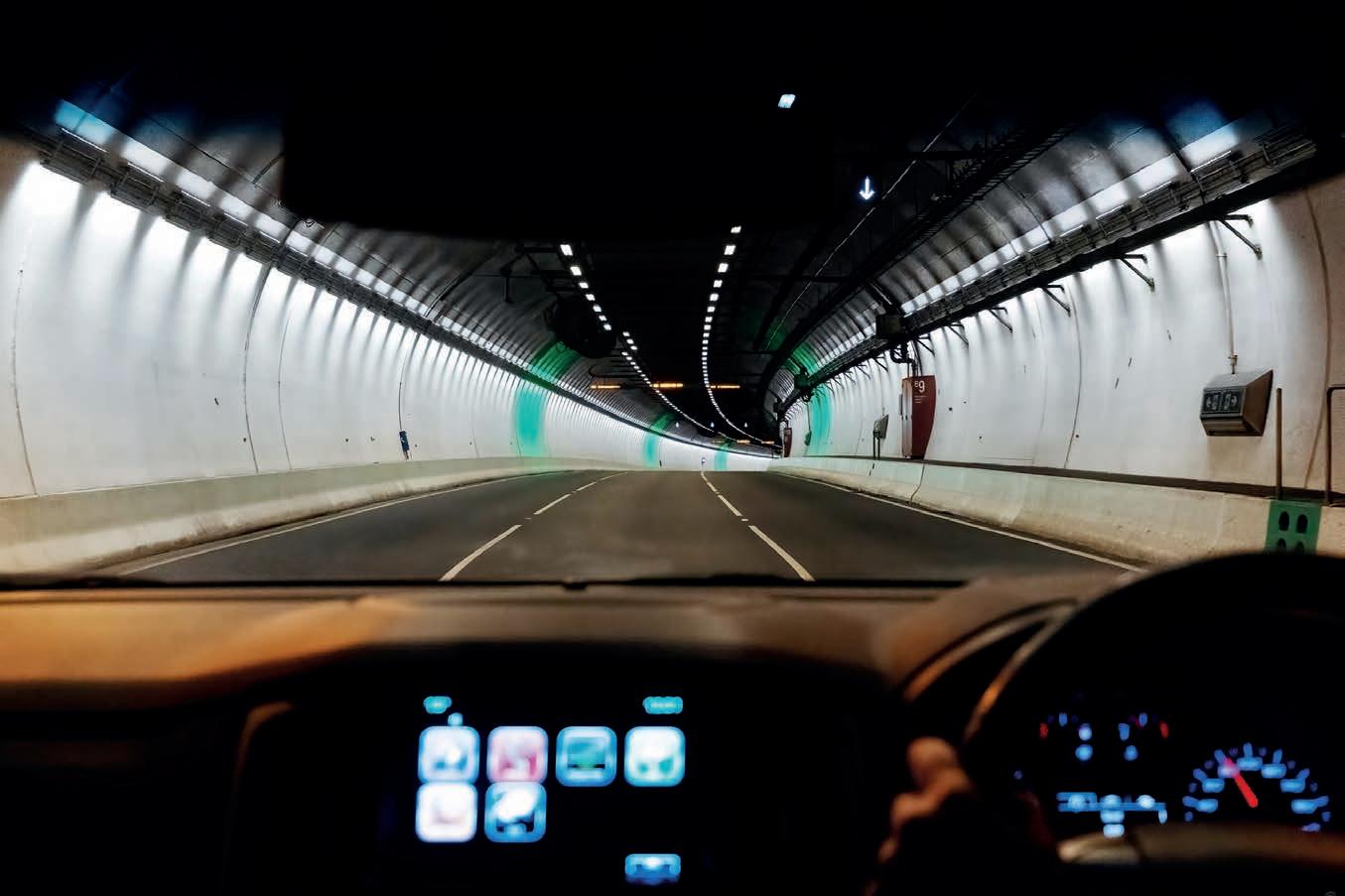
If you’ve come out of the Burnley Tunnel recently and felt like you’ve been subjected to a light show, rest assured, your mind is not playing tricks on you. Transurban is.
Anyone in a car or truck is likely to have noticed the pulsing lights inside the tunnel that follow vehicles as they ascend the steep incline. That incline is important. At a gradient measured at 5.4 per cent it is proving an obstacle for flowing traffic which is, despite the speed limit of 80 km/h, falling on average to 65 km/h at the point of departure.
It’s something of a crucial factor when traffic ideally, by then, should be flowing into the Monash Freeway. Instead, a bottleneck occurs, as drivers collectively resurface from a depth of 65 metres below the Yarra River, are failing to maintain their entry speed. Despite being a three-lane asset, the Burnley Tunnel, which was built in 1999, has had congestion problems for years primarily because of this 1-kilometrelong incline. The problem with infrastructure, according to Phil Naulis, Transurban General Manager Operations,
is complexity. As the Burnley sits in a particular part of Melbourne where two lanes feed in from the right hand lane there are limitations as to what can be achieved. “Whenever you force vehicles to shift and change lanes you cause a congestion problem,” says Phil. “We’re not going to add an extra lane.”
Trucks make up 12 per cent of Burnley traffic. Calls for all trucks to be banned from the right hand lane, proposed by some talkback radio shows, simply won’t work as a measure to alleviate congestion. Pushing all the heavy vehicles out of the
INDUSTRY 94 may 2023
right hand lane would, according to Phil, only create more congestion at the merger site and further downstream from the entry point on the right.
“There’s additional complexity that comes with that,” he says.
Changes to the environment, in short, have been predicated on overcoming a slope, which is highly problematic, given it historically reduces the capacity of the tunnel. The challenge for Transurban was to find extra capacity that it could invest in knowing that infrastructure, once built, rarely can be modified.
As a consquence, it went in search of other examples around the world living with this particular problem.
At a conference in Bordeaux, they soon found it. A team from Tokyo had a fungible stumbling block with an identical gradient and a not dissimilar outcome. Drivers were slowing resulting in congestion.
The Japanese presented the traffic statistics both before and after they implemented their pacemaker light system, a pulsing light now familiar to road users in the Burnley Tunnel that goes down the road at a set speed.
It was for Transurban, what the old timers call a major development.
But with the onset of COVID lockdowns preventing the Melbourne team going to Japan to learn more, they were forced to localise their evaluation.
Fortunately, Transurban has a large customer base, enabling it to draw upon a big volunteer group. These volunteers were, when the time came, covered in heart monitors and eye trackers. As they drove into the tunnel Transurban recorded their experience.

Following this, Transurban created the tunnel as they wanted it to be and as it is now in virtual reality and drove through it, as part of a trial, again in VR. What they were looking for was correlation of the data out of Japan.
The Japanese data confirmed it by showing Transurban the benefit of having a flickering fast moving light in the tunnel. Why is that you might ask?
Studies have shown that humans are preconditioned for fast moving peripheral movement.
“If someone is coming up on your periphery we are preconditioned to catch up or get away from it,” says Phil. “We almost can’t help ourselves.”
Lighting design in tunnels, however, is highly regulated. For one, single points of flicker in a tunnel, are considered taboo. A huge amount of work was therefore necessary in design alterations. Transurban’s safety and human factors teams were engaged to help overcome this problem. Upgrade works included deep cleaning and repainting of the tunnel walls, repairing barriers and installing colourful, more energy-efficient LEDs — 8000 LED segments to be accurate.
maximum speed of 80 kilometres per hour and a maximum differential speed of 15 km/h. There are six sets of sensors all the way through the tunnel. The sensors detect the average speed of each of those points. The pacemaker is then set to run relative to that detected speed to a maximum differential of 15 km/h.
“It will run 15 km/h faster than the slowest speed we’re going to have in there and it will regularly accelerate all the way to the end of the tunnel,” explains Phil. “What we’re trying to overcome is that exit speed of 65 km/h.”
The green pacemaker lighting encourages drivers to maintain a consistent speed through the Burnley Tunnel, particularly on the uphill segment before the exit where traffic most often lags. Drivers won’t need to do anything differently as the green band of moving light provides driver peripheral vision a marker to keep pace. The pacemaker lighting operates 24 hours a day, seven days a week and will move at a speed safe and appropriate to traffic conditions, while never exceeding
“One of the things we found from our studies was the tunnel is too dark regardless,” says Phil. “Yes, they met the design standards in 1995 but those are not the operating standards in 2023.”
Part of the lighting process involved changing the walls to white with a particular reflectivity. White throw on walls has been modified, in fact, to make it feel even whiter. Entry portal treatments were treated to make the interior much brighter on approach.
“We’re using technology and science to overcome bulk driver behaviour,” says Phil. “We’re trying to influence the entire traffic stream, not one driver.”
The pacemaker itself will run to a
In the event of an incident in the tunnel, the lighting will switch off. It will resume only after the road is safely cleared and all three traffic lanes are operating. Internally at Transurban the pacemaker lights are the outcome of a project known as One. The numerical reference in the project title is about shifting the dial one per cent.
“This is about incremental gains using technology to improve capacity,” says Phil. “So, we’re looking at a way of addressing the behaviour characteristics of drivers to create a one per cent shift in traffic.”
At the time the Burnley and Domain tunnels were built, Melbourne was the recipient of world class technology. In 1999, when the tunnels were first opened to the public they were considered cutting edge given they were the first multilane free flow assets in the world according to Phil. “What we are doing now is turning Burnley back to its heritage of world class asset,” he says. “We are changing the way drivers interact with the Burnley tunnel.”
primemovermag.com.au 95
Phil Naulis speaking at the VTA State Conference.
WITH THE FLOW
There have been some significant local changes for IVECO locally as it transitions from operating its long-established manufacturing facility in the Melbourne suburb of Dandenong, to become totally focused on being an importer of trucks, now including the latest S-Way models. A new local engineering and validation facility is under construction near the site of the former factory and the extensive IVECO dealer network has been provided with direction and support for spare parts, training and tooling.
A global product, the S-Way has been designed in Germany and Italy, with local input relative to some of the unique aspects of trucks operating in Australia and New Zealand such as revised air tank and battery box positions and an additional cross member and fuel tank on the AS B-Double model. The S-Way trucks are assembled in Madrid, Spain and use engines produced at the company’s Bourbon-Lancy plant in France.
Already a popular seller in Europe and the recipient of several industry awards, the S-Way increased IVECO’s heavy duty market share in that region considerably in the months following its launch. In the Australian and New Zealand market the S-Way model is available in both rigid (6x2, 6x4, and 8x4 with load sharing front suspension) and prime mover (4x2 and 6x4) configurations. There are three cab options with Active Day (AD), Active Time (AT) and the largest of all, Active Space (AS). Additionally, three cab height options are available across the range to provide a similar yet more comprehensive heavy-duty line-up than was available previously.
To be confident the S-Way will be fit-for-purpose in local applications some 13,000 hours of validation work has already been carried out specific to Australian and New Zealand operators’ requirements. Other extensive trials which were performed in Europe were not given as much consideration due to Australia’s different payload and axle weights, speeds and ambient temperatures. There is a choice of four wheelbases for prime mover variants while the rigids offer ten wheelbase options. Multiple GVM specs across the entire range provide a spread of options and specification choice and makes the S-Way wellpositioned to cater for a broad array of applications including general freight and refrigeration work in both single trailer and B-double configurations, tipper and dog duties and more specialised rigid applications.
Comfort levels of the cabs are enhanced with good ergonomics and plenty of space thanks to the low floor which also enhances access to the new bunks and mattresses on the sleeper models. The under-bunk fridges have been increased in size by 30 per cent and now can have up to 100-litre capacity. Seating consists of new ISRI driver and passenger suspension seats with additional adjustments to provide adequate movement for even very tall drivers. The new steering wheel is typical of the current trend to incorporate multiple function controls at the driver’s fingertips.
AT and AS models are equipped with an ADR 42-compliant sleeper with an upper bunk which can be used for additional storage or as a passenger bed. AS models feature an electric roof hatch as standard (optional with high roof sleeper cab on AT models).
The IVECO engine range begins with the 8.7-litre Cursor 9 which produces
TEST DRIVE 96 may 2023
Following its successful introduction to the European market, IVECO’s latest heavyduty S-Way range arrives Downunder.
GO
360hp and 1,650Nm of torque. Next step is the 11.1-litre Cursor 11 which produces 460hp from 1,500 to 1,900rpm and 2150Nm of torque from 925 to 1,500rpm. The 12.9-litre Cursor 13 is available with a 530hp rating at between 1,600 to 1,900rpm and torque of 2,400Nm from 950 to 1,500rpm. A second Cursor 13 rating sees it produce 550hp from 1,605 to 1,900rpm with peak torque of 2,500Nm
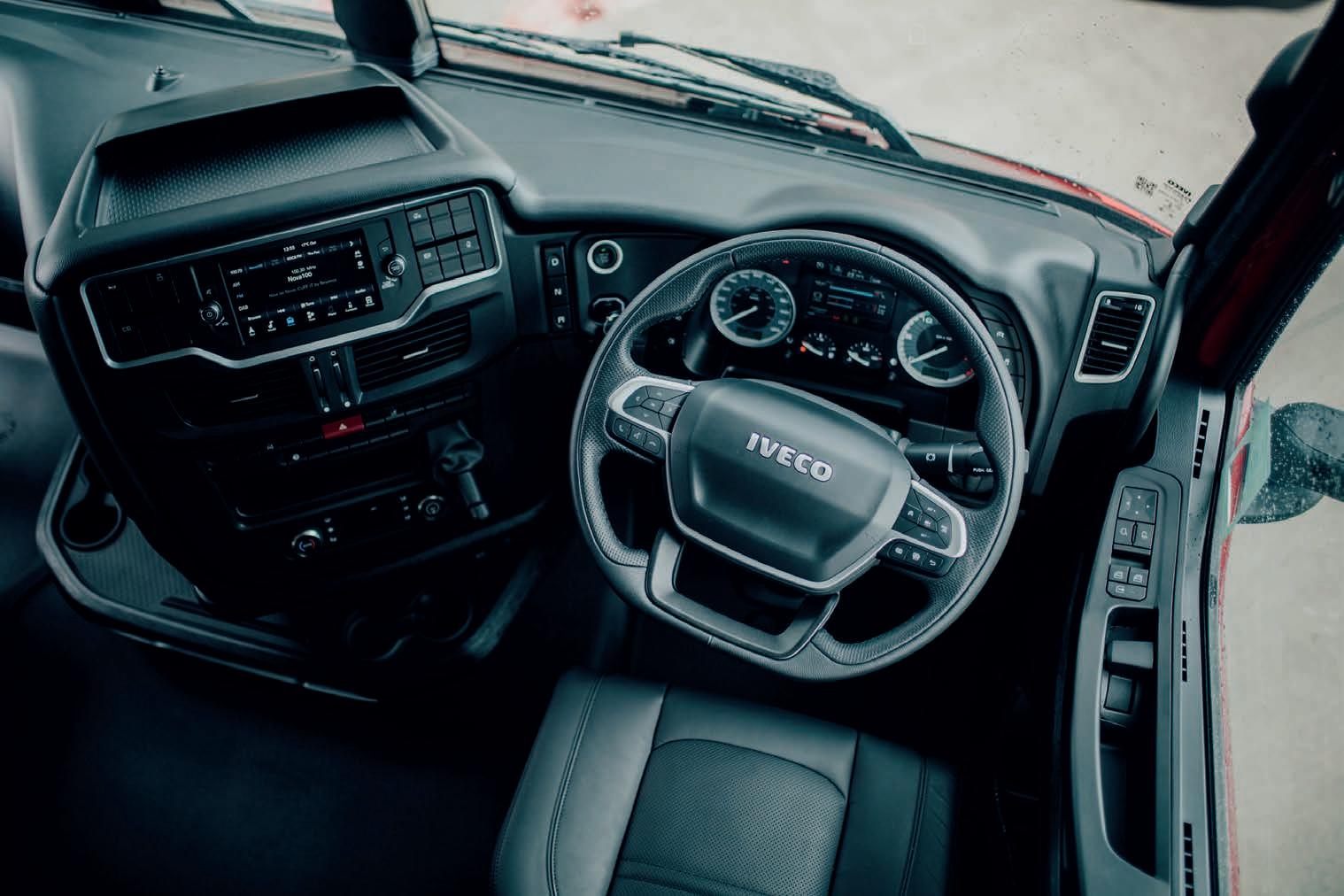
from 1,000 to 1605rpm.
All engines use IVECO’s patented HI-eSCR emission control technology which is a single after-treatment system featuring a passive DPF (Diesel Particulate Filter). An engine stop-start anti-idling function contributes to fuel efficiency. All of the available engines are also fully compatible with second generation biofuels but IVECO seems to be no longer interested
in gas as a fuel which was a focus a few years ago.
Transmissions are the latest versions from ZF, the 12-speed commonly known as the AS Tronic and the 16-speed Traxon. In S-Way installations both now referred to as “Hi-Tronix” and all are direct drive units. During a drive of a 550hp B-double combination the transmission impresses with delivering fast gear changes and
primemovermag.com.au 97
IVECO S-Way cockpit.
keeping the engine tacho within the green band and we look forward to the opportunity to take one onto the highway and experience the ‘HI-CRUISE’ function, a GPS-predictive driving system which integrates cruise control and certain transmission functions to interact to manage speed control, gear selection and Eco-roll in the most fuel-efficient way. The system evaluates continually and in realtime, considering the road profile ahead of the vehicle using GPS, 3D maps and current working conditions, when taking into account GCW (Gross Combination Weight) and the overall drag coefficient. According to these parameters and driver settings, the truck defines the optimal speed and gear (including coasting in neutral) in order to conserve fuel. The renowned ZF Intarder is available on selected models.
Safety is a highlighted factor in the S-Way range and all models feature Advanced Emergency Braking System, Brake Assistance System, Adaptive Cruise Control, Lane Departure Warning System, Electronic Stability Program with ABS (disc brakes all round) and ASR (Anti-Slip Regulation), Hill Holder and Driver Style Evaluation plus Driver Attention Support (DSE and DAS).
by analysing steering wheel movements. If a state of drowsiness is detected, a message on the screen and an audible signal prompt the driver to stop for a rest. DSE analyses data and provides driving advice in real-time which is displayed within the instrument cluster or can be accessed on smart phones using the ‘My IVECO – Easy Way’ app.
Automatic headlights and windscreen wipers are standard and the electronic technology extends to the IVECO DRIVER PAL which is powered by Amazon Alexa,
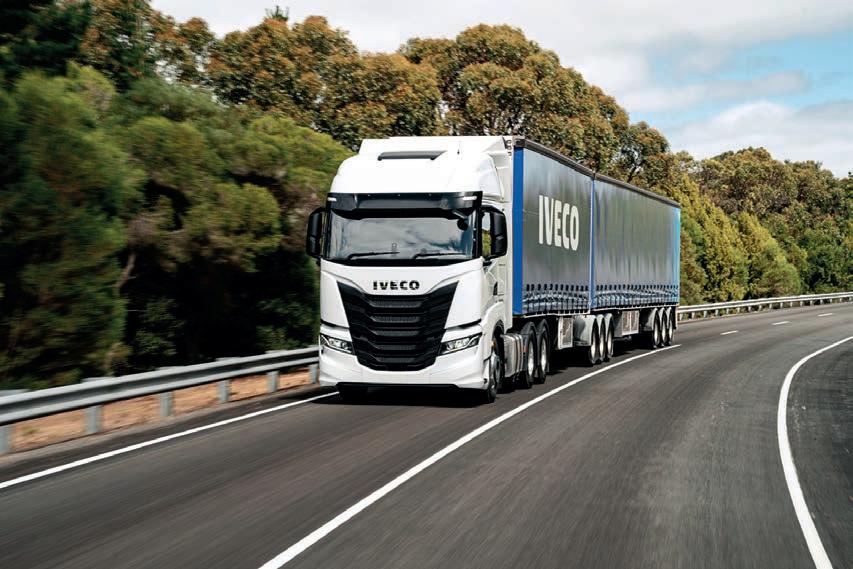
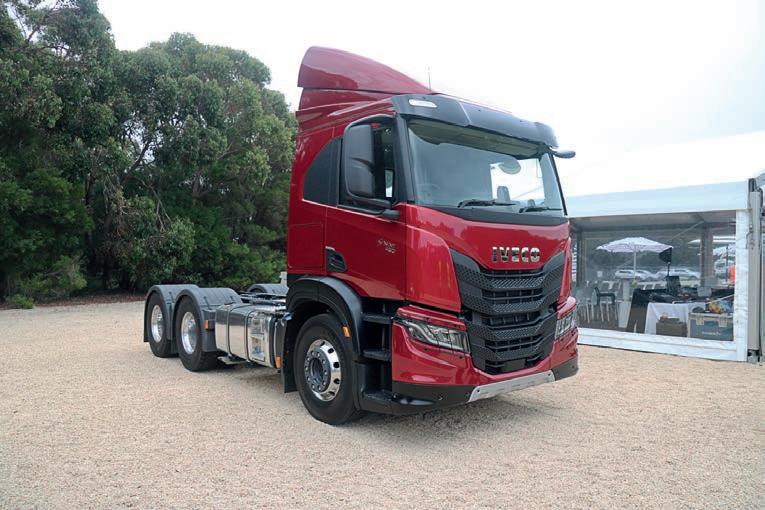
models and allows drivers to conveniently operate all in-cabin controls through voice commands. Externally, this is the most imposing IVECO ever, due to its purposeful and contemporary European styling. The design of the cab incorporates a front -bumper which features integrated deflectors and corner fins, and along with a reshaped roof, new aerodynamic kit (an added cost option), integrated foldable step, optimised mirror design and new door and wheel arch designs. A much better drag co-efficient has been achieved. This improvement in aerodynamic performance compared to earlier heavy-duty IVECO models can result in fuel efficiency increases of up to three per cent. The attention to improved airflows includes an innovative cover on the A-pillars which reduces drag while minimising water stripes and droplets on driver and passenger windows when raining, improving visibility and safety. Side mirrors have also been repositioned to improve rear and side visibility.
At the media launch of the S-Way, IVECO Australia Managing Director Michael May put forth the notion the OEM was looking to become a “humble competitor”. The S-Way range already looks to be more than capable to go well beyond that, with its efficient and proven drivetrains, safety systems and driverfriendly functional cabs.
98 may 2023 TEST DRIVE
The IVECO S-Way is put through its paces in B-double application.
The new IVECO S-Way at its media launch day in Australia.
TOUGH ON THE ROAD
BLACK MAGIC TOUGH
Black on the outside, bright on the inside, HELLA Black Magic Tough leaves nothing in the dark. With 14 light bars in the range Black Magic Tough is the right choice for every situation.


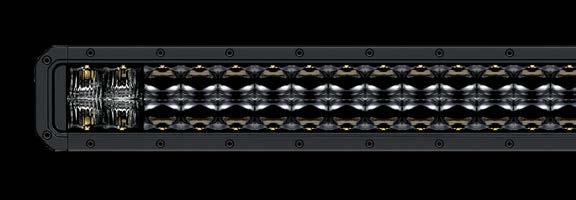

Class leading light output Ample light where it’s needed Up to 20,000 effective lumens
Versatile mounting Upright and pendant
Integrated Thermal Management Less Degradation of LED = Long lasting performance


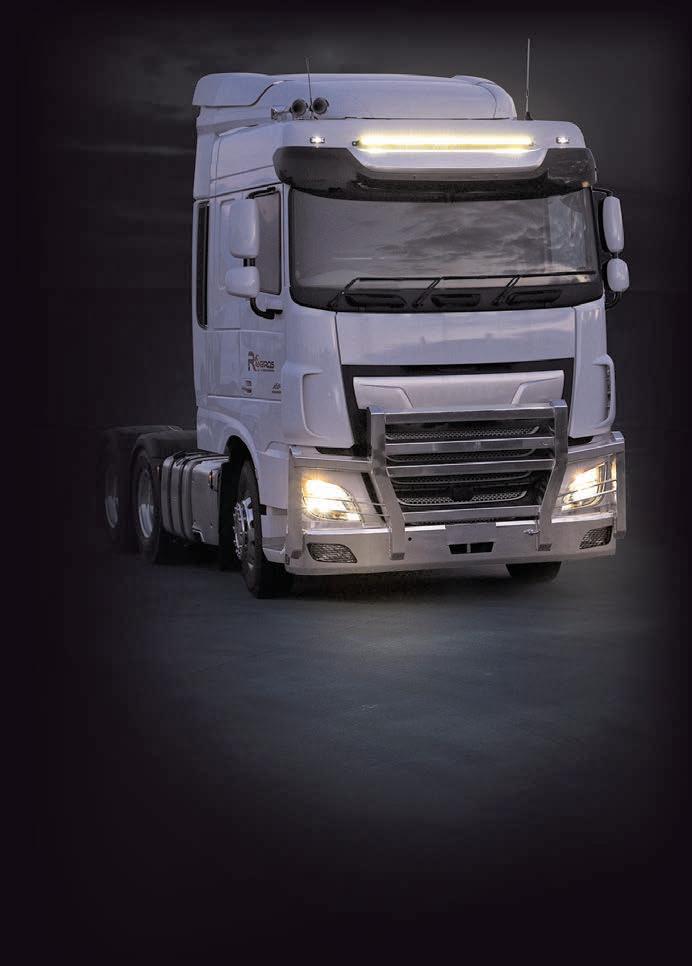
Tough Construction
• Tough design and fully sealed, protects against sand, dust and water!
• Tested against high vibration resistance
Impact Resistant PC Lens Precision alignment for maximum performance and prevents accidental damage
Competitive Price Best performance at an affordable price
Australia
MOVING AUSTRALIA SAFELY SINCE 1961
VISIT HELLA AUSTRALIA AT BRISBANE TRUCK SHOW TO SEE THE LATEST IN BLACK MAGIC LIGHT BARS - STAND #69
360° black out
HIGH VOLTAGE
Ryan Laskey has global responsibility for the strategy, product planning, engineering, and program management for Dana’s traditional driveline capabilities, as well as the electrification portfolio.

surprise COVID quarantines. That does give me some hope that 2023 will be a strong year and I know there’s a lot of pent-up demand.
Despite being his first trip to Australia in nine years, Ryan Laskey, Dana Senior Vice President Commercial Vehicle Drive and Motion Systems, spoke to Prime Mover after a 20-hour flight from Detroit, buoyed by encouraging signs of market recovery.

Prime Mover: Is it difficult to plan product strategy at the moment? Are you seeing any signs in the market to inspire confidence?
Ryan Laskey: I think so. I think we’ve obviously seen unprecedented shortages around the industry, whether it be shortages in material, semiconductors and labour. There’s been so many challenges. These really are unprecedented times. But I do feel that we’re starting to see a little bit of stability. We’re seeing more consistent builds coming out of the OEMs. The labour market is starting to shore up a little bit in most areas of the world. We’re not seeing as many, say,
PM: Have your lead times, in terms of production, begun to find some equilibrium in the last 12 months?
RL: They’re stabilising. If I were to look at it, say a year ago, there were probably ten critical suppliers that we were chasing at any given point in time, and our customers may have been chasing 20 of them. And if any one of those were to go wrong then the truck plants would go down and our production would get stalled. Now there is one or two here and there that we’re still chasing on critical lists, but it’s far less than it was.
PM: What kind of investment is being driven by electric and hybrid programs?
RL: We’ve invested heavily. In terms of who has been on the forefront of zero mission solutions in the industry, we have been, let’s say, considerably ahead of most of our competition and to be honest with you, most of our customers. We’ve put in over $500 million in acquisitions.
That started in 2018. We did a lot of it organically and now we’re investing heavily in expanding our own motor manufacturing capabilities and plants around the world.
PM: Can you talk more about that?
RL: We’ve completely revamped our motor plant in China that’s just outside of Beijing. We’ve just stood up a brandnew plant last year in India producing both high and low voltage motors. We’ve broken ground publicly in a new plant that we’re standing up in Sweden right now that’ll start production in the second half of 2023. So that’s been a heavy investment for us. And we have another new plant soon to be announced in the not-too-distant future for North America that already has walls up. We’re making record levels of capacity investment in our commercial vehicle business.
PM: How much of your R&D spend is allocated for electrification?
RL: Right now, probably north of about 85 per cent of our R&D spend is all going towards electrification application programs.
PERSONALITY PROFILE 100 may 2023
Ryan Laskey.
Yes. Last year we were over $100 million in revenue and electrified products. This year, we’ll be north of $200 million. It’s not only a long-term view. If you look at most of the markets that we initially focused on were bus, and I’ll say medium duty platforms, and those are the ones that are transitioning the fastest. We’re very strong in the bus space today. And we expect close to 100 per cent of transit buses from 2030 to be electrified. It’s not necessarily the long-term because a lot of them they’re here now.
PM: What’s driving the appetite? Is it primarily government incentives accelerating the investment in the category?
RL: When you look at low-speed, lowmileage type usage, the total cost of ownership for just operating those buses it’s cheaper today without incentives. It is cheaper to operate a transit bus on an electrified solution than it is on a diesel or petrol solution. The cost is there already. It’s already saving the municipalities money by transitioning. It’s there in medium-duty trucks right now. It’s there on short-range applications, especially when you have a lot of heavy stop-start, low speed type of usage — refuse, terminal tractors. In hub and spoke type of deliveries the total cost of ownership is already cheaper to be operating electric.
PM: How advanced is Dana’s e-mobility program?
to 40,000 vehicles globally that are propelled by our e-propulsion systems. We’re sitting at over 2 billion miles driven on our e-propulsion systems. There aren’t too many other people in the industry who can boast those two figures there. Most are still talking about millions in their evaluations. We’re talking billions.
PM: Are there any discoveries made in this segment applicable to mediumduty trucks?
RL: One of the competitive advantages that we have in the space right now with as many vehicles that we have on the road and as many miles that we have driven. Now we’re into our third and fourth generations of some of these products. The newest developments are now being built with how to optimise efficiency. How do you optimise performance? How do you optimise power density in our system, say, if we saw vibration issues maybe two generations ago on cable fatigue and questions around optimising switching capabilities on inverters. It’s product maturity that allows us to maintain a competitive position in the market.
PM: Earlier you mentioned acquisitions of which TM4 is one. What has that product suite meant for the Dana portfolio?
RL: TM4 was a good bellwether acquisition for us. We identified early that, in order to be successful, we needed to have three-in-one and four-in-one systems
not going to be able to rely on a supplier partner to be able to do our motors and our inverters. We were going to need to have that capability in house. TM4’s motors are known throughout the industry for their quality and their torque density. That’s been a good position point for us to go with that rather than try to start it or start with a potential partner who didn’t have that same breadth of expertise.
PM: Is there a program in R&D, given you’re into the fourth generation on some products, that has got you particularly excited at present?
RL: Some of the bigger efficiency gains are going to come as you start to integrate your silicon carbide converters. That’s where you’re going to see significant improvements in your efficiencies in the system. It’s ultimately going to allow the OEMs the ability to purchase less batteries in order to do the same job. That’s really where you’re going to see the improvements in the total cost of ownership on a broader scale.
PM: Like, for example, some of the new e-axle systems coming out?
RL: That’s right. Some of the multispeedy axle systems that we have. Those improvements in efficiencies will mean less batteries are required. Or a higher miles per kilowatt hour usage. That’s really where you’re going to see the total cost of ownership start to shift. Those are the things that I look at.

primemovermag.com.au 101
Spicer Electrified Zero-8 eAxle.
BRIGHT
In 2019, Bethany Magill was nominated by NatRoad to be a participant in Canberra at the Daimler Truck and Bus Future Leaders’ Forum, which was run by the Australian Trucking Association (ATA) and supported by Daimler Truck and Bus Australia Pacific. At the time Bethany worked for her parents Alan and Rachael’s company Magill Transport which was named the winner of the prestigious TruckSafe John Kelly Memorial Award in 2022 and was accepted on their behalf of her parents by Bethany at the Trucking Australia 2022 conference on the Gold Coast. Based in Parkes in the central west of NSW, the company was recognised by the industry for its constant commitment to safety and compliance by considering the safety of its staff and the wider public at the forefront of every aspect of the operation.
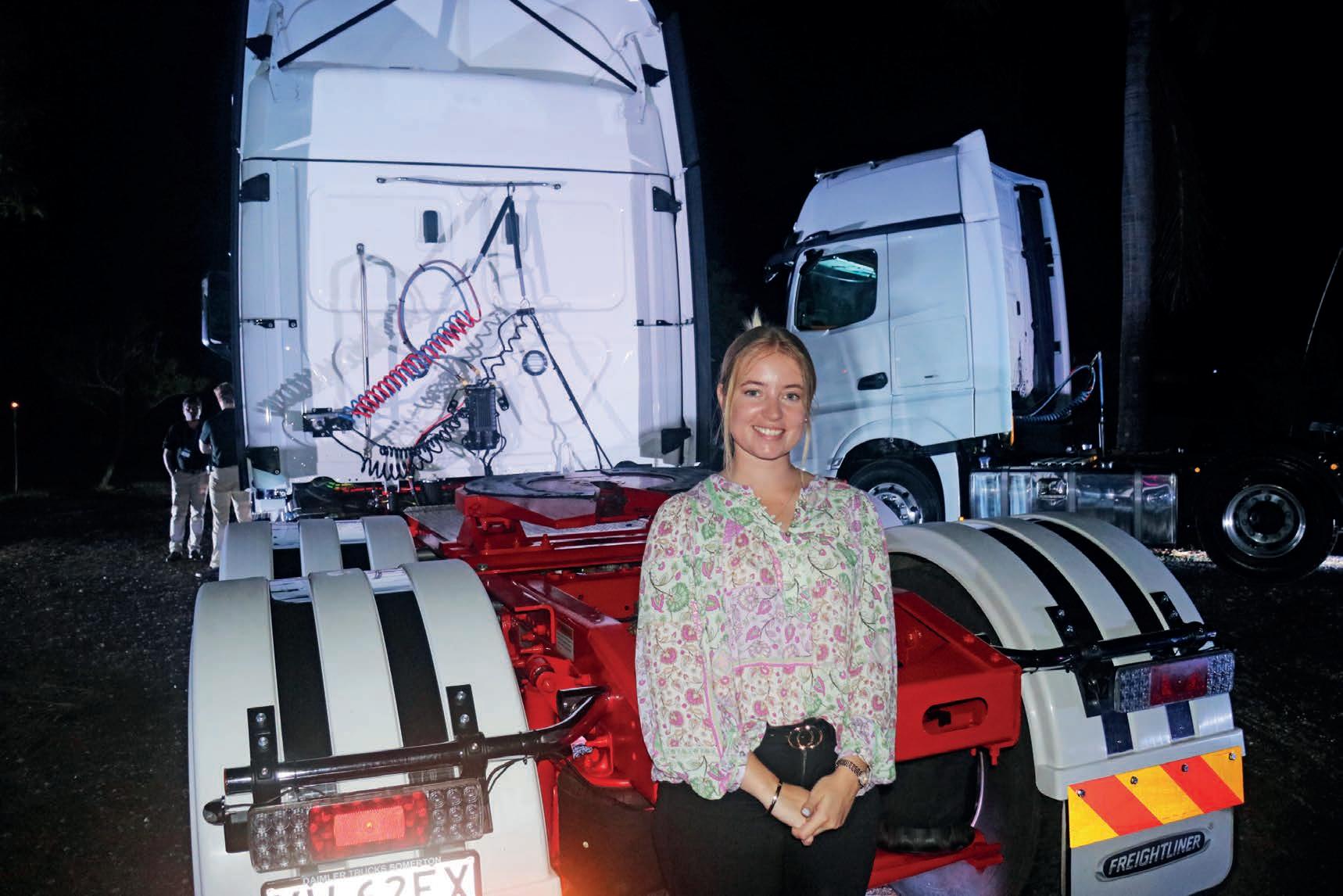
Bethany was Dux of her high school and obtained her roadtrain licence when she was just 20 years of age, and went on to earn her Batchelor of Business credentials in 2021. Growing up in the family business, Bethany gradually became involved in all facets of the operation from logistics through maintenance management, and throughout her time working in a relatively small road transport enterprise she appreciated the importance of goal and target setting. Equipped with natural public speaking abilities, Bethany presented at the Transport Women New Zealand group as part of the 2022 Trucking Industry Summit held in Christchurch. Bethany has recently joined the National Heavy Vehicle Regulator (NHVR) in
the role of the Stakeholder Engagement Officer (SEO) for western NSW. The NHVR Stakeholder Engagement team aims to strategically work with industry, associations, state authorities, local governments and other stakeholders to obtain insights into the current needs and concerns of the road transport industry, while also providing connections with NHVR subject matter experts.
“The role of an SEO is to be an essential common link and go-between for participants in the industry and the NHVR, and ultimately being someone industry is comfortable to talk to, and being a liaison point,” says Bethany. “My role ultimately is communicating with all stakeholders of the NHVR including drivers, businesses, road managers, associations and industry at all levels.”
The new team of SEOs has been established to assist in the transition of the NHVR taking over many of the functions of the Roads and Maritime Services in NSW which, due to its bordering on three states and one territory, has more truck movements than any other state. Scott Knowles is based in Sydney and is the SEO for the eastern region of NSW.
“We already have SEOs in South Australia, Queensland, Victoria and Tasmania,” says Bethany. “I was the last piece of the team covering all of those areas where the NHVR operates.”
Bethany says she was prompted to take on the SEO role because of the opportunity to be able to network broadly across the industry. When asked what she thinks qualifies her for this particular role at such
a relatively young age she draws upon her
PRIME MOVERS & SHAKERS 102 may 2023
Bethany Magill draws upon her industry DNA to create a strong bridge between vital stakeholders in the road transport industry.
STAR
my upbringing I have been exposed to all these different levels,” she says. “I’ve been around truck drivers since the minute I was born and fortunately, through my family, I’ve been involved ever since in industry

as the HVNL review, which among other matters covers fatigue and the approaches to enforcement, there’s feedback to be given and feedback to be received. It goes both ways.”
supported and encouraged her to expand the parameters of her career.
“I have been fortunate through my upbringing in the industry having exposure to a range of professionals
leaning on the experience of my colleagues
Bethany Magill.
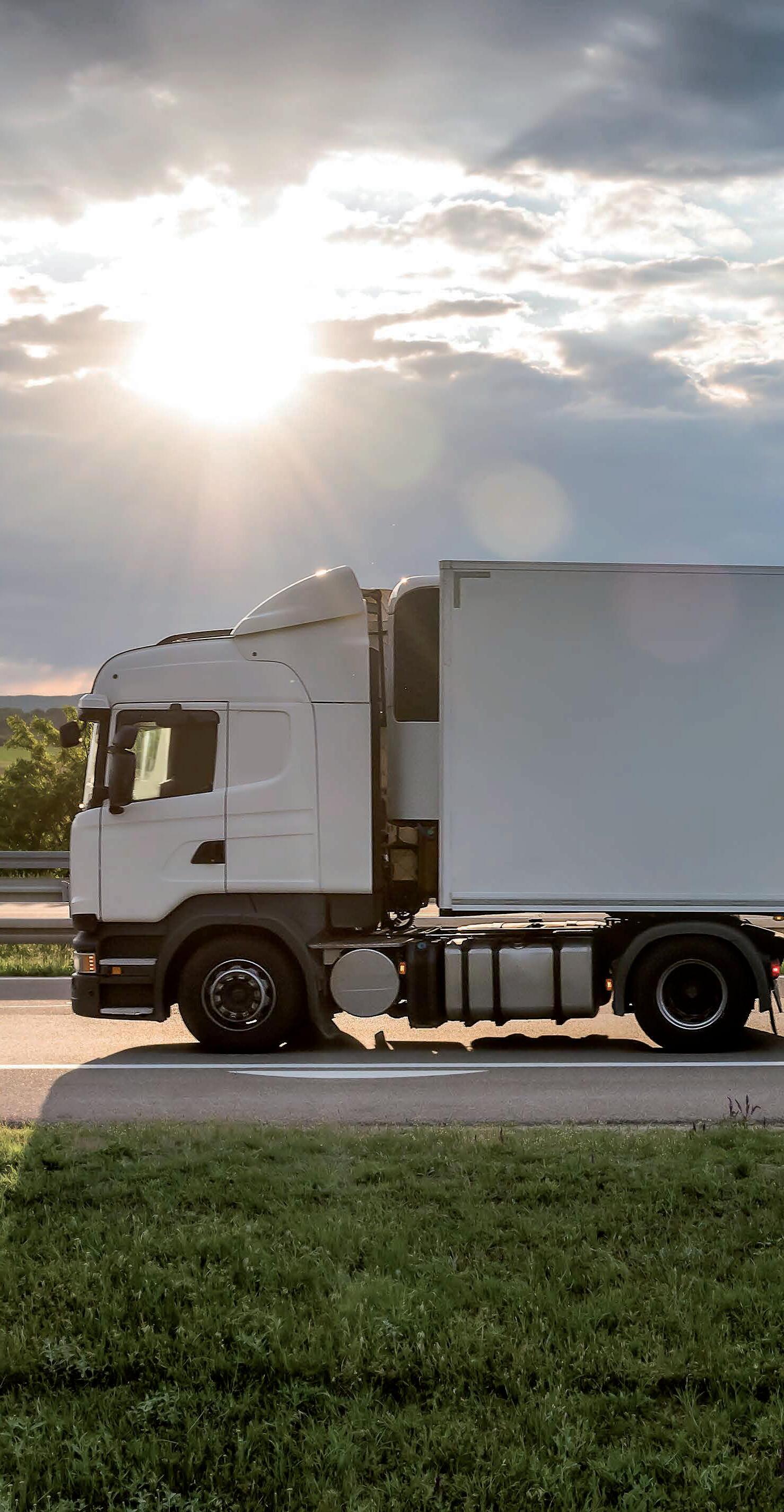

MARKETPLACE ® AUSTRALIA’S DEDICATED ONLINE MARKETPLACE PORTAL FOR BUYING, SELLING AND HIRING TRUCKS AND TRAILERS. Our online marketplace is dedicated to the sale and hire of trucks, trailers and other transport equipment Australiawide. From low loaders and tag trailers to rigid-bodied vehicles and prime movers, you’ll find it here. Whether you’re looking for a deal or keen to sell some high-value assets, we have you covered. For advertising opportunities, contact ben.coleman@primecreative.com.au or call 0466 545 664 BUY. SELL. HIRE. Scan the QR code to find out more.
AUSPOST RELEASES ONLINE SHOPPING REPORT
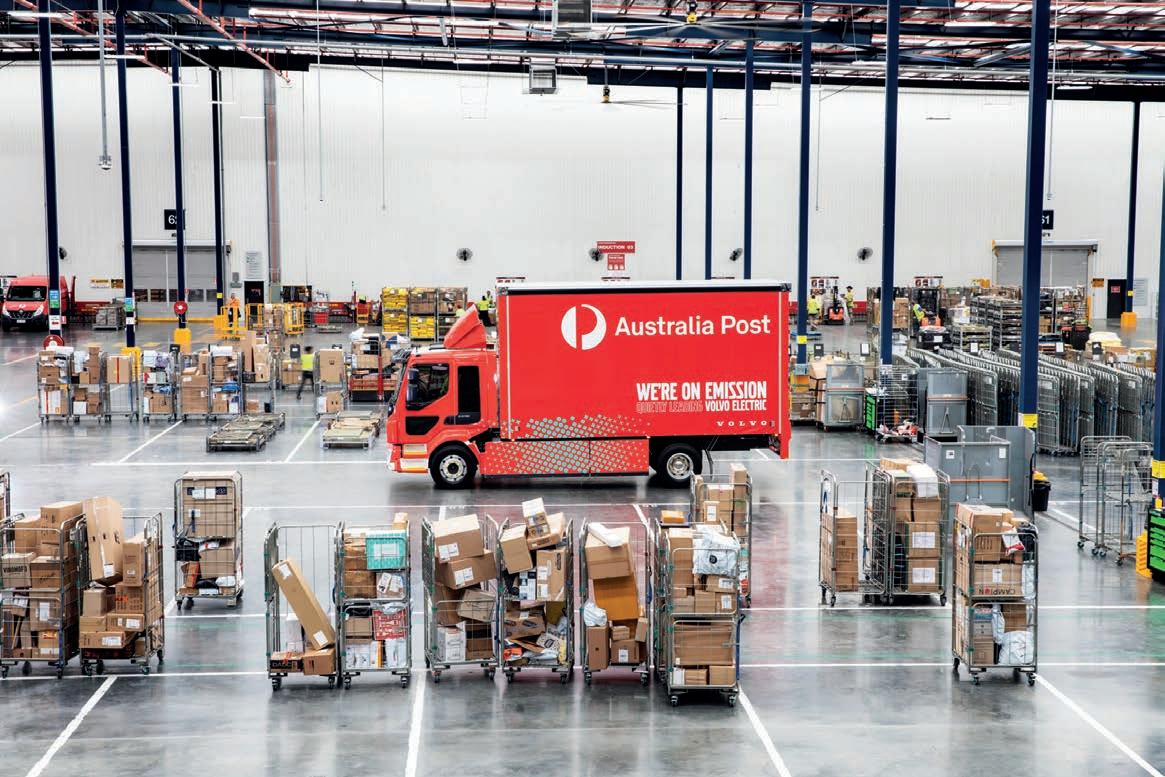
One million more households in Australia are shopping online compared to 2019. That significant jump in consumer behaviour has been noted by Australia Post in the release of its 2023 Inside Australian Online Shopping Report.

The report provides what the parcel carrier calls exclusive insight into the behavioural trends of consumers over the past 12 months.
According to the data, 9.4 million Australian households shopped online in 2022, spending $63.8 billion on online goods.
Online shopping now makes up over 18 per cent of all retail sales. This year, Aussies spent the most on home and garden ($18.7 billion), a category which traditionally has more expensive items like furniture and electronic goods. However, the overall growth was driven by increased spend on food and liquor stores ($13.1 billion with YoY growth of 11.4 per cent growth), as well as variety stores ($11.6 billion with YoY growth of 8.6 per cent).
Queensland saw the strongest YoY
growth in number of online purchases than any other state (11.1 per cent), followed closely by West Australia (11.0 per cent YoY growth).
Meanwhile, consumers in remote and regional Australia continued to embrace the online shopping trend, while, unsurprisingly, New South Wales, Victoria and the ACT came out of lockdown ready to spend big in store. Australia Post Executive General Manager Parcel, Post and eCommerce services Gary Starr said that while eCommerce had moderated with the opening of stores, the shift in the way we work, live and shop is here to stay.
“Aussies’ love affair with online shopping has not waned, even with restrictions removed. One million more households are now shopping online compared to 2019, and 5.6 million households made an online purchase every month during the past year,” he said.
“Australians are shopping online more often, with 37 per cent shopping
online was steady prior to COVID-19 but spiked during restrictions, now it’s showing a return to normal trend growth. By 2033, we expect around one in three dollars will be spent online.”
It’s clear, however, that cost-of-living pressures continue to take effect and overall consumers are more cautious in their spending, creating short-term headwinds for retailers in 2023. MST Marquee Lead Analyst, Craig Woolford said the online environment makes it easy to cross shop and compare to find the best price which can reduce customer loyalty.
“What good online retailers are doing is trying to entice their customers to stay with their platform. That could be via a subscription or other forms of rewards and points to create loyalty, consistency and in return repeat purchases,” said Woolford.
Australia Post said its focus on reimagining post offices will soon see some act as hubs for local communities, with features such as parcel lockers
DELIVERY NEWS deliverymagazine.com.au 105
AusPost’s new Volvo FE Electric in Brisbane.
The new Mitsubishi XRT Concept, planned for launch in fiscal year 2023, has been part of an exhibit at the 2023 Bangkok International Motor Show. It’s a concept car based on the all-new Triton – Mitsubishi Motors Corporation’s top-selling model and global strategic vehicle exported to around 150 countries.
With its full redesign in approximately nine years, the new Triton will be the sixth generation of the brand’s midsize pickup truck. The XRT Concept is characterised by a fierce expression on the front and
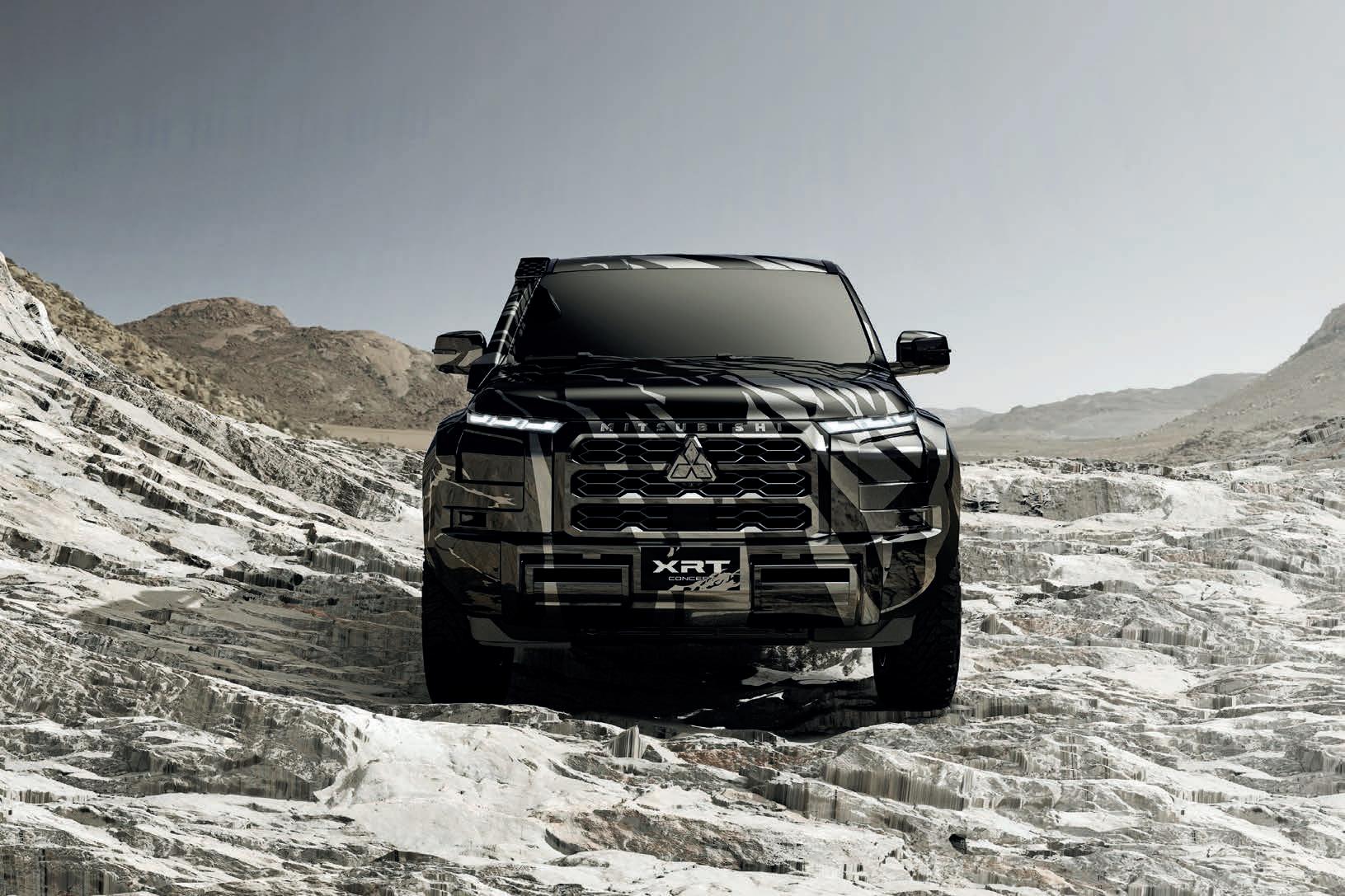
a robust hood that continues to the side with bold, horizontally-themed styling. Further, the concept car is fitted with front and rear over fenders as well as mud-terrain tyres, giving it the powerful drive to compete in gruelling rallies. The body features a camouflage design inspired by lava rocks packed with condensed energy and the sides have been adorned with a graphic of the ten-parallel line Ralliart brand icon that expresses Mitsubishi Motors’ passion for driving.
Mitsubishi Motors President and
CEO, Takao Kato, said the launch of a fully revamped Triton and an all-new compact SUV will allow Mitsubishi Motors to accelerate its business in the ASEAN region.
“The all-new Triton is going through final touch-ups in preparation for its release, as we have performed rigorous endurance tests around the world while also incorporating the know-how gained from rally activities,” he said.
“With the new vehicle launches as the centerpiece, we will continue our drive toward further growth.”

DELIVERY NEWS 106 may 2023
NEW MITSUBISHI XRT CONCEPT TO BE SHOWCASED
Mitsubishi XRT concept.

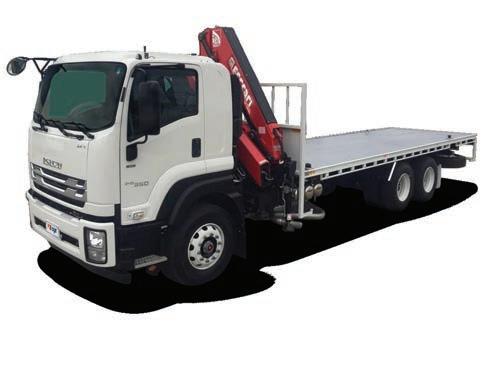

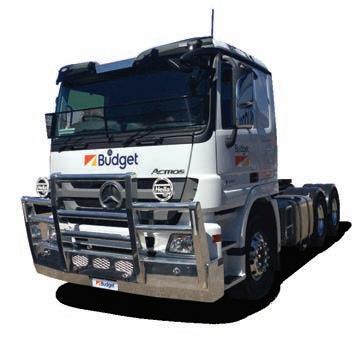
VOLTA TRUCKS RECEIVES
All-electric commercial vehicle manufacturer and services provider, Volta Trucks, will receive funding support from the European Investment Bank (EIB). Venture debt financing to the tune of €40 million ($65 million) will be provided by the EIB to support the Swedish startup’s Truck as a Service (TaaS) infrastructure over the period 2023-2026.

It’s part of a long-term commitment to push the electrification of the road transport sector, by facilitating electric trucks deployment. The project is in line with the European Commission’s comprehensive framework of policies to reduce greenhouse gas emissions, including the Sustainable and Smart
Mobility Strategy (December 2020) and the EU Green Deal (November 2021).
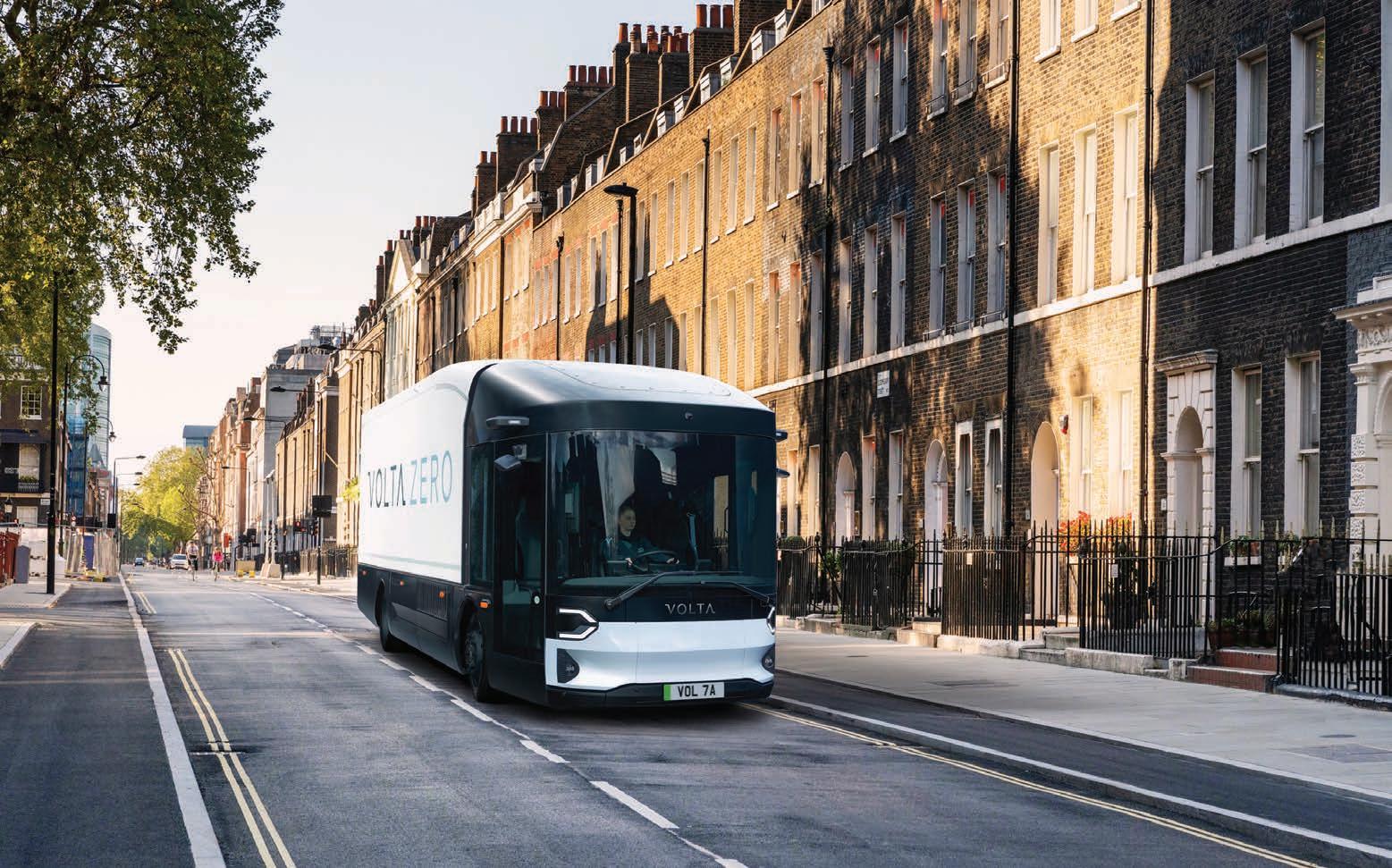
Additionally, the project contributes to the EIB’s objective for Sustainable Transport and Climate Action hence is in line with the Bank’s lending objectives and Transport Lending Policy.
“To receive the validation and support from the European Investment Bank is a huge validation of our ambitious goal to become a European champion of fleet electrification,” said Chief Executive Officer of Volta Trucks, Essa Al-Saleh. “We are confident that our Truck as a Service proposition, which the EIB is supporting, offers
fleet managers a frictionless and hassle-free way to electrify their fleet, and the EIB loan will accelerate this considerably.”
Founded by Carl-Magnus Norden and Kjell Waloen in 2019, Volta Trucks makes the claim that it has the world’s first purpose-built all-electric 16-tonne vehicle designed for urban logistics. That vehicle, the Volta Zero, has been designed from the ground up as a viable alternative to help reduce the environmental impact of freight deliveries in city centres. Its reported operating pure-electric range stands at 150-200 kms. To date, Volta Trucks has raised over €360 million funding to date.
DELIVERY NEWS 108 december 2022
$65M BOOST
Volta Zero electric truck.
FEDEX RECOGNISED WITH INTERNATIONAL AWARD

FedEx has been recognised as one of the 2023 World’s Most Ethical Companies. The recognition comes via Ethisphere, a for-profit company that, for a fee, defines and measures corporate ethical standards. As a first time recipient, FedEx is also the only honouree in the Transportation/Trucking/Railroad industry category in 2023. This year, a total of 135 honourees were recognised spanning 19 countries and 46 industries.

“This is a great honour for FedEx, and we are pleased to be among this select group of companies with exceptional compliance programs and commitments to advancing business integrity,” said Justin Ross, Chief Compliance Officer of FedEx Corporation.
“Our FedEx team members around the globe have done an incredible job building and maintaining FedEx’s
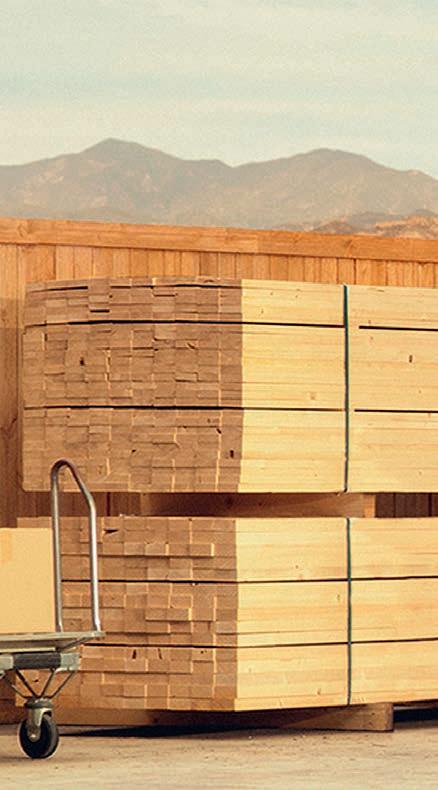
strong culture of compliance and ethics, and we are truly appreciative of this esteemed — and hard-earned — recognition.”
Organisations that commit to business integrity through robust programs and practices, according to Ethisphere CEO, Erica Salmon Byrne, not only elevate standards and expectations for all, but also have better long-term
“We continue to be inspired by the World’s Most Ethical Companies honourees and their dedication to making real impact for their stakeholders and displaying exemplary values-based leadership,” she said. “Congratulations to FedEx for earning a place in the World’s Most Ethical Companies community.”
A parked up FedEx fleet.
DRIVING FORCES
The development of an autonomous electric vehicle platform underpins a new memorandum of understanding signed between Applied Electric Vehicles and Suzuki Motor Corporation.
Applied EV is an Australian technology company with strengths in software and electronics for autonomous ready vehicles. Suzuki entered into an agreement with it in September 2021 before investing in Applied EV in 2022. Ever since then the global automaker has been evaluating the possibility of collaboration.
That moment would seem to have arrived.
In a co-development project, Applied EV’s autonomous vehicle platform known currently as Blanc Robot, will be integrated to the ladder frame of
Suzuki’s 4WD Jimny, electrified by Applied EV and controlled by their central control system, Digital Backbone. Originally designed and manufactured in Melbourne, the Blanc Robot is a cabinless universal ‘turn-key’ solution.
The two companies intend to bring the Blanc Robot to production and develop business models to expand the adoption of autonomous electric vehicles and enhance brand awareness.
Prior to the agreement, Suzuki had made additional investment in Applied EV through Suzuki’s corporate venture capital fund, Suzuki Global Ventures. It’s
now anticipated that the two companies will further strengthen their relationship and promote next generation mobility. Founded in 2015, Applied EV combines heritage in automotive innovation with software development and deep robotics capability. The remit of the company, at present, is to develop safety-rated, autonomous-ready, digital control systems and modular vehicle platforms for commercial applications.
“Our mission is clear — we’re intent on revolutionising transport,” the company said in a statement. “We recognise the need for safer, cleaner, more efficient

FUTURE TENSE 110 may 2023
Julian Broadbent.
transport solutions.”
For Applied EV, this challenge begins with commercial applications, where the impact and opportunity are more profound. The boundaries for its projects, however, extend well beyond to the likes of passenger vehicles and taxis. Its driverless transport solutions are being created with Automotive Safety Integrity Level (ASIL) architected applications with a focus on the automotive and industrial sectors. ASIL is defined by ISO 26262 and is the global standard for functional safety of road vehicles. The standard identifies four levels (A to D), with ASIL D having the highest safety requirements.
Applied EV products are in the process of meeting the functional safety requirements for cargo and industrial applications certified to ASIL D level. The company is aiming to be the first control system provider with ASIL D certification for on-road automated passenger vehicles.
The Blanc Robot, according to Applied EV, is the ‘smartphone’ of autonomous vehicles. In addition to multiple worldwide trials with companies such as The University of Sydney, Australian Centre for Field Robotics (ACFR), Teijin and Ibeo, the Blanc Robot is already being utilised for industrial energy and delivery fulfillment services. Its proprietary AV transport platform is powered by the Digital Backbone, through its combination of state-ofthe-art software and hardware that will control all aspects of a vehicle. The company claims the technology significantly enhances the digital capabilities of electric vehicles, in turn, reducing hardware complexity and manufacturing costs, to optimise the deployment of autonomous driving technology and support the next generation of vehicle architectures to be what it calls

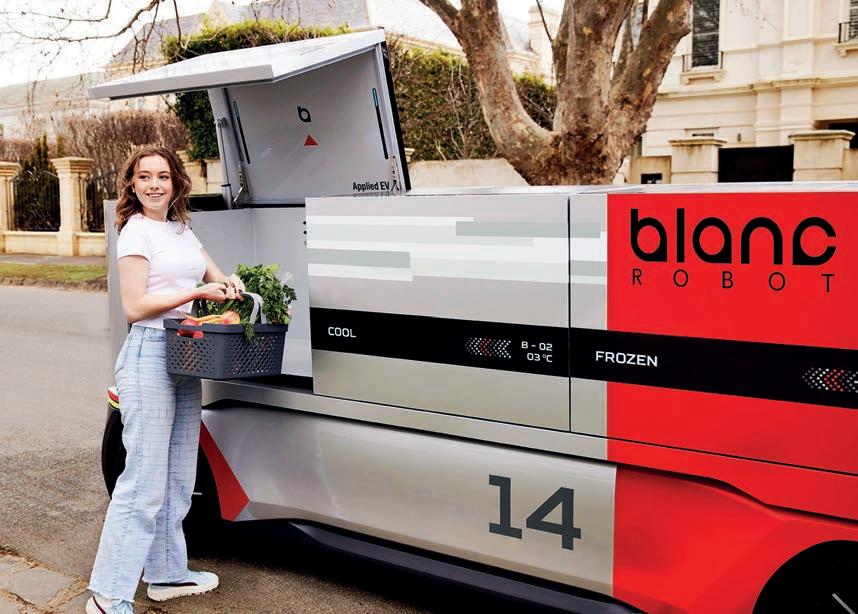
completely Software
Defined — a combination of software, firmware and electronics that enable Level 4/5 automation.
The software will enable programmable and updatable functions across all hardware, under any situation. Designed
for level 4/5 autonomy, the fully redundant systems can interface with any autonomous system. In May 2022, in partnership with Oxbotica, Applied EV conducted the first cabinless autonomous vehicle tested on publicly accessible streets in Oxford, UK.
“The Digital Backbone is functionally unique as it can be integrated into any traditional EV vehicles, or into our modular Blanc Robot platform,” says Applied EV CEO Julian Broadbent.
“In turn, providing an ‘application-ready’ Software Defined Machine with the ability to service limitless industrial transport applications.”
to drive lower costs and strong margins through scale.
Applied EV also expects reduced hardware content will lead to a reduction in the overall vehicle cost.
“Through the relentless pursuit of our mission, continual product improvement and global collaboration, today, we’re proud to call ourselves leaders in the field of autonomous vehicles, transport and software development,” Applied EV says in a statement.
Eventually, the technology is going to be offered to the broader market and will be applicable to any vehicle, from cars and trucks to industrial machines and
deliverymagazine.com.au 111
Blanc Robot.
Applied EV’s cabinless universal ‘turn-key’ solution in action
Iwas recently looking at the NTARC (NTI) safety report for 2021. I often look at the NTARC series of reports to educate myself about Australia’s heavy-vehicle safety in Australia. One statistic knocked me over. The proportion of large loss claims involving “roll over while tipping” is about 5 per cent.
As shown in the report extract below, this category does not capture rollover incidents caused by driver error. The actual number of rollovers is greater than 7 per cent of NTI’s large loss claims! The report estimates that about 1 in 400 trucks will be involved in a large-loss insurance claim in any one year. So the rate for ‘roll over while tipping’ is 5 per cent of 400, which is 1 in 8000 insured vehicles. Just how many tip-trucks and tip trailers are there operating in Australia? A few years ago, ARTSA-i Data analysed the bodies on trucks and trailers that were registered in the NEVDIS database. The results showed about 7.5 per cent of trailers have the term ‘tip’ in the description. For rigid trucks the percentage was about 16 per cent. In total about 5 per cent of the registered vehicle fleet has a tipping function. So, I conclude that each year, about 1 in 400 insured trucks with a tipping function will be involved in a large-loss insurance claim involving roll over whilst discharging the load of either the truck or connected trailer.

The NTARC safety report also identifies the jurisdictions where the ‘roll over
Are you getting the most from your trailers?
while tipping’ events occurred. An estimated 39 per cent of the incidents occurred in Western Australia and most occurred within a 50km to 350km radius around Perth, WA. Wow! A quick Google search shows that only about 10 per cent of active mines in WA are within 350km of Perth, so this is not a mining industry problem. NTARC identified the
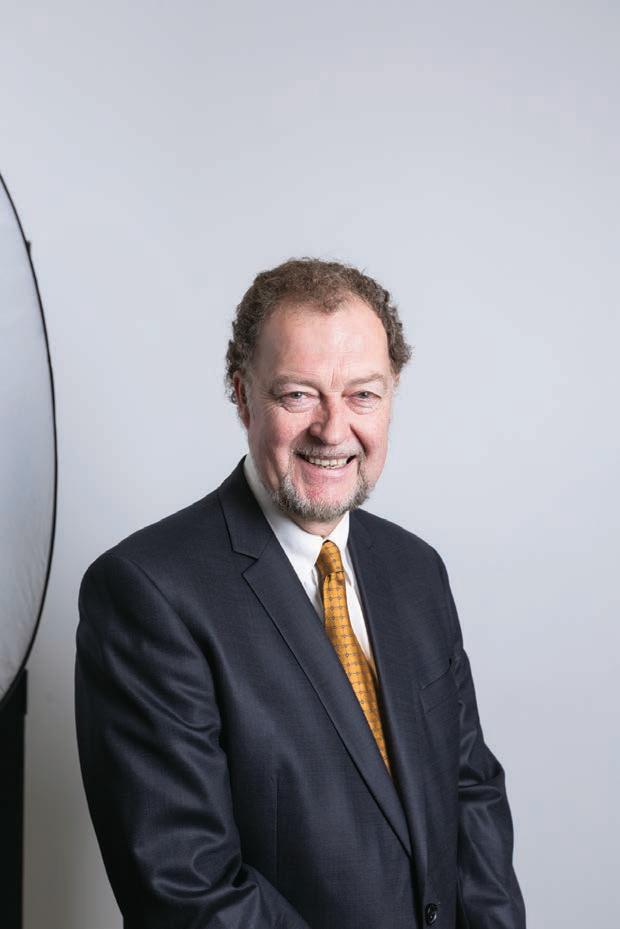
contributing factors as:
• dense (ie heavy) and sticky loads;
• the length of tipping bodies on semitrailers; and
• lack of torsional coupling between units due to the 50mm pin coupling on semi-trailer dolly trailers. I think this means the semi-trailer separated from the dolly trailer during the roll
112 december 2018 INSTITUTE
may 2023
NTARC 2019 data.
PETER HART
over event. Note that a dolly trailer is not roll coupled to the towing vehicle so the torsional loads cannot be passed forward.
Add to that: long bodies (4-, 5- or 6-axle dog trailers or 14.6m semi-trailers); cross slope exceeding 5 degrees; over-zealous lifting of the body; moving of the vehicle with the body raised; sticky load, soft and uneven surface and high wind. There are no stabiliser legs for tip-trailer -they are dangerous machines. Clearly the NTARC is concerned about the length and weight of loads on semi-trailer tippers. If a dolly trailer is involved, then the incident must have occurred on a combination vehicle.
Indeed, NTARC is very clear about this. Around Perth, “these losses all involved
multi-combination tippers carrying fertiliser/soil conditioners for agricultural use, predominantly lime sand.” This safety problem seems mainly to exist in the agricultural sector. It may not be surprising to lean that many areas within a radius of 350km of Perth are recognised as poor because of soil acidification. But there are other regions in Australia with acidic soils. Many are in NSW and Victoria, also. Lime sand sticks so the load can be very high during tipping. I started thinking about how the trailer EBS (TEBS) system on tipping trailers might be able help a driver to assess whether it is safe to tip. Since 2019 most new heavy trailers had to have a Vehicle Stability Control (VSC). This is an ABS with a roll stability program (as a minimum). The roll stability program protects against roll over during cornering, not tipping. The main trailer TEBS (another name for ABS + VSC+ intelligent brake control) suppliers can now provide enhancements that help the driver avoid ‘tipping-rollover’. For example, the TEBS contains a lateral accelerometer. An electrical output can be programmed that is true when the cross slope exceeds a pre-set value. This can be used to halt the PTO operation. A separate output feature can be programmed to come
on if the trailer is driven off with the body raised. TEBS unit may be able to control the air suspension (if fitted) and lower the bag height in preparation for tipping. Occupational Health and Safety regulations require that the rollover risk while tipping be controlled. Every tip-trailer with TEBS should have these interlocks installed.

The safety features are there for the asking. It would be difficult in court to argue that you forgot to ask!
More generally, the TEBS unit can be interrogated via a trailer mounted Information Module to report the history of roll stability interventions. For example, the Knorr Bremse Trailer Information Module (TIM) is shown below. Comparable units can be obtained from the other major suppliers Wabco and Haldex. The TEBS information can also be downloaded to the service workshop computer via a cable connection. The TIM information screen can also show the trailer mass via a calibration involving the air suspension bag pressures. It can also report wheel temperatures and tyre pressures on sensed wheels. I wonder how many operators are learning from their trailer EBS modules? I suspect it is only 10 per cent.
Dr Peter Hart, ARTSA-I Life Member
Key Points:
• ADR 38/05 has required a Vehicle Stability Control feature with an ABS on new trailers (“TEBS”) since 1 July 2019.

• The TEBS has programmable features that help tip-trailer owners from rollover during tipping.
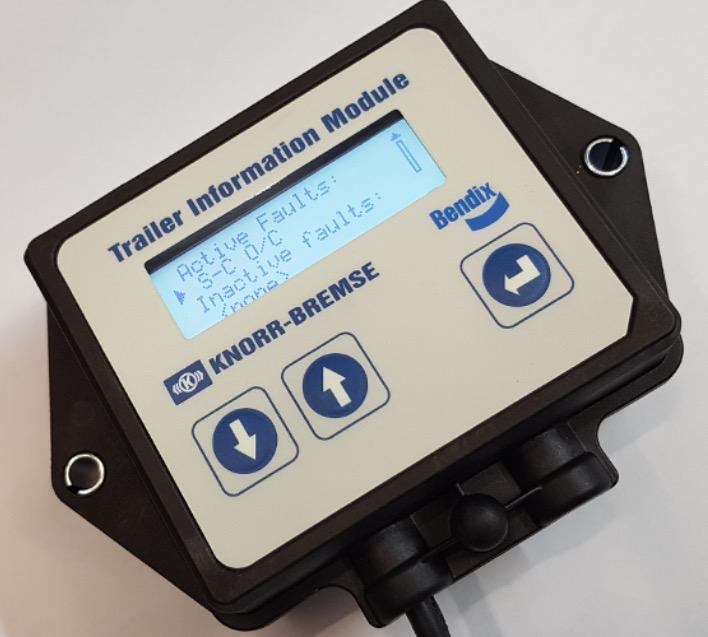
• In a court, it would be hard to defend not applying these safety interlock features.
• The TEBS can report a lot about the road performance of the trailer. The information is available virtually free of charge.
primemovermag.com.au 113 ARTSA-I LIFE MEMBERS Powered by news COMMERCIAL ROAD TRANSPORT
Long tip trailers are vulnerable. Intervention and fault event readers are available for all Trailer EBS systems.
The recent back-flip by the European Union (EU) of its proposed banning of sales of new ICE (Internal Combustion Engine) vehicles by 2035 is a prime case why governments and regulators, should not attempt to pick winners when it comes to technology and technological solutions for industry.
The EU made its original decision to ban sales of new ICE vehicles by 2035, presumably based on social pressure and/or ill-informed advice. The automotive industry’s voice was largely ignored, well at least initially. As the legislation to ban ICE vehicle sales was being developed, one prominent EU country, Germany, realised that the impromptu ban would scuttle several promising zero emission vehicle technologies. Germany, followed by a number of other EU countries, including Italy, Poland, Bulgaria and the Czech Republic, objected to the proposed ICE ban. Together, these countries forced significant changes to proposed legislation, that saw the original ICE ban melt away. However, the carbon abatement outcome of the original plan has been retained.
So how did such an ill-conceived plan eventuate in the first place, why did the plan unravel and what is the EUs new position on ICE-powered vehicles?
The original European plan to ban the sale of new ICE engine vehicles by 2035 was developed in June 2022 by the
The European ICE ban just melted
European Commission and had initial support from all EU parliaments. The proposed new rules would not mean that all cars on the road have to produce zero CO2 emissions by 2035. The draft plan did not affect existing cars. If a consumer purchased a new ICE vehicle prior to 2035 they would be able to drive it until the end of its lifespan. But, because the typical life span of a motor vehicle in Europe is 15 years, there was a need to start the exclusive sale of new zero emission vehicles in 2035 in an aim for all cars to be CO2 neutral by 2050. However, the plan limited new vehicle sales from 2035 onward to be only battery, or hydrogen, electric. Vehicle manufacturers objected to this, arguing that other technologies could also provide a carbon neutral transport solution. In particular, ICE engines powered by green hydrogen and renewal fuels. Further, vehicle OEMs pointed out that the EUs grand plan was most likely unachievable, with the pathway to mining enough raw materials to manufacture only battery, or hydrogen, electric vehicles by 2035, as yet unknown. While plans for the electrical power generation and the transmission grid expansion that would be required across Europe to support the peak demand for recharging the number of battery electric vehicles that the original 2035 zero emission plan would spawn was also unidentified by European governments.
The German Government saw that the issues raised by industry were valid and that the original proposal was technology limiting and Germany, along with some other concerned EU countries
argued for an alternate plan. A plan that would be driven by outcomes and not by specific technologies.
The new plan that was agreed to by the 27-nation European bloc in late March 2023 now acknowledges the broader benefits that renewable fuels can provide, both across the existing vehicle fleet as well as new ICE powered vehicles, with the potential of significantly reducing road transport sector CO2 emissions. The final plan ended weeks of discussions following the pushback by Germany and some other EU countries, who rightly pointed out that the original proposal was technology limiting. The key element of the bloc’s new climate plans is that 2035 will mark the start of sales for 100 percent zero emission vehicles and new fossil fuel vehicle sales will be banned. This means that battery electric, or hydrogen fuel cell vehicles will need to be sold beyond 2035. However, the changes to the original plan will now also allow the sale of new ICE powered vehicles that run on carbon-neutral fuels, or ICE engines that even run on green hydrogen. The plan is now about the emission result and not the specific technology required to achieve a zeroemission outcome.
Let this EU about-face be a lesson to governments across Australia, not to attempt to pick winning technologies, but rather set the policy outcomes that they require and let industry come up with a range of technical solutions to achieve those targets.
Tony McMullan CEO, Truck Industry Council
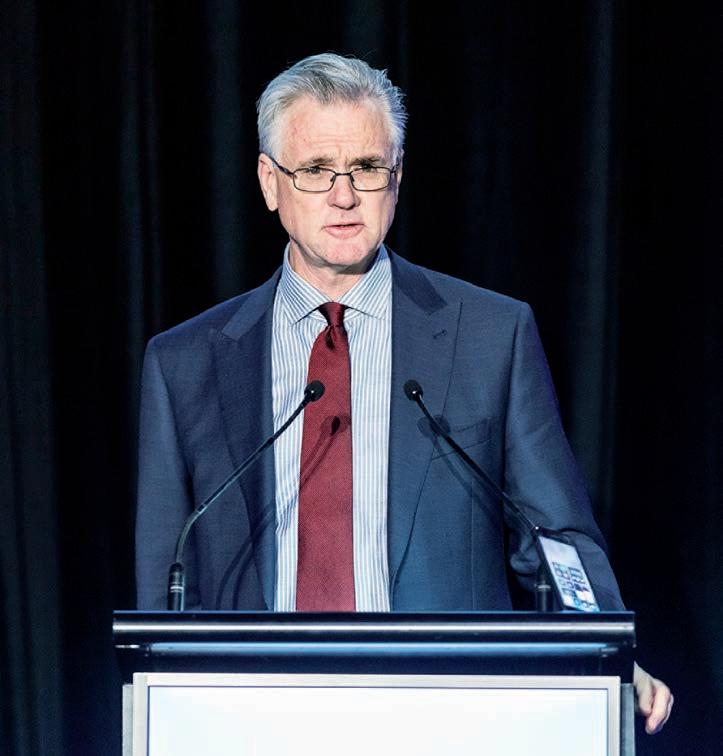
INSIGHT | TRUCK INDUSTRY COUNCIL 114 may 2023
Like many of the state-based road transport associations, the VTA is a proud supporter of the Australian Road Transport Industrial Organisation (ARTIO), a national industrial body that represents the transport industry and its members before the Fair Work Commission.


ARTIO is the only registered employer organisation assigned solely with the representation of employers and prime contractors in the road transport industry, and for over 30 years ARTIO, in conjunction with its state branches, has represented thousands of members in major federal and state industrial cases.
As National Secretary of ARTIO, I was pleased to join a 15-strong delegation of industry representatives in Canberra recently as part of a concerted effort to urge legislators and regulators to enact much-needed transport industry reform. Our delegation brought together unions, employer representatives, operators, and workers, who are united in our common advocacy and passion for reform, and to establish minimum standards of operation, cost, and people management within the road transport industry. Reform is an issue you will hear the VTA and other like-minded industry groups talking about often this year, not least because it is so desperately needed, but because with the same political party now in government in every federal, state, and territory jurisdiction everywhere except Tasmania, there is a
Unlikely allies galvanise for transport reform
unique opportunity for consensus that will deliver the reforms we have been advocating for years.
Our Canberra delegation presented to over 40 ministers and members of parliament of every political persuasion to endorse proposed industry reforms that will improve safety and productivity for operators and transport workers. Much of this was borne out of the excellent work by Western Australia Senator Glenn Sterle, whose 2021 Without Trucks Australia Stops parliamentary report presented ten recommendations upon which unlikely allies like employer and employee representative groups have galvanized, in the interests of making our industry more viable, safe, sustainable, and efficient.
Of the recommendations in the Sterle Report, the VTA particularly welcomed the development of a national apprenticeship scheme to help attract workers to the sector, an expansion to ATSB powers to investigate commercial heavy vehicle road accidents, and the creation of an independent regulator to set minimum commercial vehicle costs. We also welcomed the report’s recommendation for creating an independent body for setting standards, resolving disputes, and establishing binding payment terms, which our delegation rallied behind in Canberra. Such a body would go a long way towards ending the rapid degradation and break down of values and working standards that gig economy ‘employers’ have created through their deployment of technology.
While convenient for some, it is undeniable that gig economy platforms and aggregators over time have reduced payment standards, entitlements and allowances for operators and transport
workers. Any flexibility benefits espoused by their aggregators of working for these platforms are more than offset by low rates, absence of enshrined leave or superannuation benefits, or any collective representation.
Indeed, our Canberra delegation included gig economy workers and their families, who told stories of genuine hardship and even loss to ministers and parliamentarians, as part of our combined effort to enact reform when legislation is presented later this year. These platforms represent a genuine risk to legitimate transport operators that have done the right thing by their customers, suppliers, and staff, only to be threatened by a largely faceless aggregator whose algorithms have no respect for the traditions and conventions upon which our industry was built. And while there may be a place for such businesses in the modern economy, it must not be to the detriment of transport operators and workers, and the minimum standards for safety, productivity, and efficiency they aspire to and deserve.
Now, more than ever, transport customers, operators, workers, representative groups, and even some of the more responsible gig companies are calling for the security of enforceable minimum industry standards.
Our Canberra delegation was united in our efforts to convince parliamentarians to vote in support of legislation later this year that would enshrine this into law. And while this delegation may not aways see eye-to-eye or agree on every issue, our unity in Canberra and on this critical issue going forward demonstrates how important it is for the legislators and the Federal Government to act.
Peter Anderson CEO, VTA
Powered by news COMMERCIAL ROAD TRANSPORT VICTORIAN TRANSPORT ASSOCIATION | INSIGHT
STUART ST CLAIR
PETER ANDERSON
primemovermag.com.au 115
“As someone who works within and around the trucking industry across Australia, I know how important communication is to this huge mobile community.
It is really important to have a voice like Australian Truck Radio – it is just so critical. Anything that can make the trucking industry safer has to be a great thing. Australian Truck Radio is a real winner for the industry.


Trucking is not just a job. It’s a lifestyle that has its own diverse community. It is a great accomplishment establishing Australian Truck Radio to help bring the country together, highlighting important topics for Truckies, including nutrition, which, it goes without saying, is a huge passion of mine.”

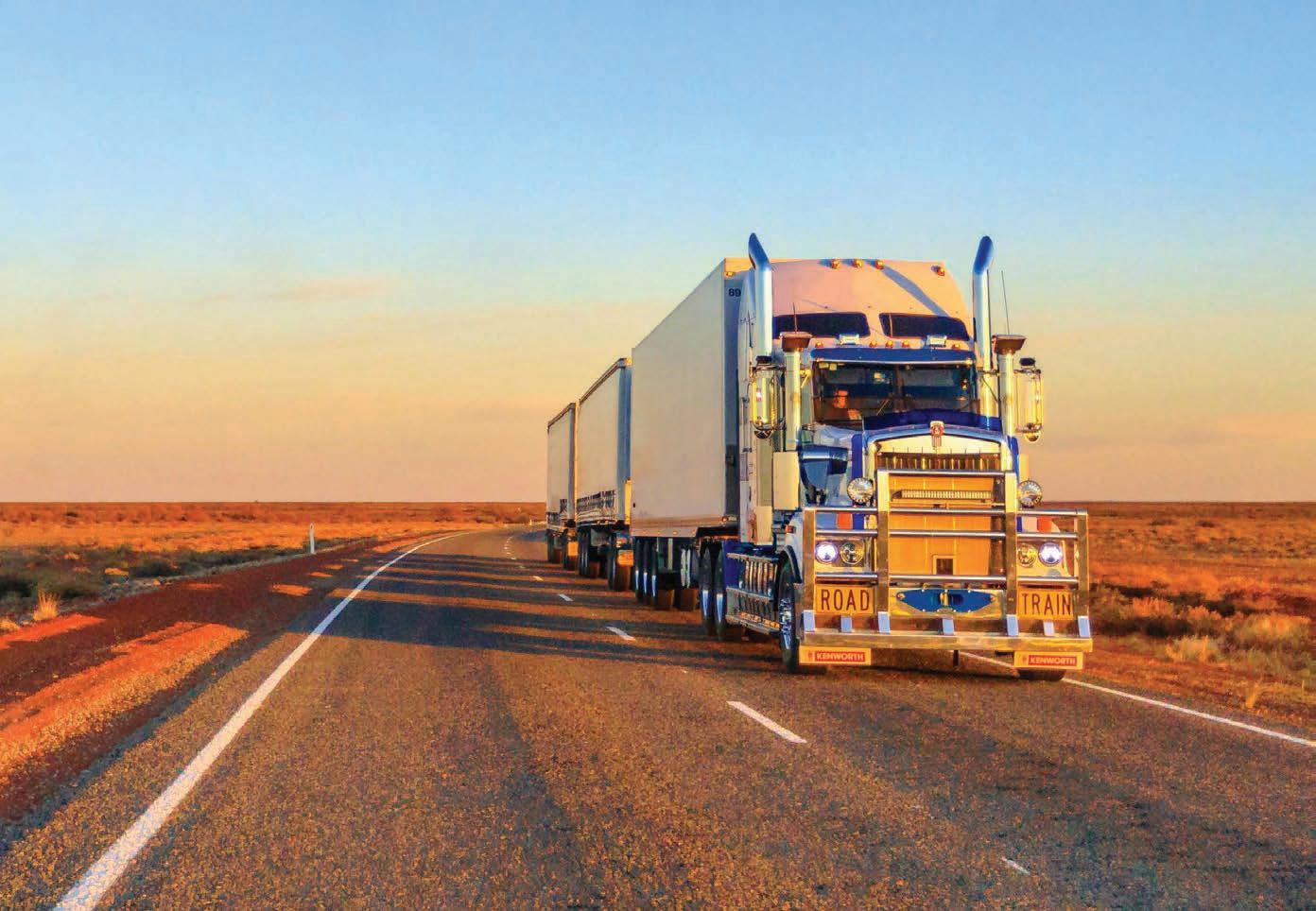
 Tracey
Tracey

Marley Owner, Truckie Nutrition Chick, Facebook Group


For advertising opportunities contact melissa.beutel@primecreative.com.au or call +61 422 103 119
YOUR
24/7 Scan and LISTEN NOW Visit us on www.australiantruckradio.com.au
NATIONAL STATION
reasons why, but in general women often take extended time off work to raise children or care for family and friends. This means they are more likely to be employed in lower-paying jobs, or in casual or part-time roles.
Research conducted by TWUSUPER shows a high proportion of women in transport have low levels of savings and high levels of renting in later years. These factors can have a big impact on retirement income, and at worst it can leave women vulnerable, especially in the case of family breakdowns, illness or job loss.


To make matters worse, women often have to survive on their smaller super balances for longer, with most living four years more on average than men. These factors are perhaps why 34 per cent of single Australian women over 60 live in income poverty and make up a
Super women in transport

large chunk of the nation’s homeless. Apart from changing policy settings, there are things that can be done. Women can employ strategies to overcome some of the hurdles mentioned to build their super balances, which I will cover briefly. oluntary contributions – even small ones – will top up super and make a huge difference later, thanks to compounding interest. And it won’t cost as much as you think, as super is treated very well when it comes to tax. And paying it in as a “salary sacrifice” will even reduce income tax each year up to the annual cap of $27,500.
• There’s also a lesser-known benefit, for partners to make a voluntary aftertax contribution into the super of a lower-income earning spouse or de facto partner. The person making the payment may benefit from a tax offset (reduction) of up to 18 per cent for contributions up to $3,000 per year. Payments above this are allowed, but tax concessions stop at that limit. The income threshold of the lower income partner is $40,000 with benefits tapping from $37,000 where there is a maximum tax offset of $540.
• Money in super is also taxed favourably when it comes to Centrelink asset tests for the Age Pension, so it makes sense for families to maximise the super in both partners’ accounts.
Finally, something I’ve been banging on about is insurance in super – and it’s a topic that impacts many people, and especially women. Insurance included with super as a default, such as death cover and permanent disablement cover (including illness) is designed to protect individuals and families. Sadly, too often I see claims for families – and particularly women – left caring for children alone after a tragedy. It’s awful – and perhaps the only small saving grace is that we can help with an insurance claim that can reduce financial stress at a terrible time. Most importantly, not all super funds cover transport jobs considered ‘hazardous’. Those left uncovered include drivers, forklift operators, and mechanics. This means, when a claim is made, it is likely to be knocked back. TWUSUPER’s insurance covers all transport jobs — so it is fit for purpose. You may want to have a workplace toolbox meeting for your valued staff for which we would be more than happy to help with. If you are in another super fund, talk to them, and you may want to check your insurance cover. If you are a member of TWUSUPER, we can provide further guidance or advice based on your own unique circumstances. Please give us a call on 1800 222 071.
Frank Sandy CEO, TWUSUPER

Powered by news COMMERCIAL ROAD TRANSPORT TWUSUPER | INSIGHT
primemovermag.com.au 117
FRANK SANDY
Getting On the Same Page
units for the month (+5.8 per cent on March 2022) and the quarterly accrual of 1,741 units shows a growth for the year-to-date of 5.4 per cent.
The Heavy Duty sector continued on its astounding trajectory with 1,447 new trucks during March, an additional 202 units more than for the same month last year (+16.2 per cent). The year-to-date result at the end of the March quarter of 3,615 trucks is 603 more than at the same point last year and represents a growth of 20.0 per cent for the category.
Mar-23YTDChange
industry as the entire mainland is now in the hands of the Labor administrations. This result could have some positive implications when the state and territory transport ministers meet to contemplate the review of the Heavy Vehicle National Law as their overall philosophies have a better chance of aligning due to all being part of the one party.
Another benefit for trucks arriving with the incoming NSW Government is the implementation of their pledge to cap the state’s crippling road tolls which have spread like a cancer under the previous coalition State Government. According to Road Freight New South Wales, the new arrangements will cut the average truck toll by $8.00, saving an operator who does two trips per day around $3,800 per year. A review of the toll network and the probable scrapping of an estimated $50 million in administration charges, should also result in some additional financial relief for truck operators and other toll road users.
Normally strong employment figures are regarded as a sign of a healthy economy, but for industries such as truck manufacturing and road transport, which are struggling to recruit and retain staff, the latest Roy Morgan employment data may not be good news. The data shows that the number of Australians who are unemployed fell by 111,000 to 1.41 million (9.4 per cent of the workforce) in March. Employment increased by 57,000 to 13,574,000 during the month. The increase was driven by an increase in full-time employment, up 41,000 to a new record high of 8,990,000 and part-time employment also increased, up 16,000 to 4,584,000.
Despite the shortages of people and ongoing challenges to international and local supply chains, the Australian new truck market recorded a record number of deliveries for the month of March. The Truck Industry Council statistics show 3,683 new trucks and prime movers were handed over during March, along with 491 heavy vans. The truck total for the first quarter of 2023 of 9,135 units is 15.9 per cent above the same period last year.

The Light Duty category contributed 1,510 units, up 5.7 per cent on last March, and the quarterly result of 3,779 is 560 more than for Q1 last year (+17.4 per cent).
Medium Duty trucks maintained their steady growth with 726
PETER SHIELDS’ NUMBER CRUNCH 118 may 2023
ISUZU 1256324032.2% HINO 532 1191-15.2% FUSO 465 11554.0% VOLVO 308 755 65.9% KENWORTH 300 748 15.4% IVECO 155 384 18.5% MERCEDES-BENZ 147 312 25.8% UD TRUCKS 88 273 35.8% SCANIA 93 208 31.6% MACK 88 189 -5.5% DAF 67 164 28.1% FIAT 58 145 -8.2% FREIGHTLINER 27 75 -20.2% HYUNDAI 30 71 47.8% MAN 25 71 -19.3% RENAULT 6 53 10.4% WESTERN STAR 15 43 -41.1% VOLKSWAGEN 14 35 52.2% DENNIS EAGLE 6 15 150.0% FORD 3 4 -63.6% SEA ELECTRIC 0 4 33.3% INTERNATIONAL CABCHASSIS/PRIME3683913515.9% M-B VANS 216 582 62.1% VOLKSWAGEN VANS 147 312 138.2% RENAULT VANS 30 147 -28.6% FIAT VANS 46 134 109.4% IVECO VANS 38 131 129.8% FORD VANS 14 17 -85.6% VANS 491 132341.5% TOTAL41741045818.6%




























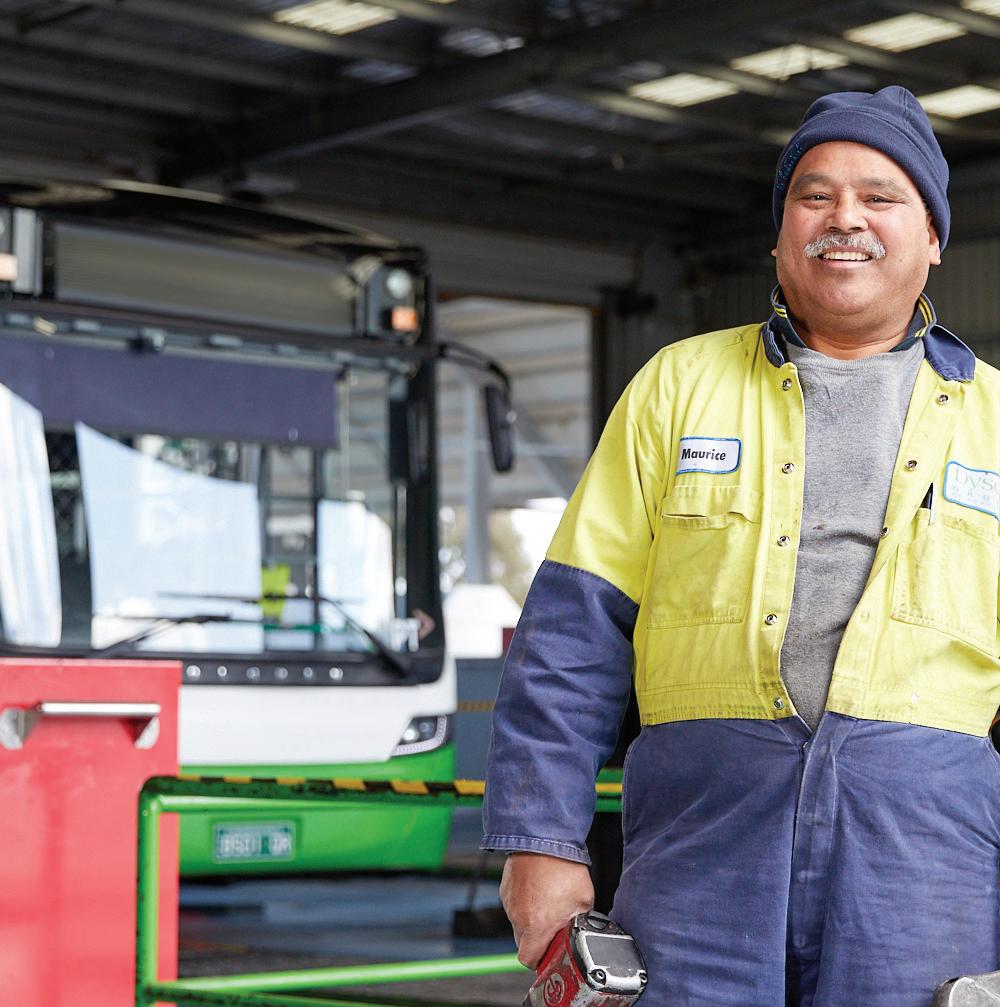


TWU Nominees Pty Ltd, ABN 67 002 835 412, AFSL 239163, is the trustee of TWUSUPER ABN 77 343 563 307 and the issuer of interests in it. TWUS 7267 TWUSUPER offers tailored insurance for our members so they have financial peace of mind should the unexpected ever happen. This insurance protection is available for members young and old in any occupation, even drivers, loaders and forklift operators. Through life’s ups and downs, we’re here to help and support the people who keep Australia moving. Choose the fund that’s got you covered If you work in transport, choose TWUSUPER. Your transport super fund covers ‘dangerous occupations’ Call 1800 222 071 Visit twusuper.com.au/insurance Payments approved by TWUSUPER in 2020-21 $58.5m Many super funds don’t cover dangerous occupations like transport jobs. TWUSUPER is different.
STAY ON THE MOVE SAVE ON THE MOVE WITH

SHELL RIMULA ULTRA

Shell Rimula ULTRA works harder to reduce your costs, with up to 2% increase in fuel economy*, so you stay on the road for longer.
Heavy Duty Diesel Engine Oil

*Compared with a typical 10W-40 oil over a 100,000 km oil drain interval. Scan here to find out more















































































































































































































































































































































































































































 TES General Manager, Paul Lewin
TES General Manager, Paul Lewin













































 Tracey
Tracey









